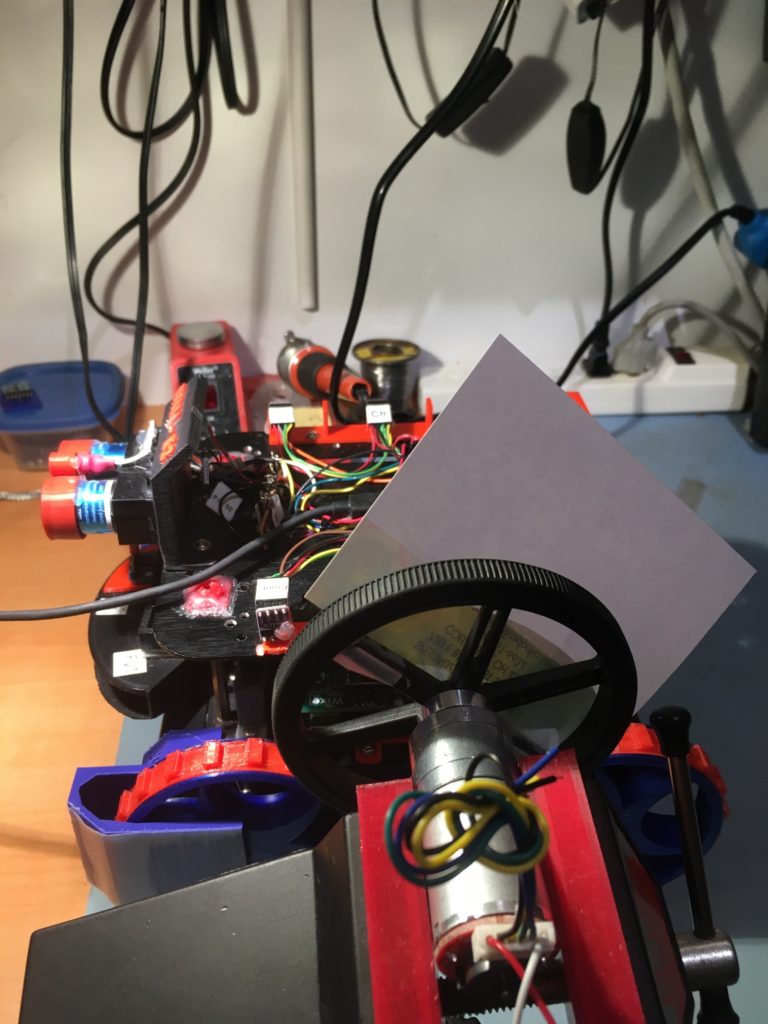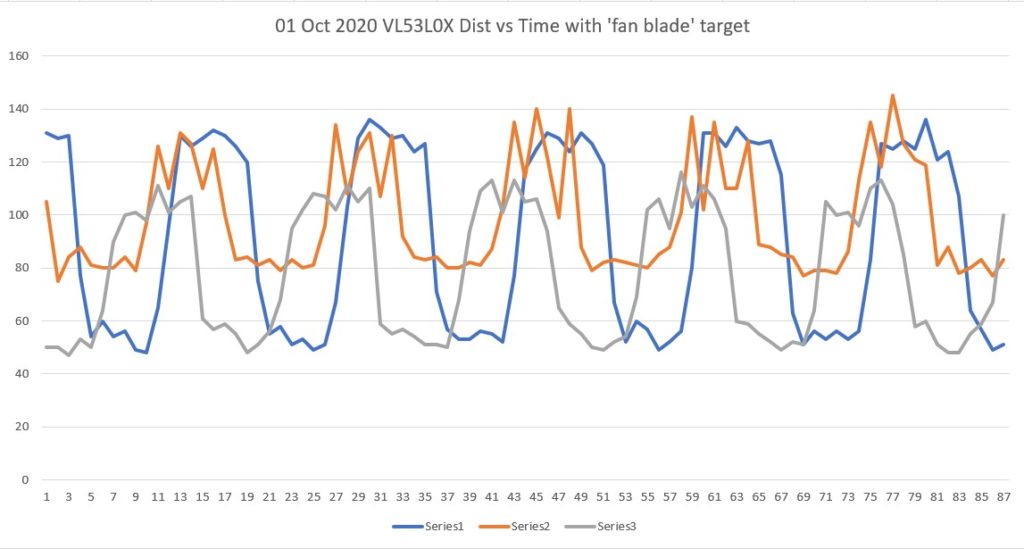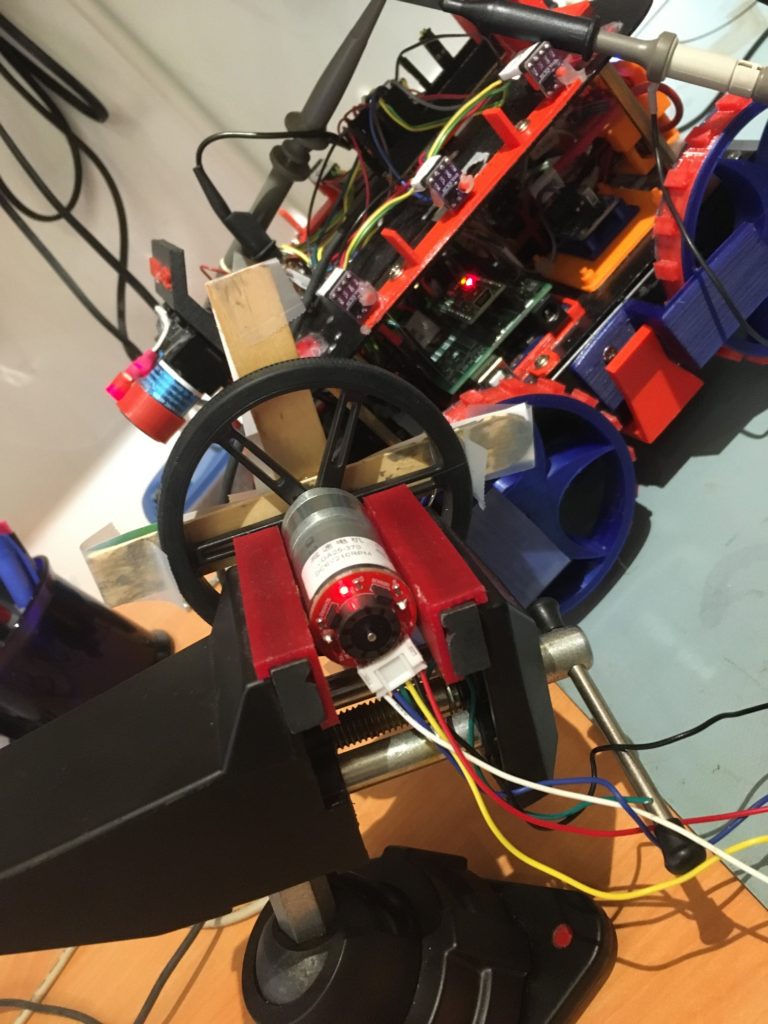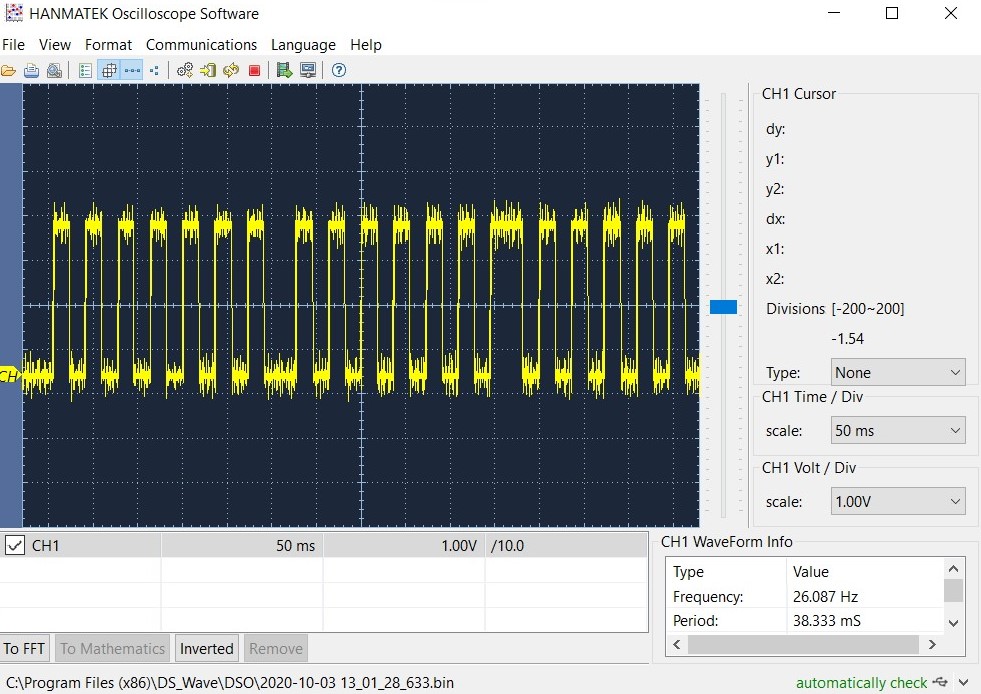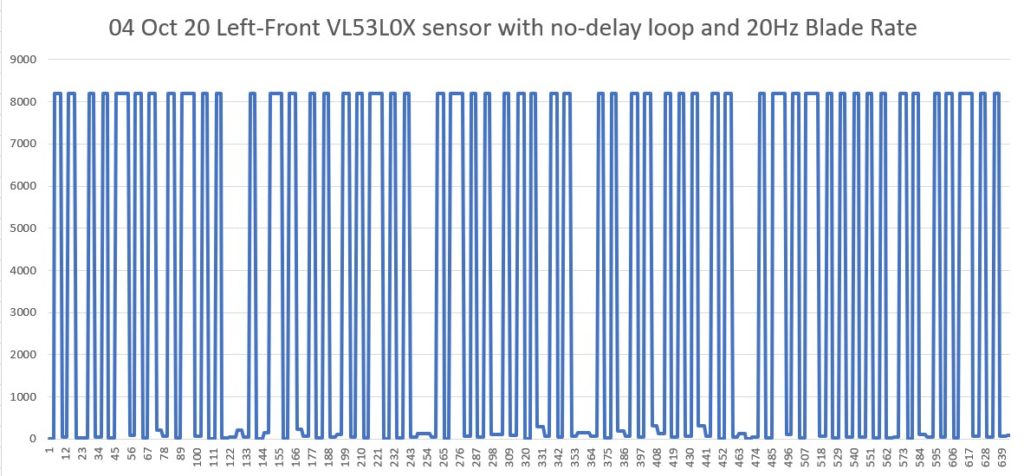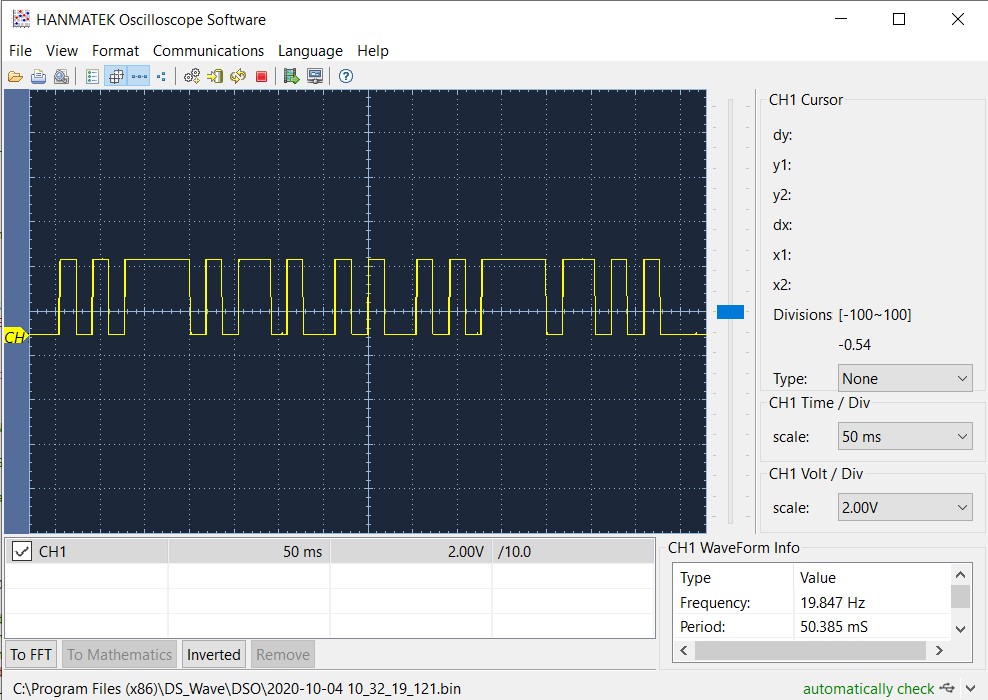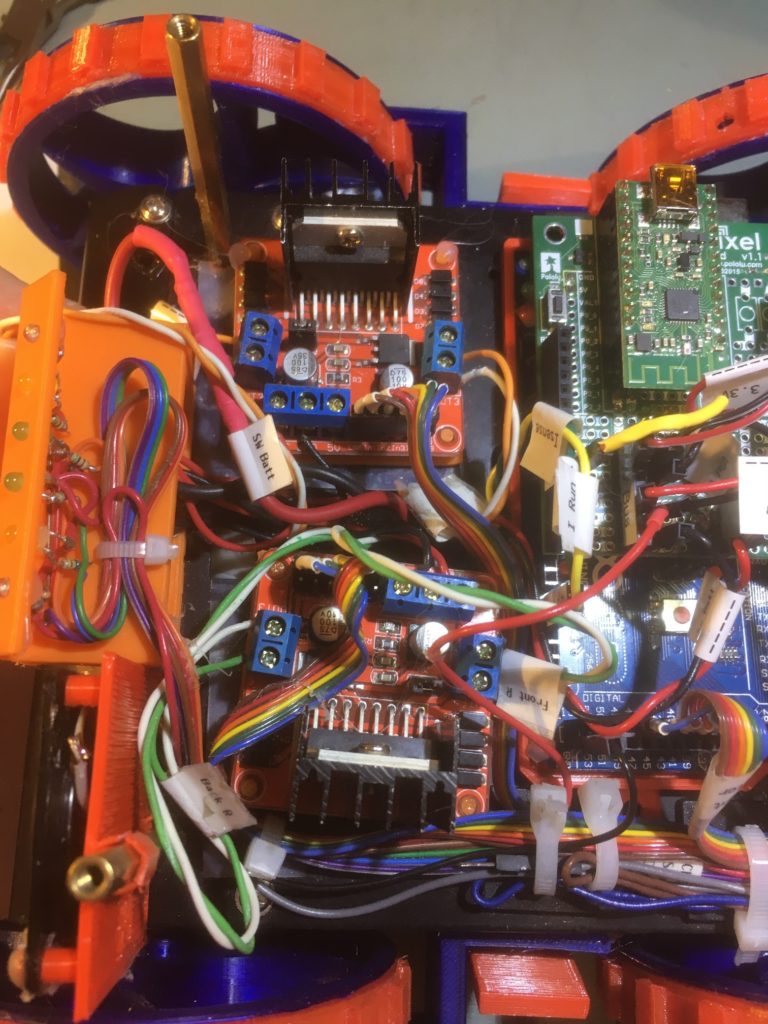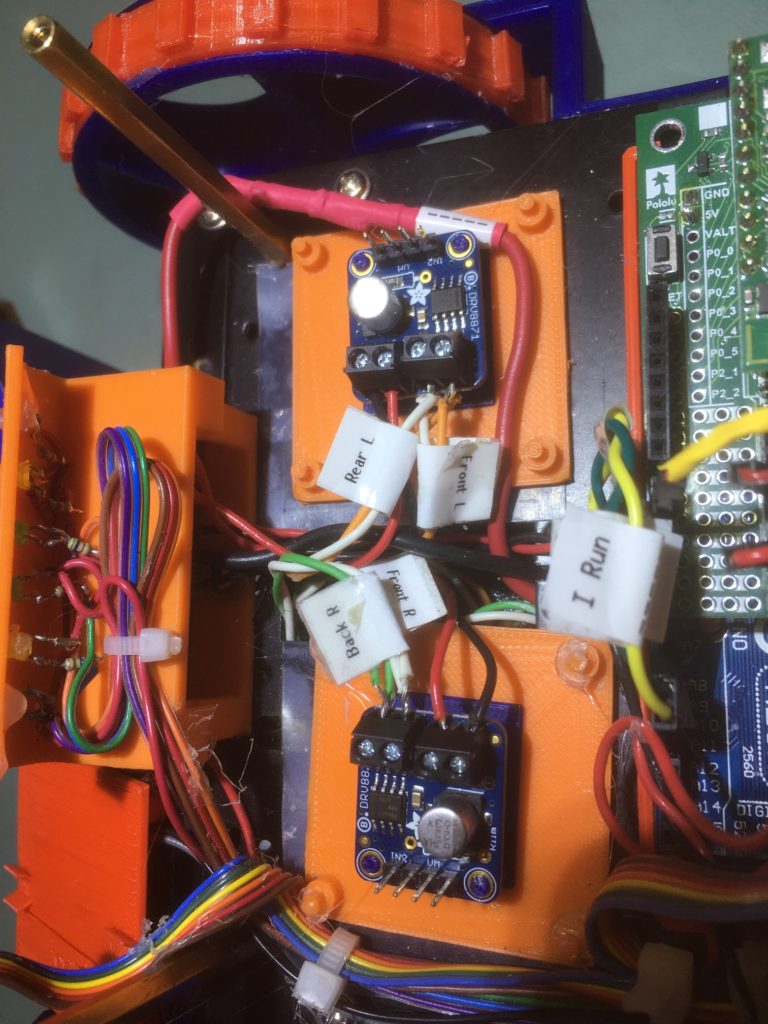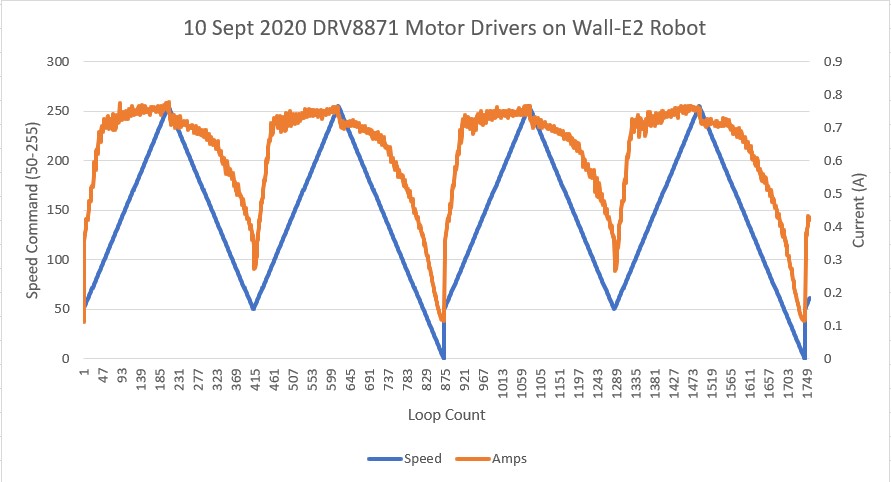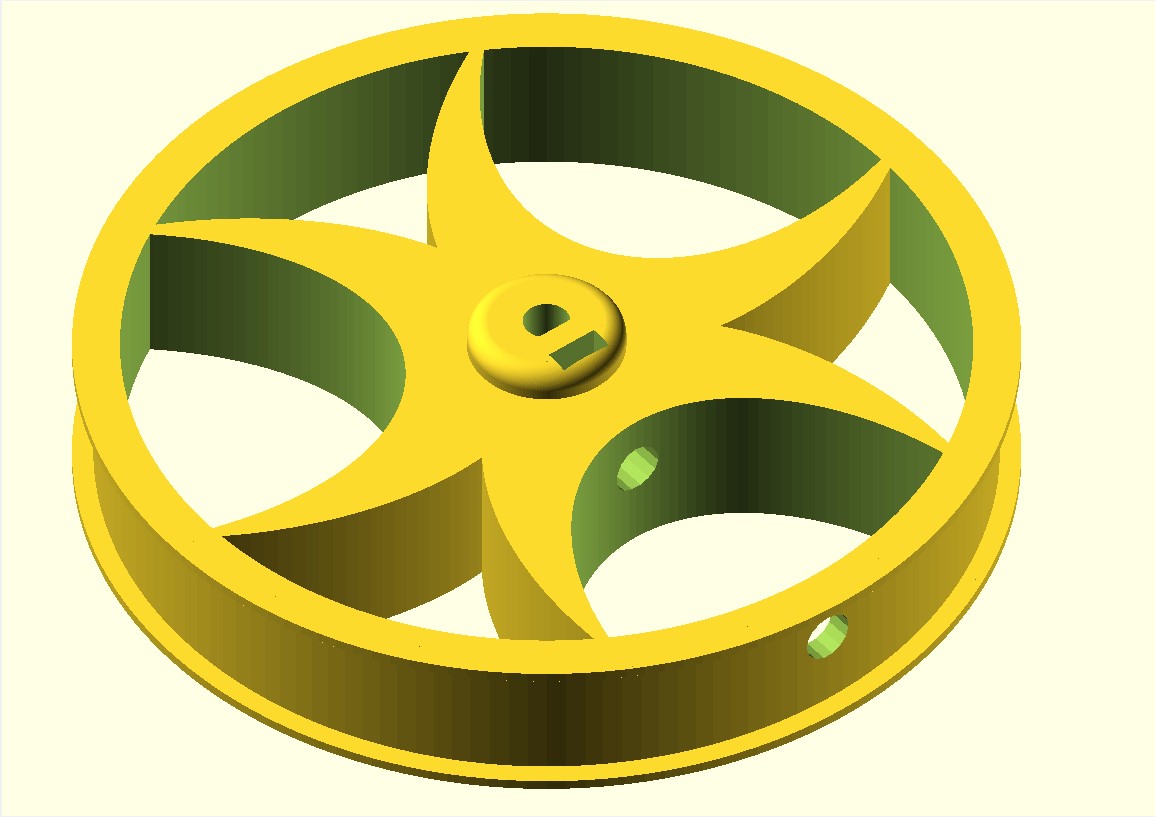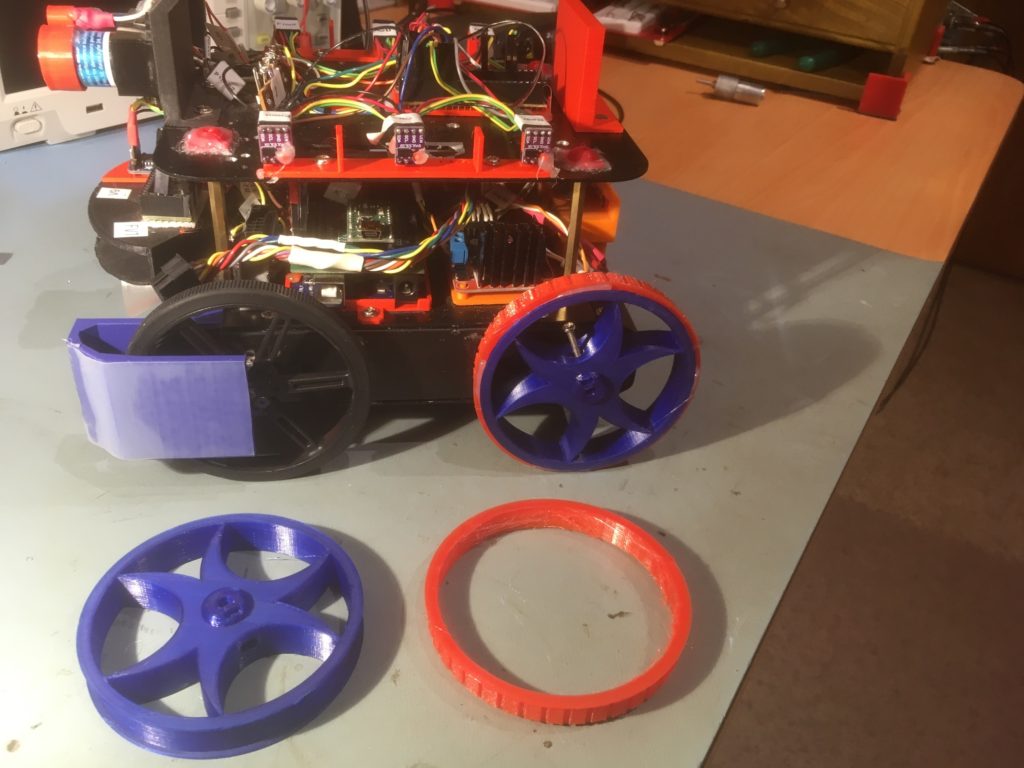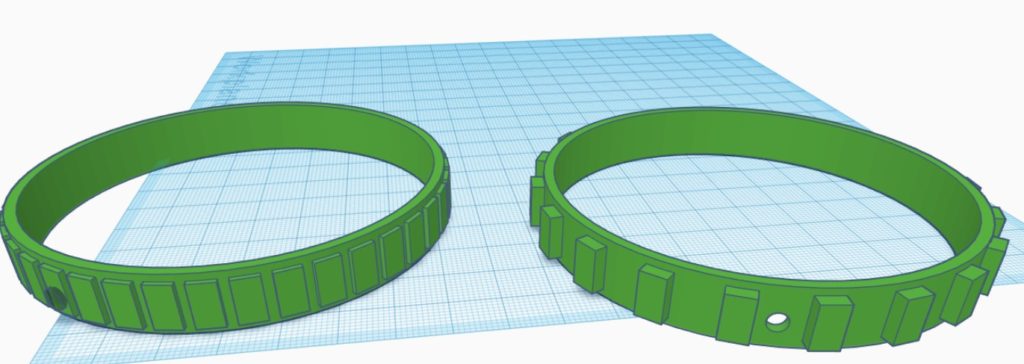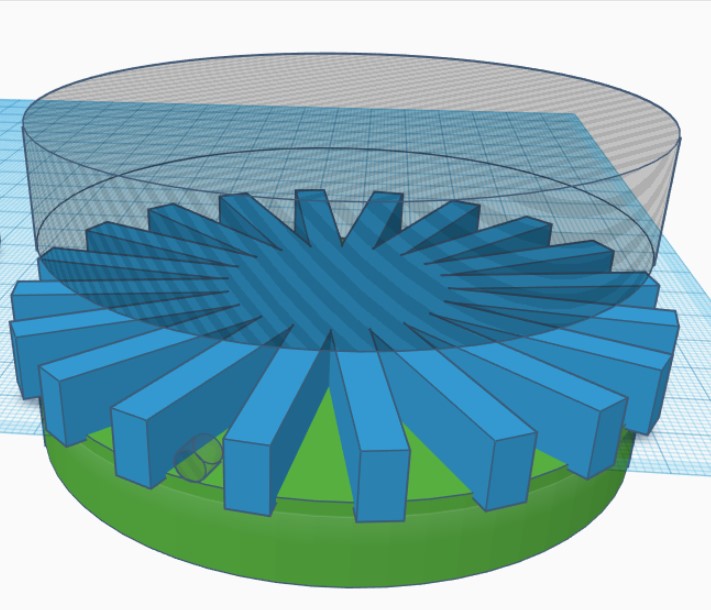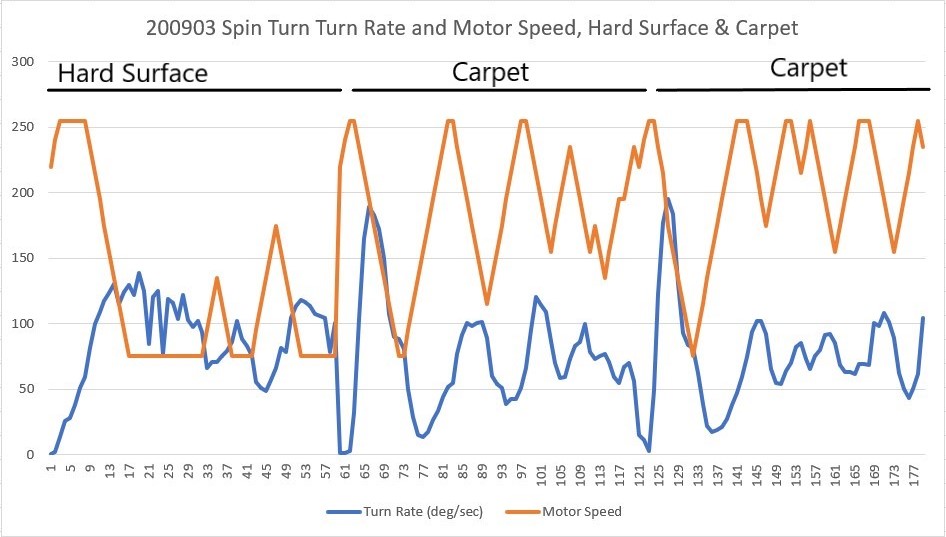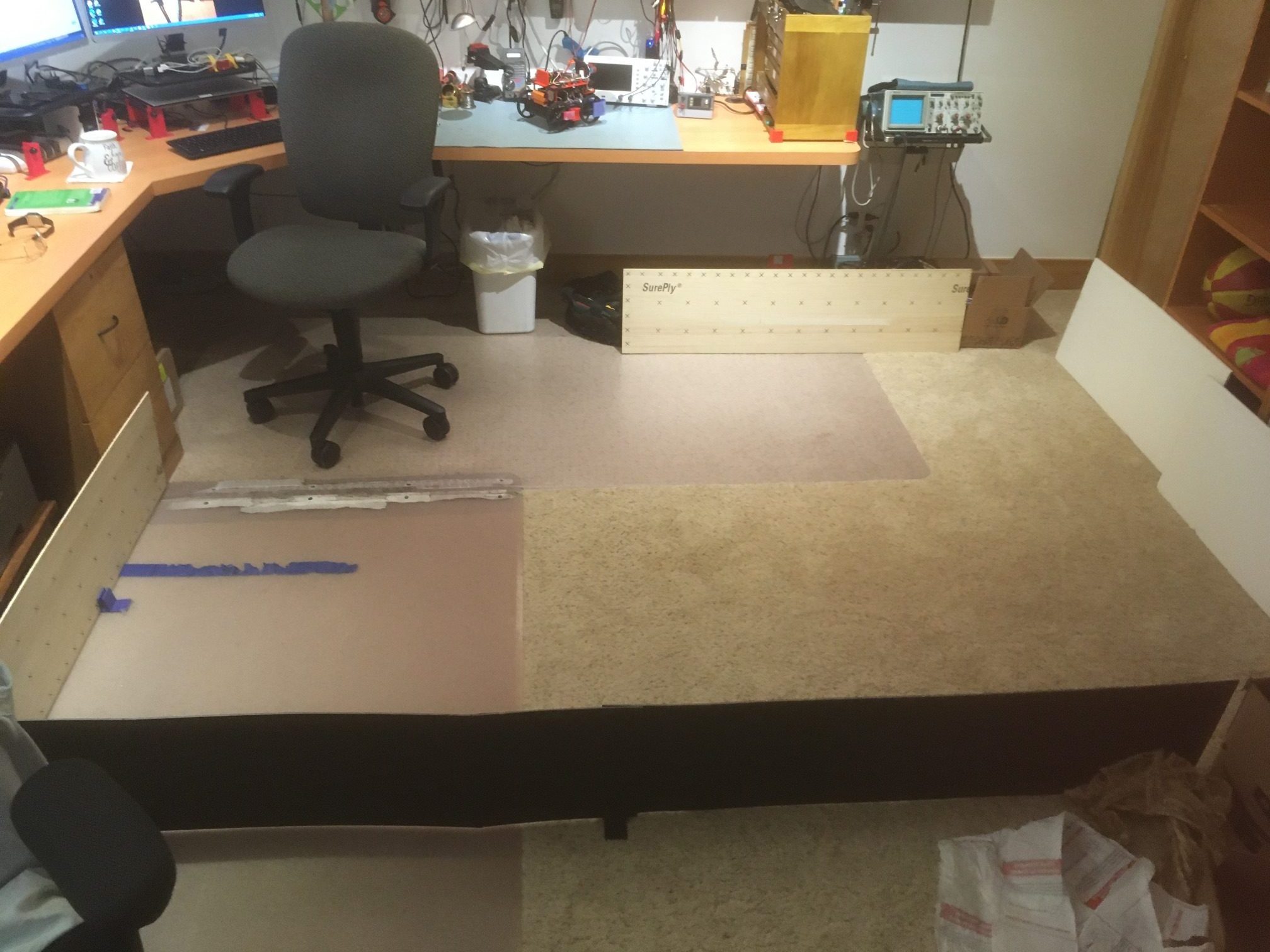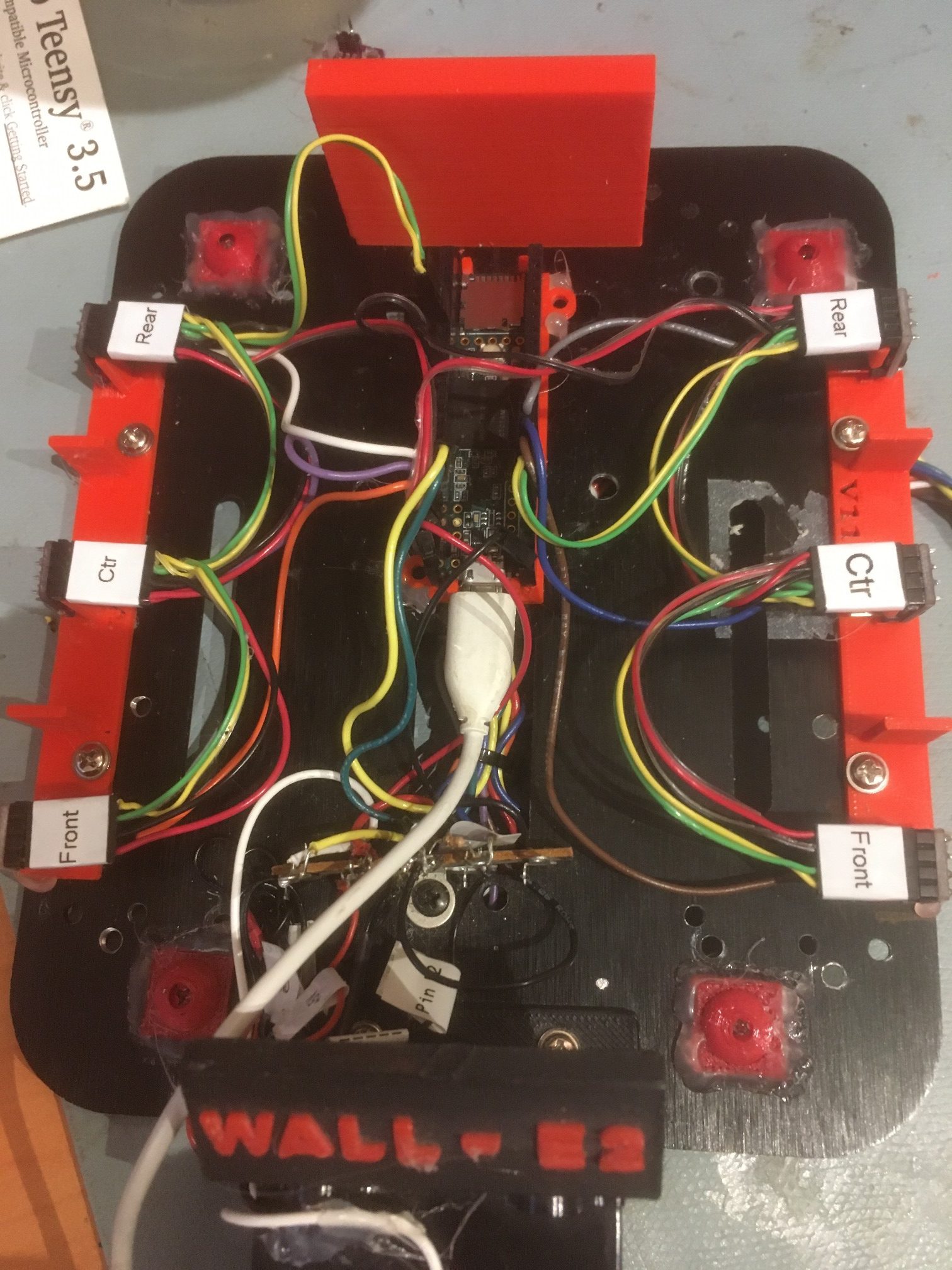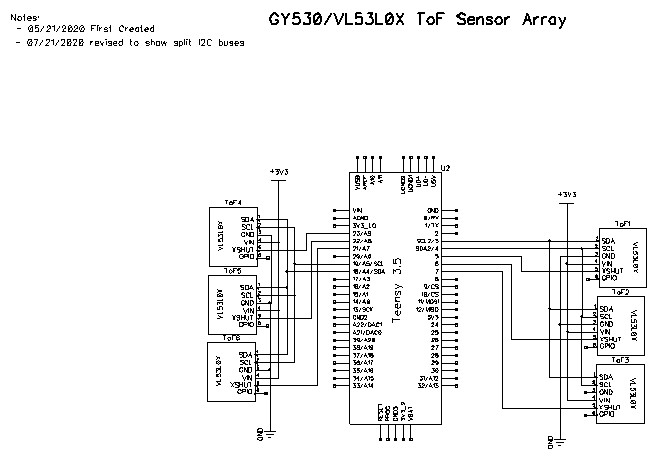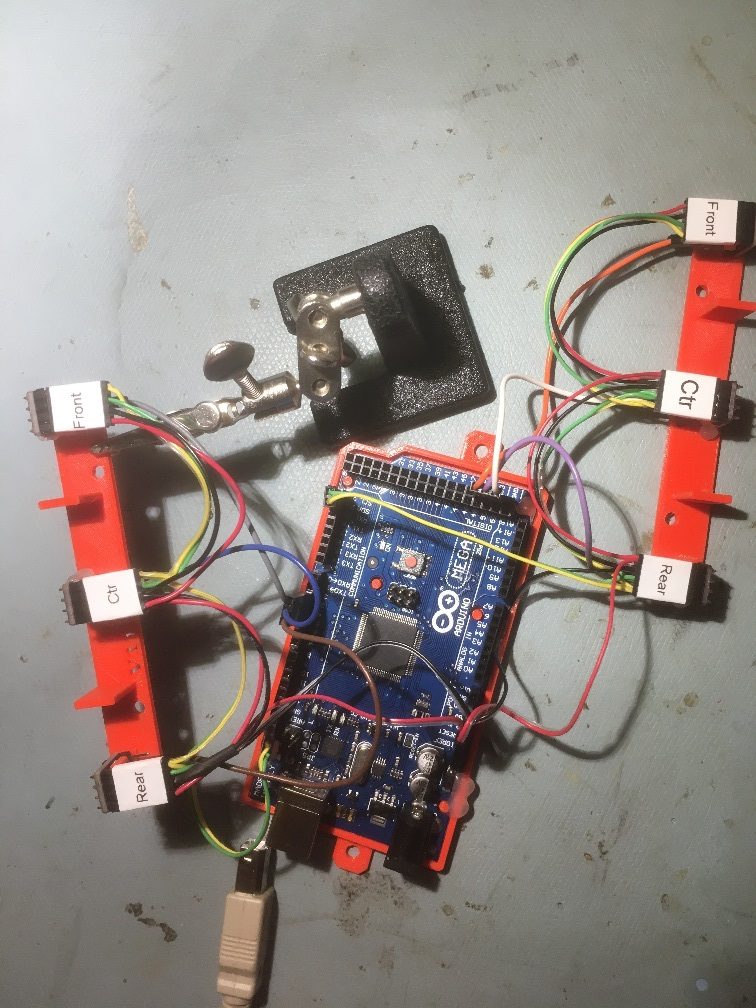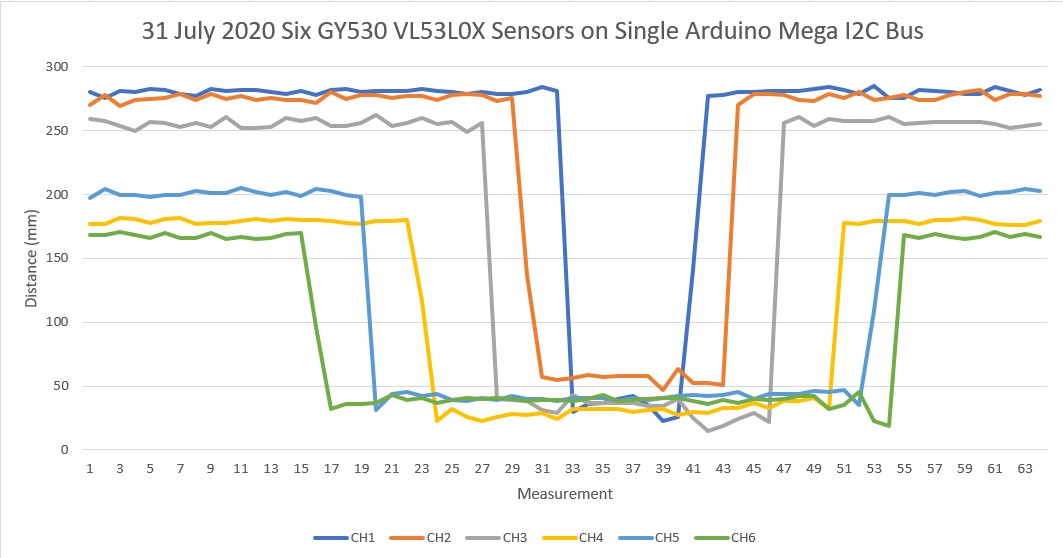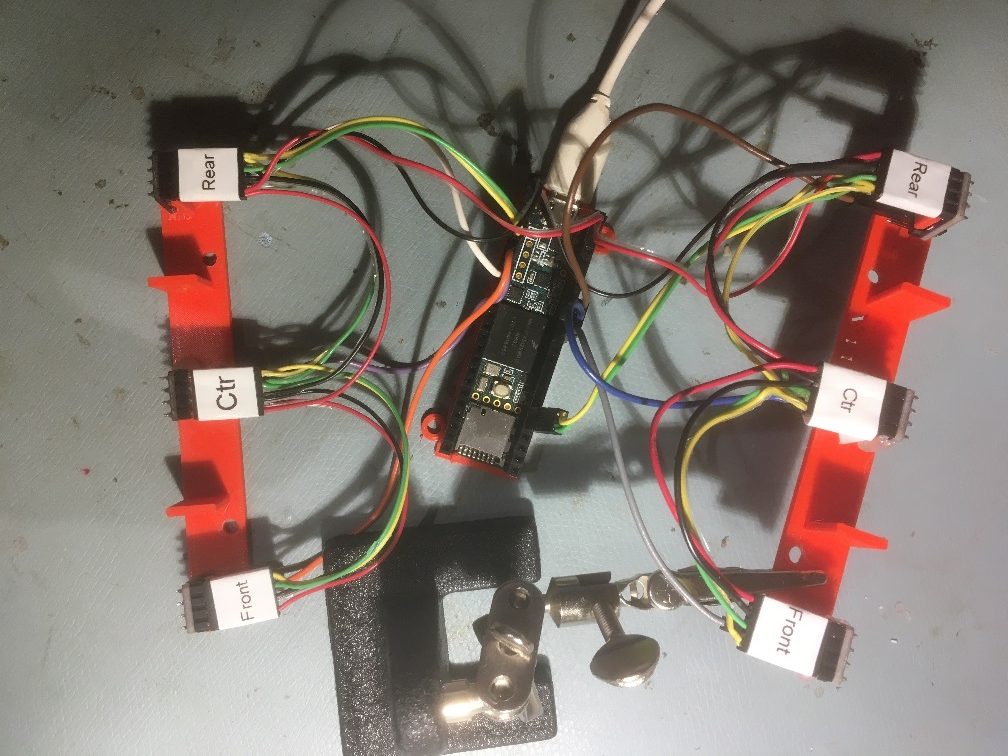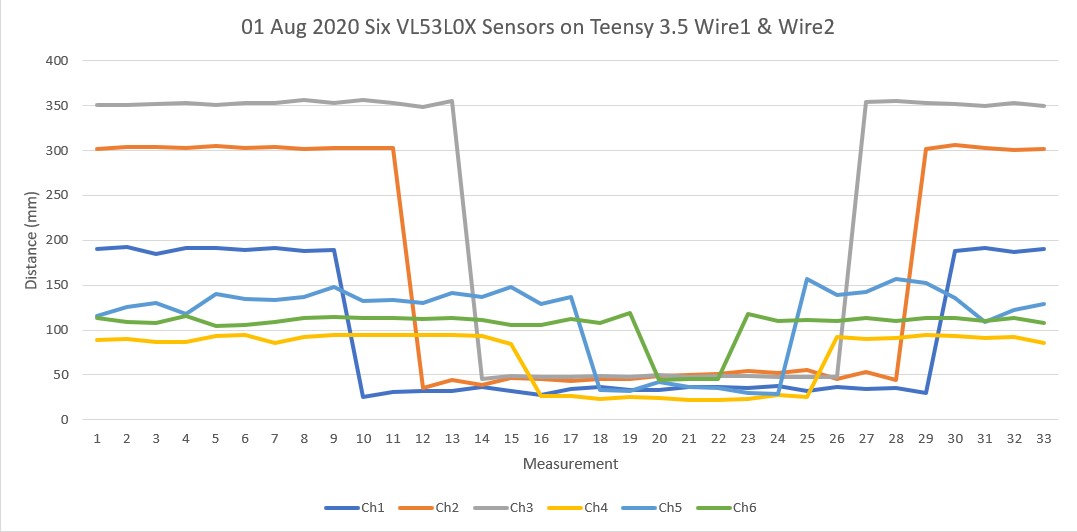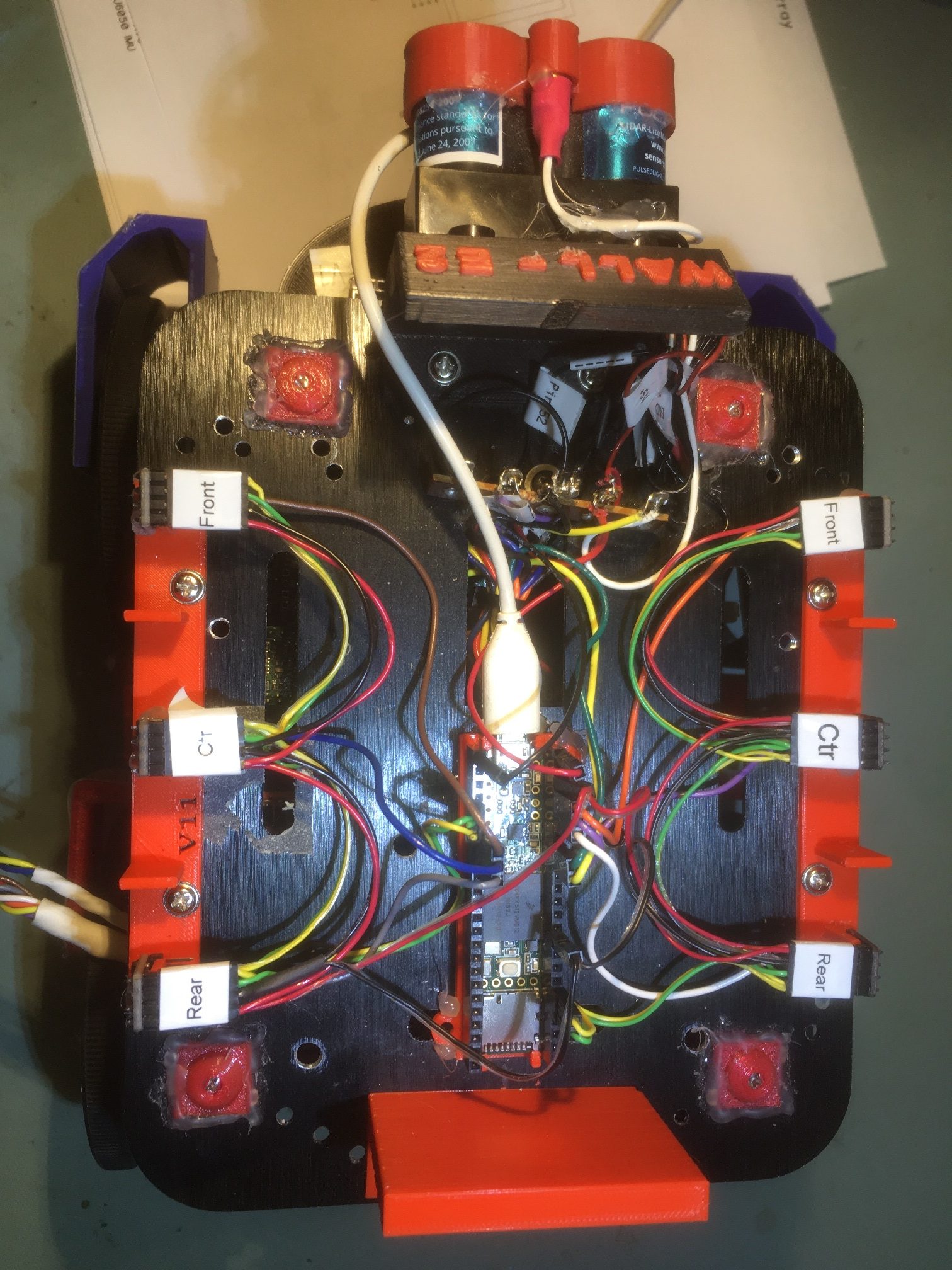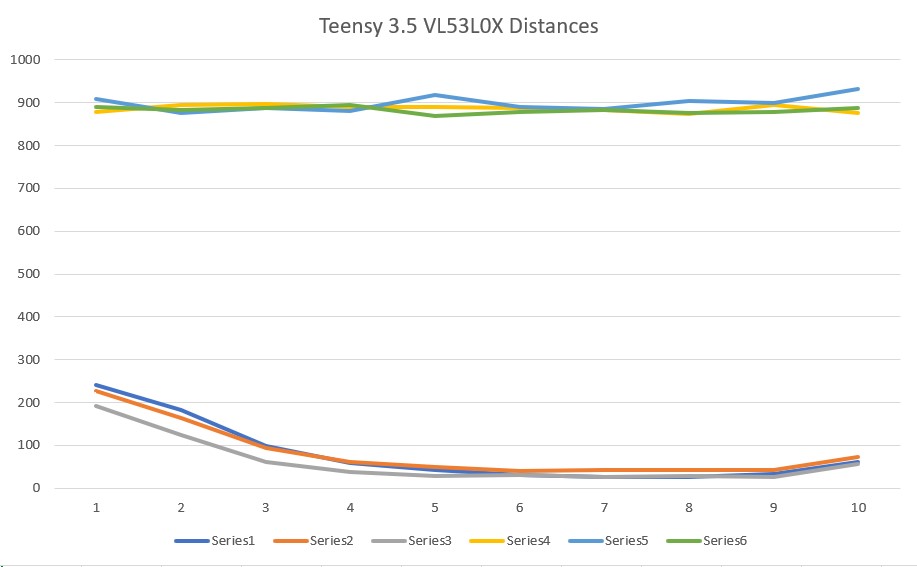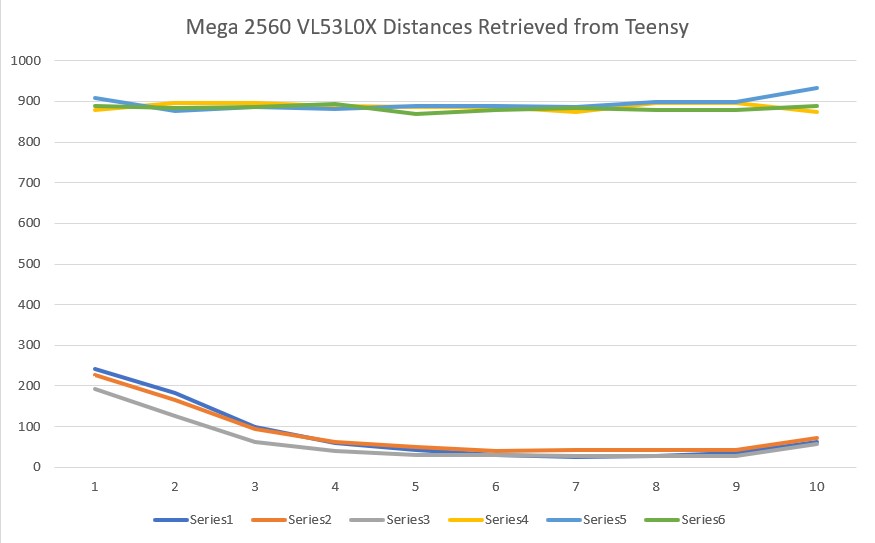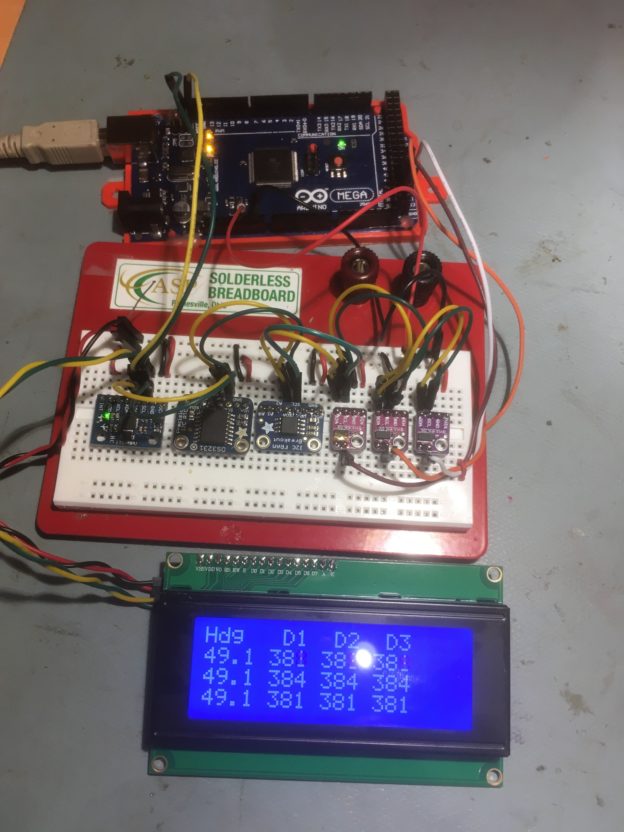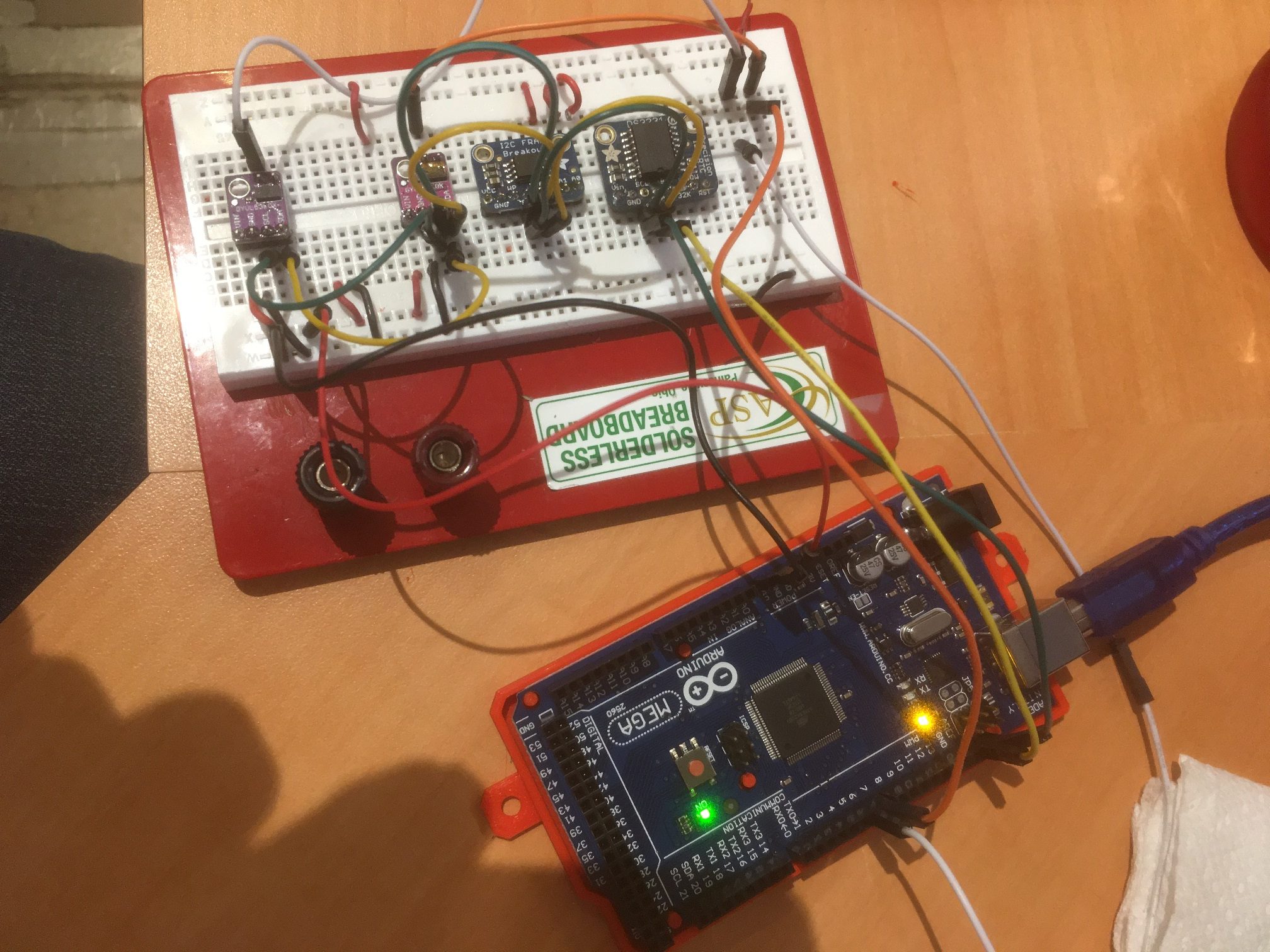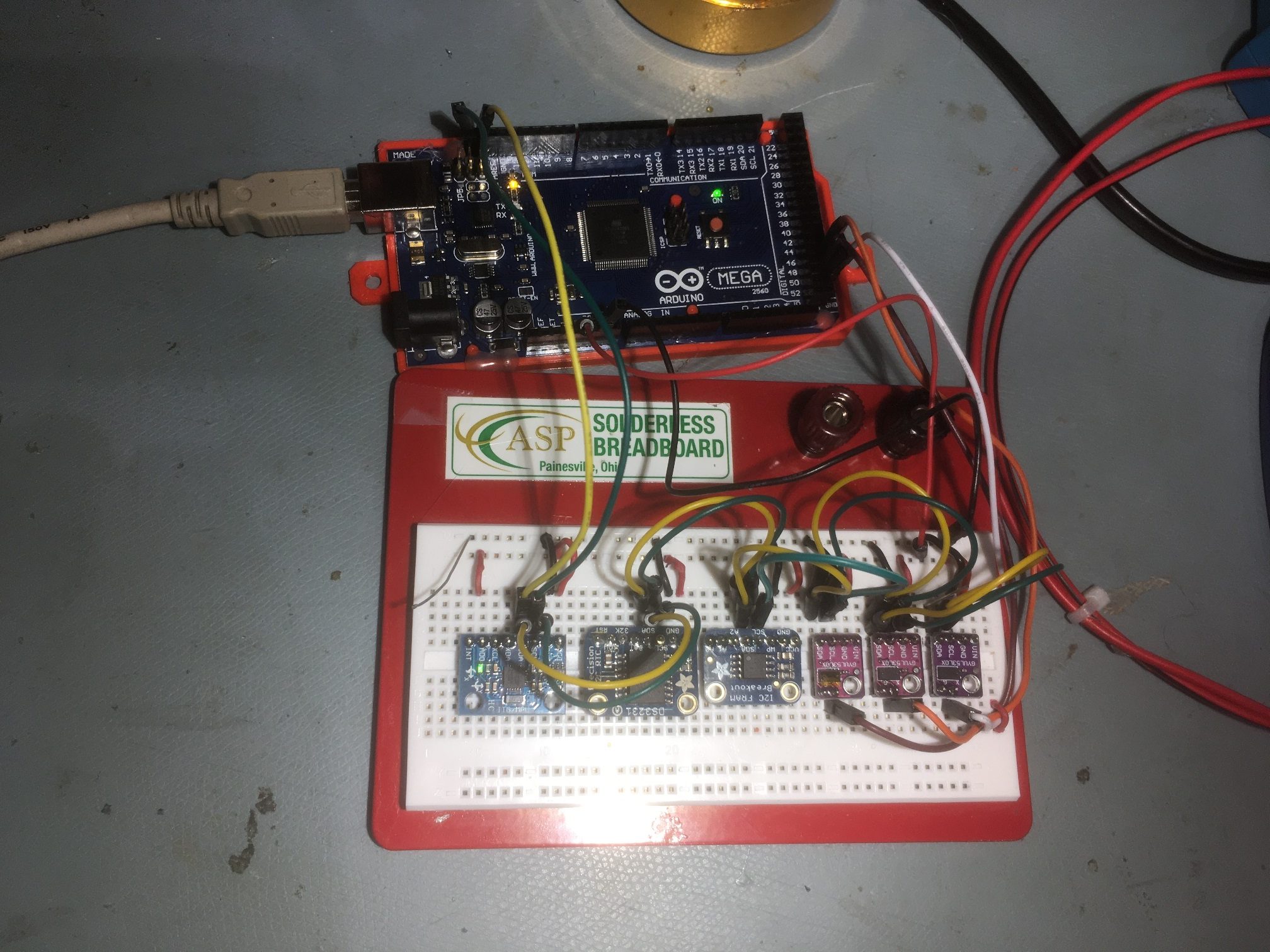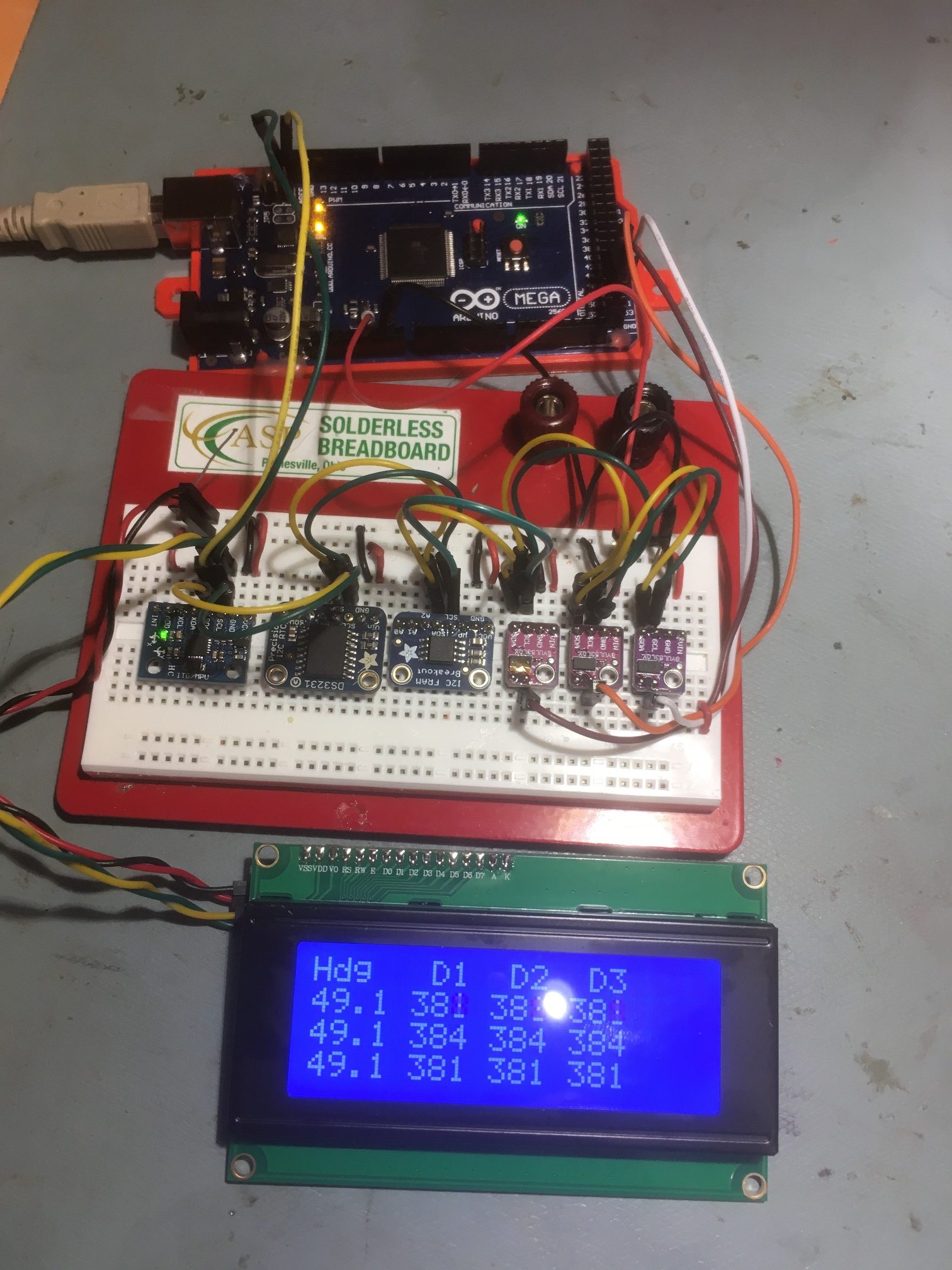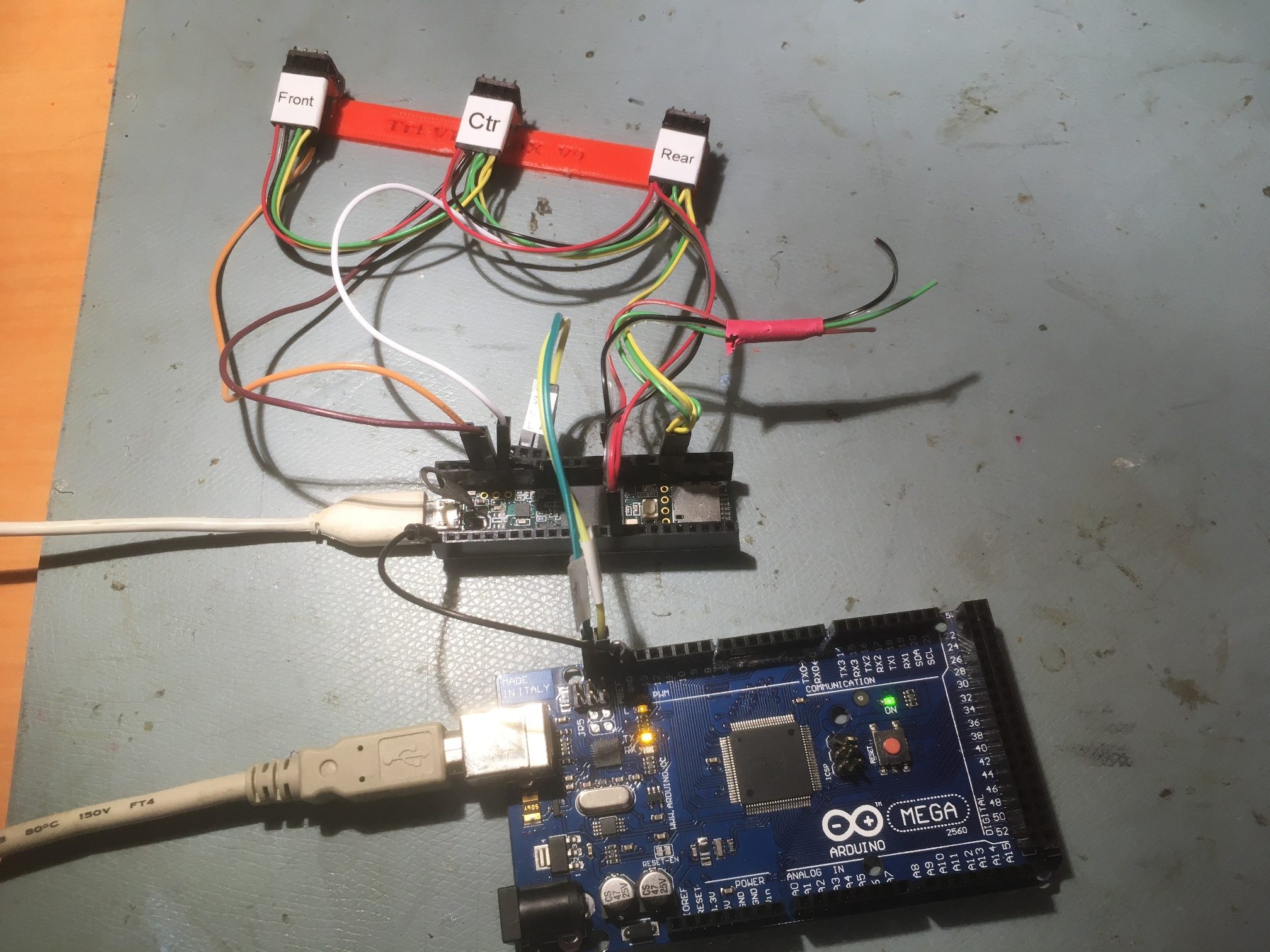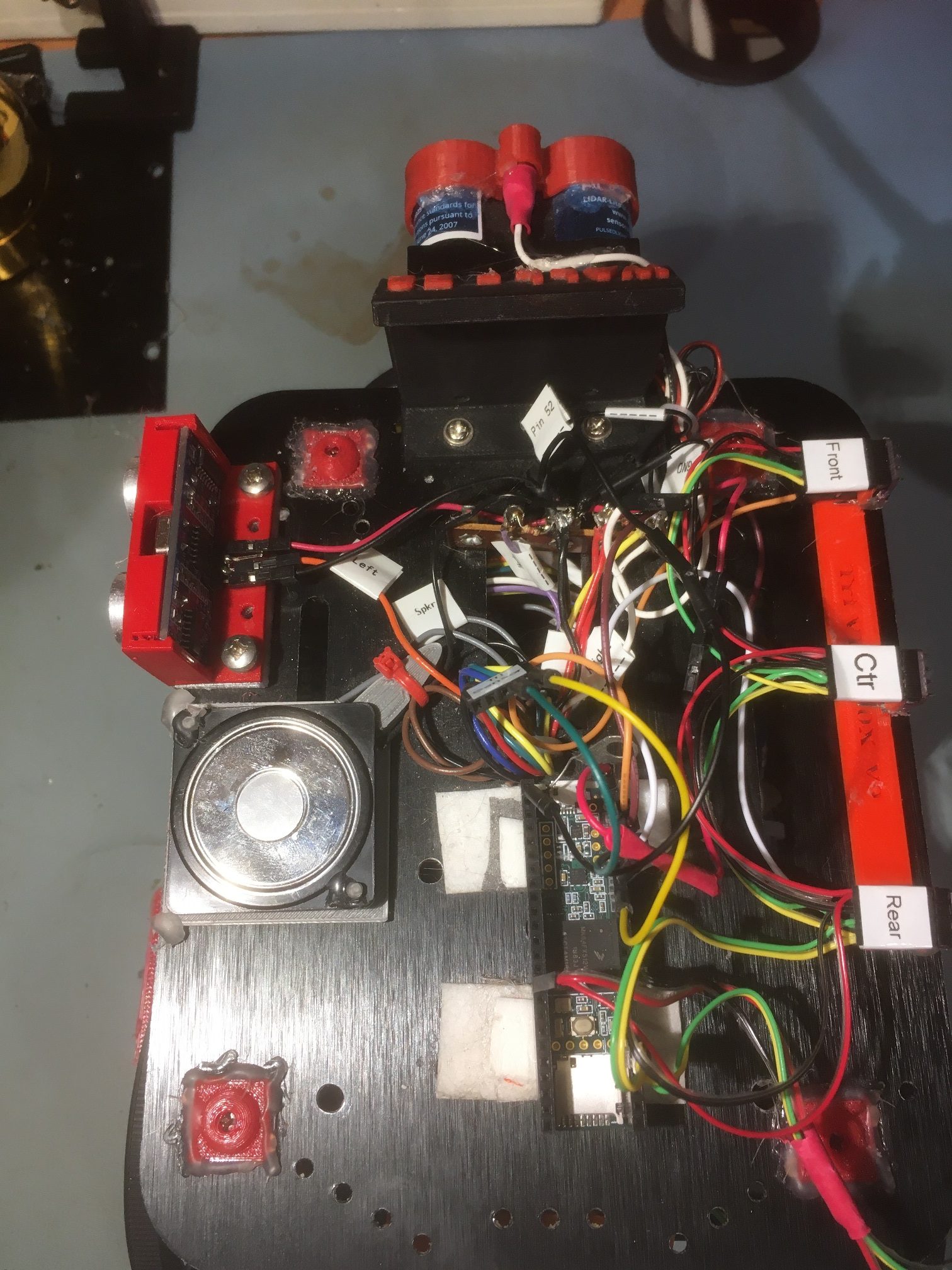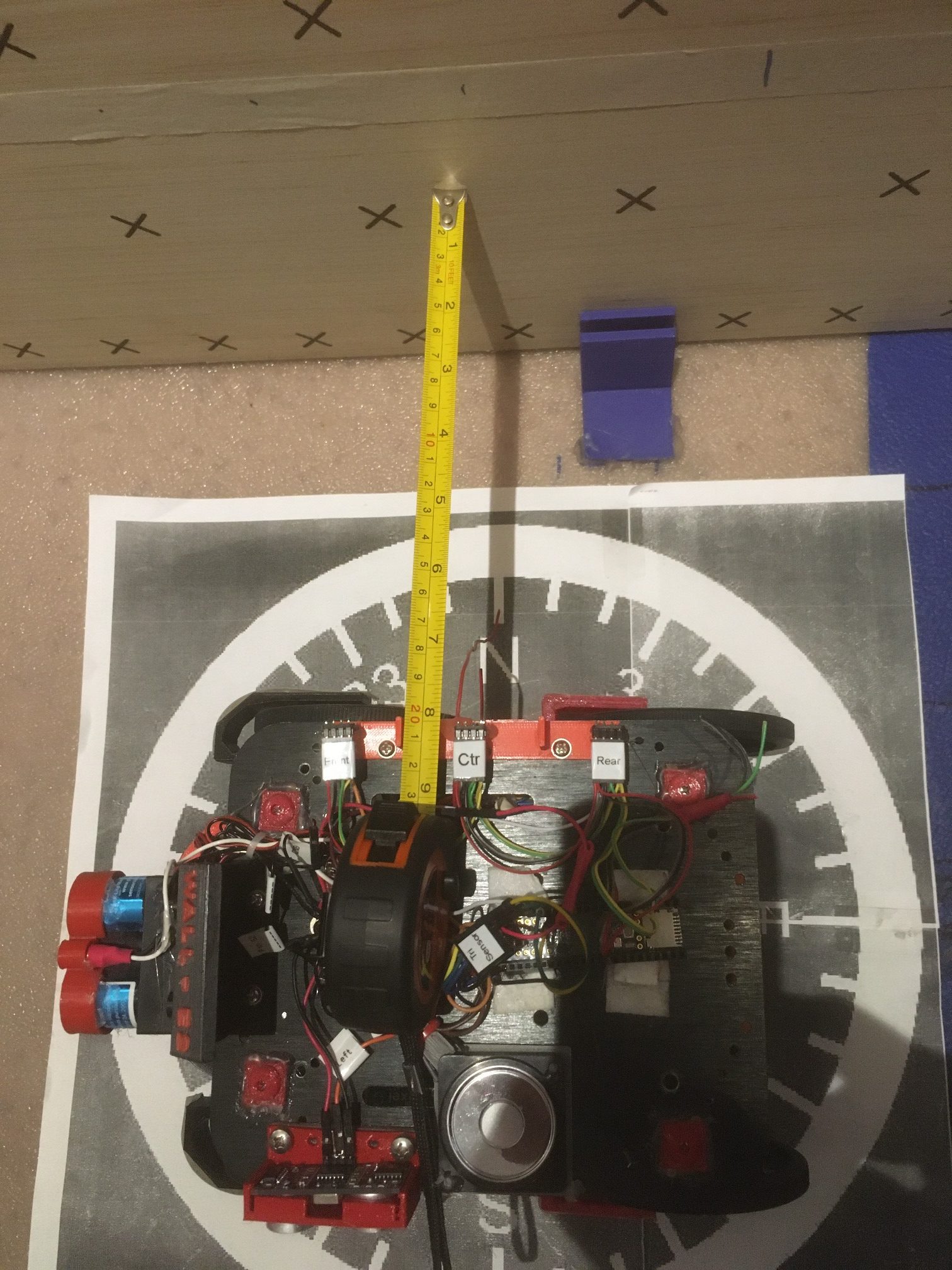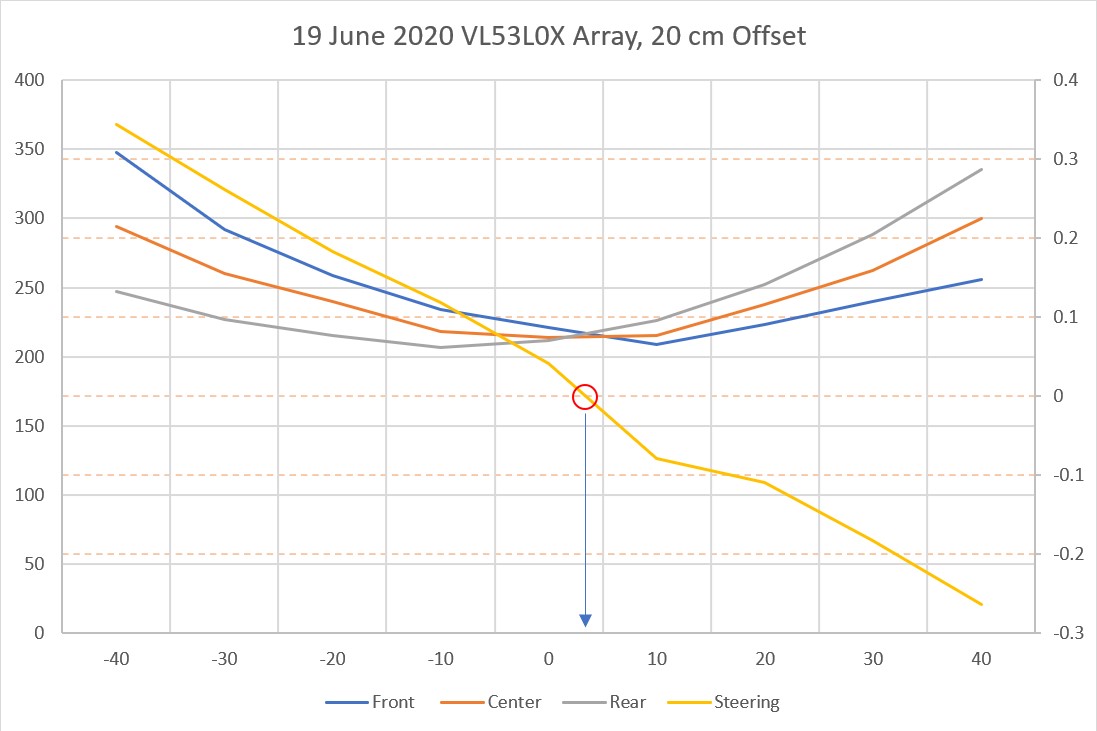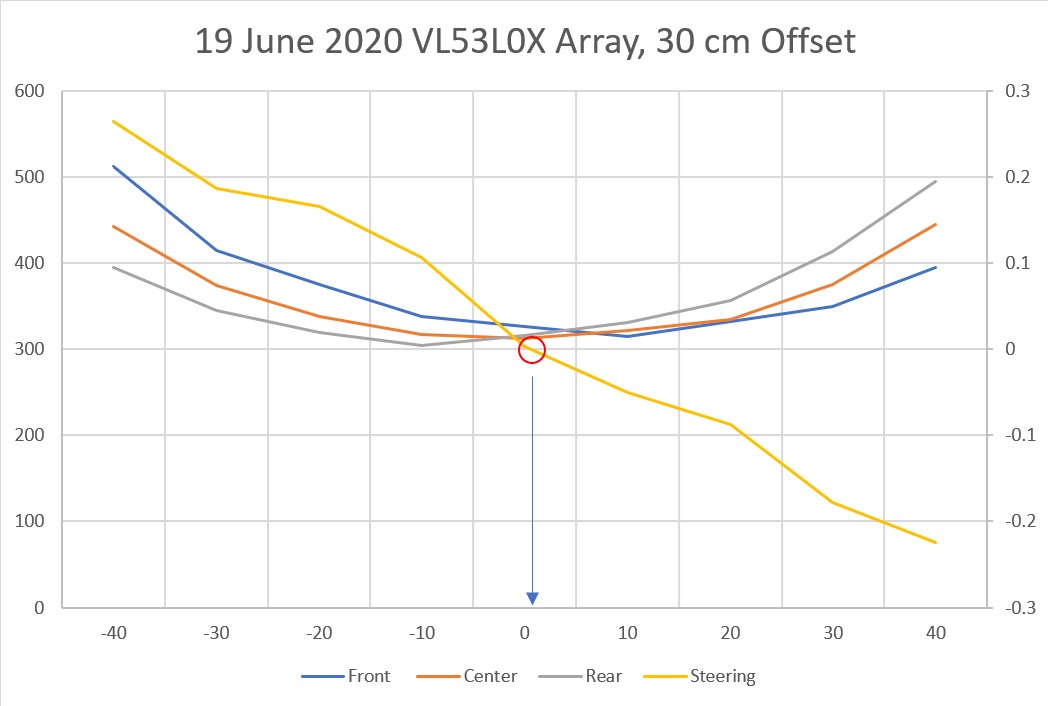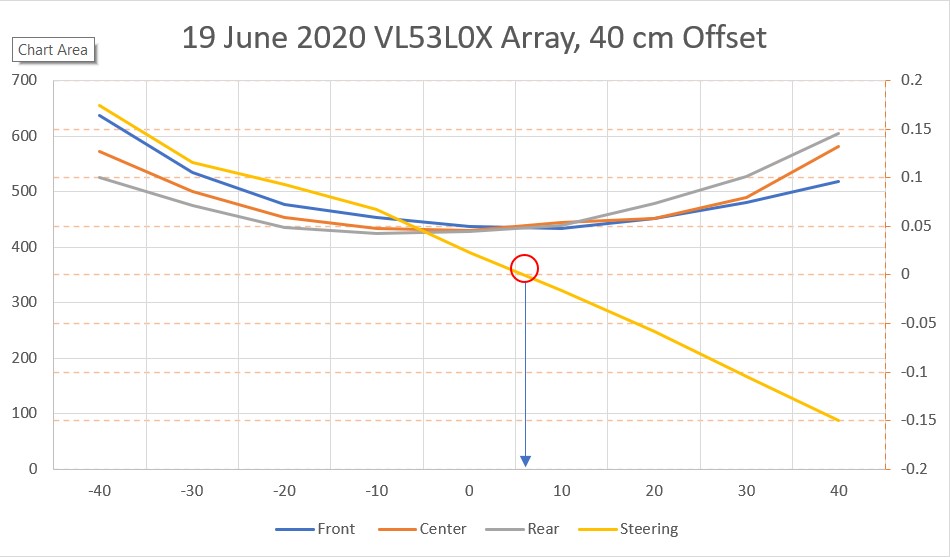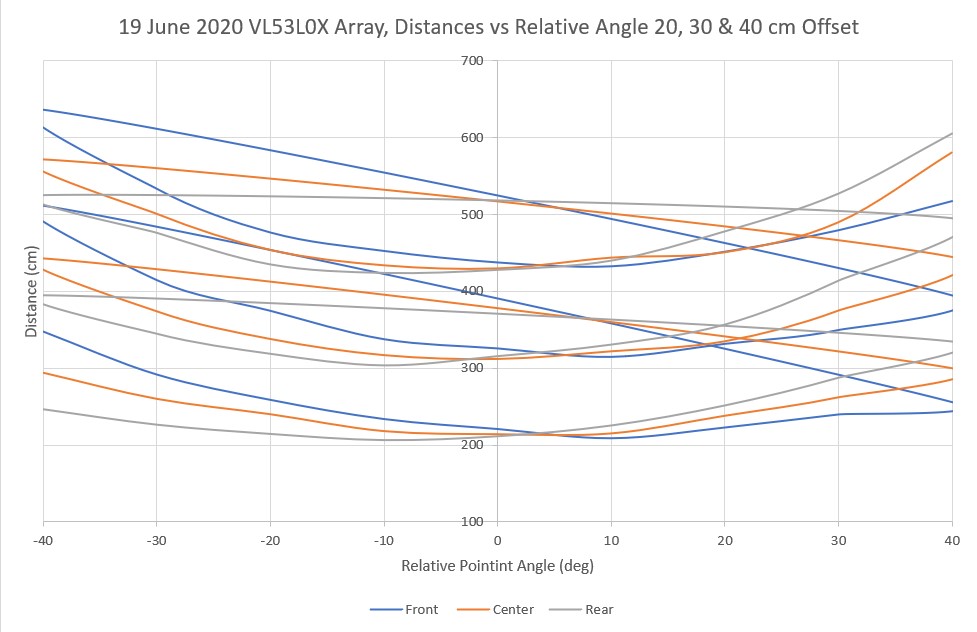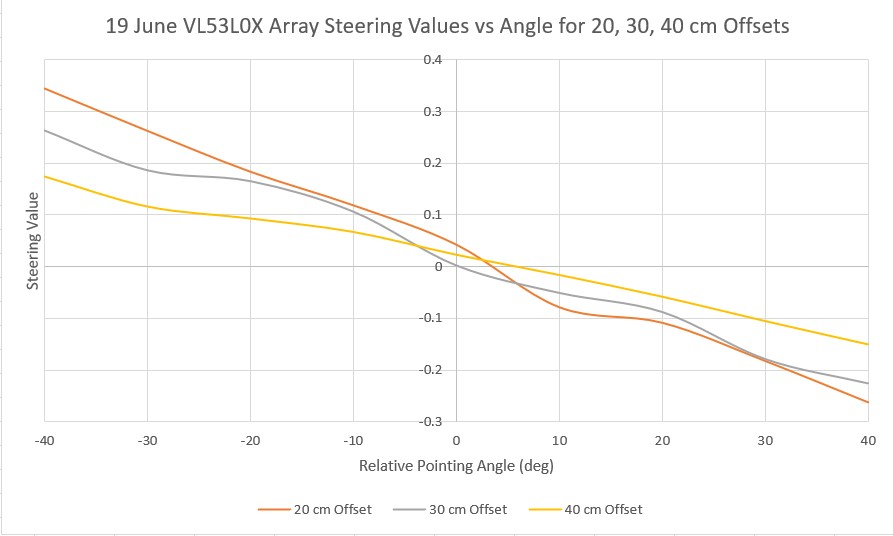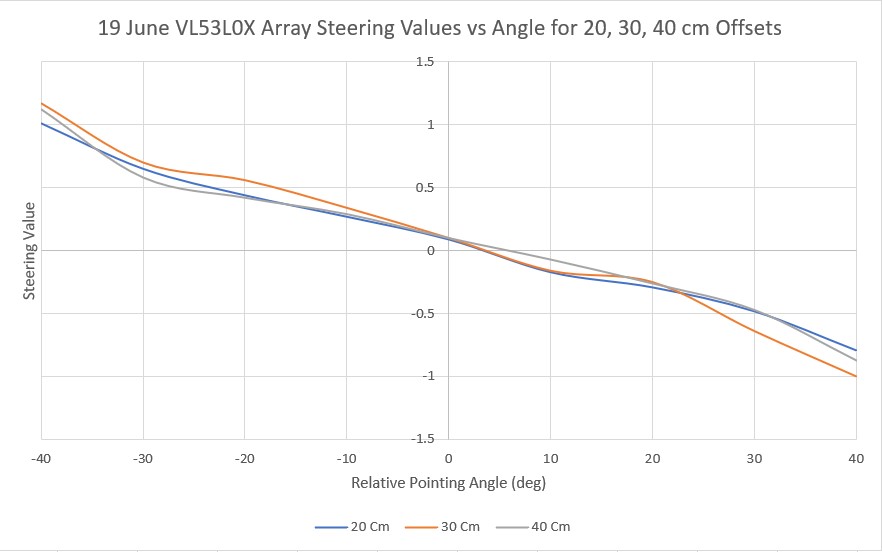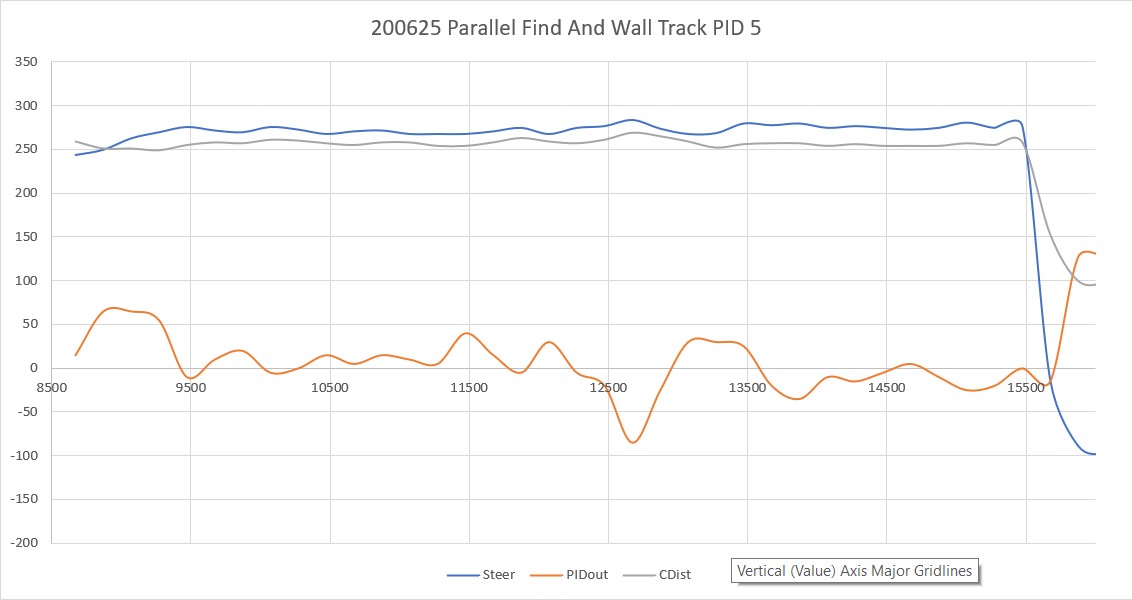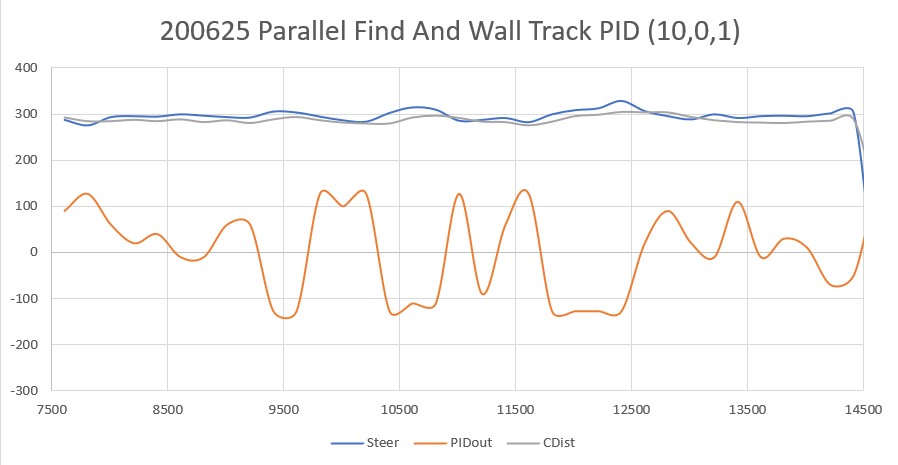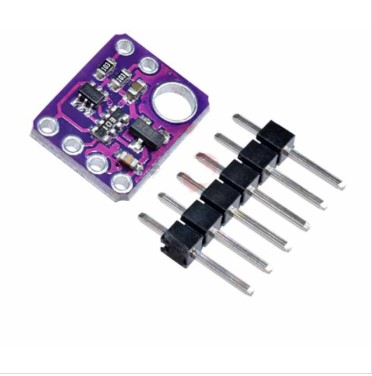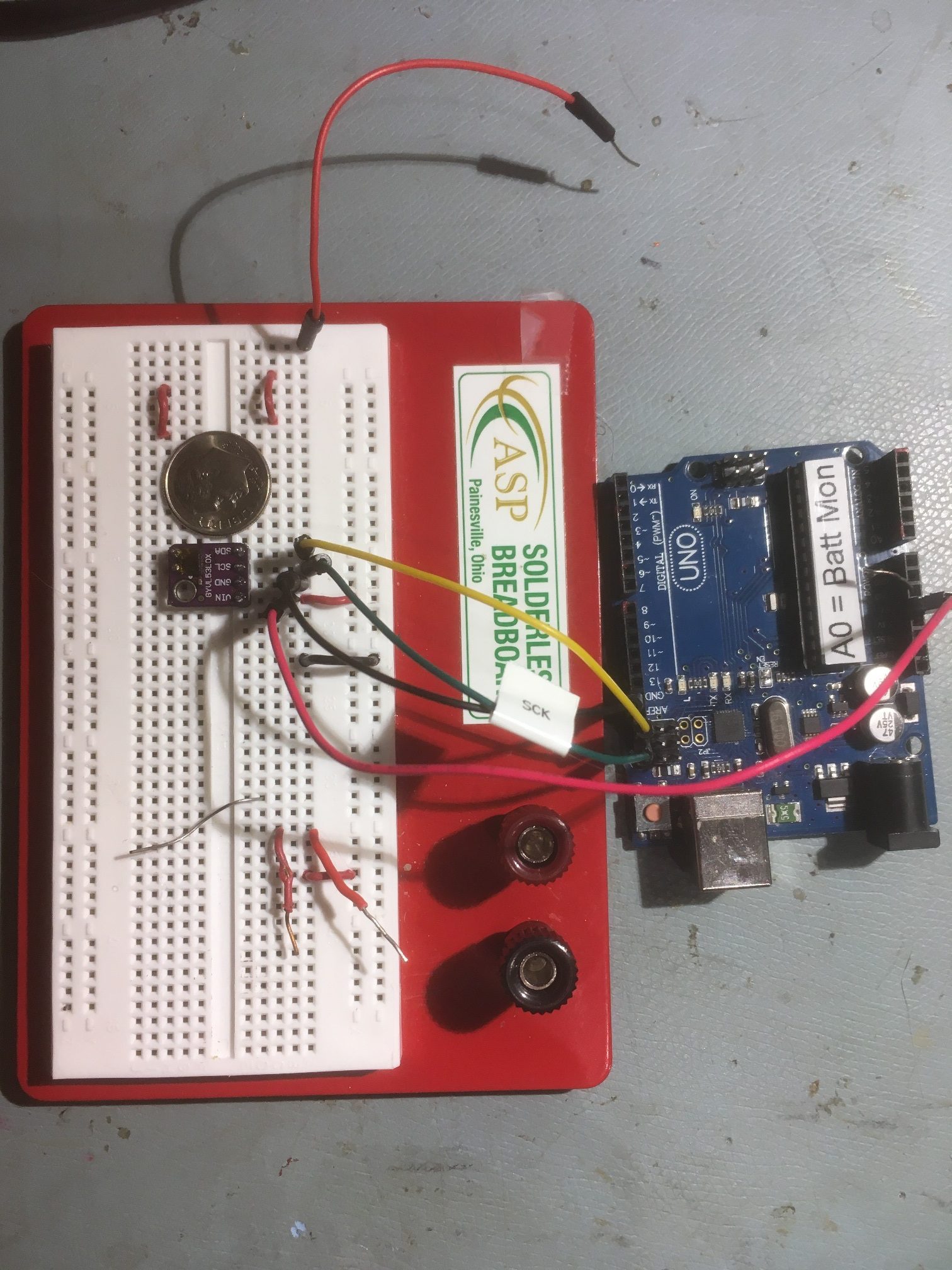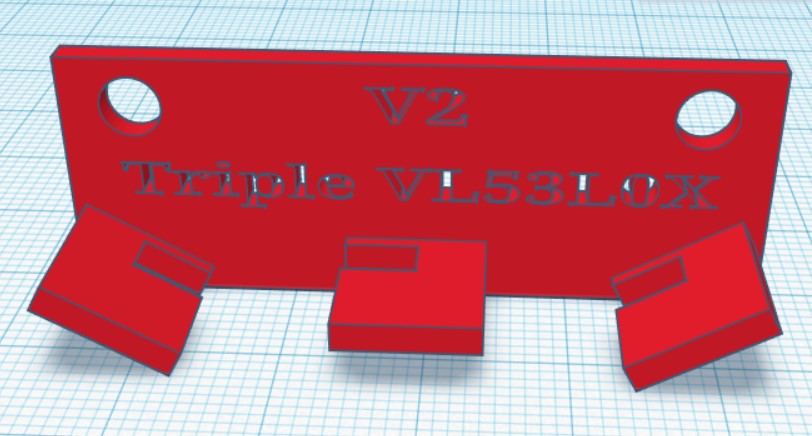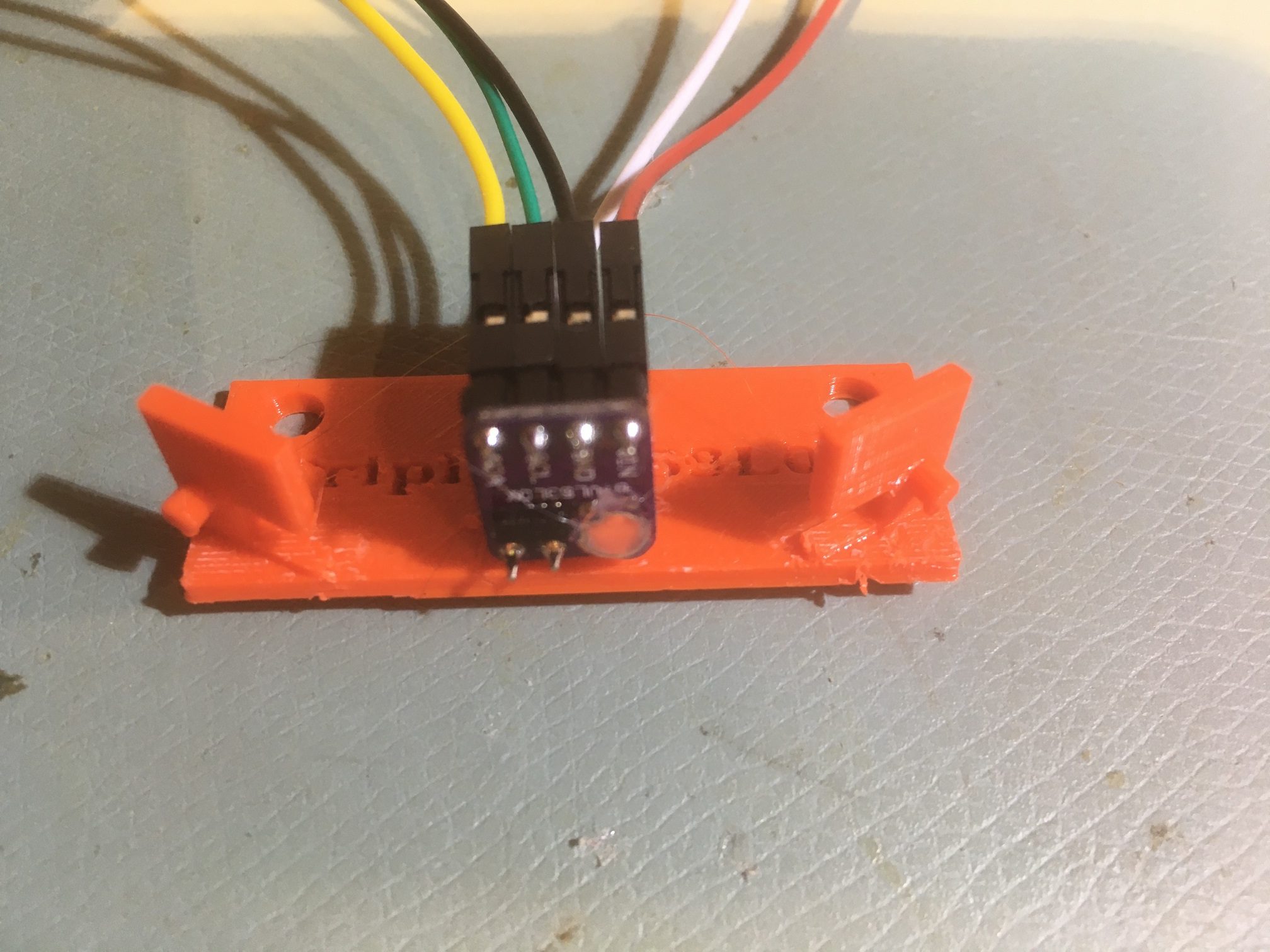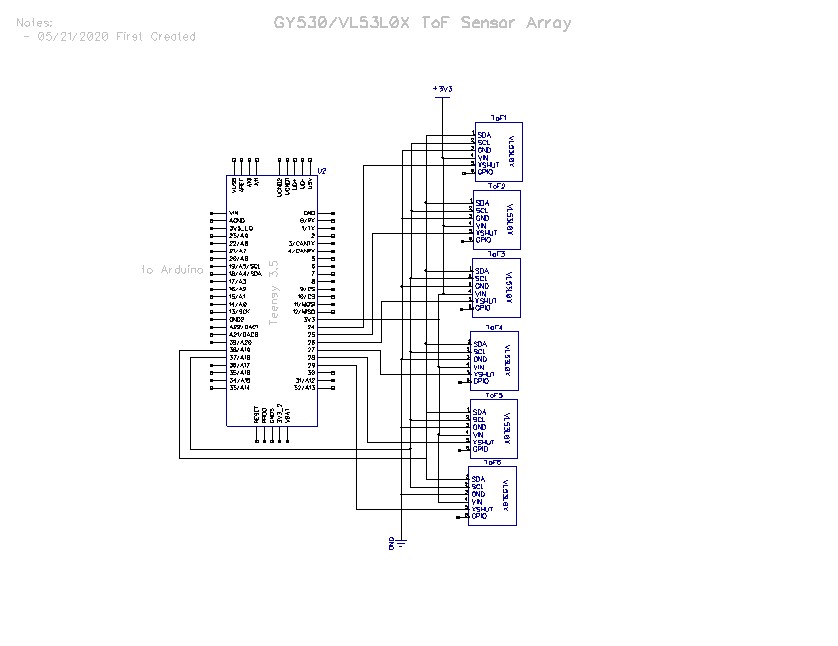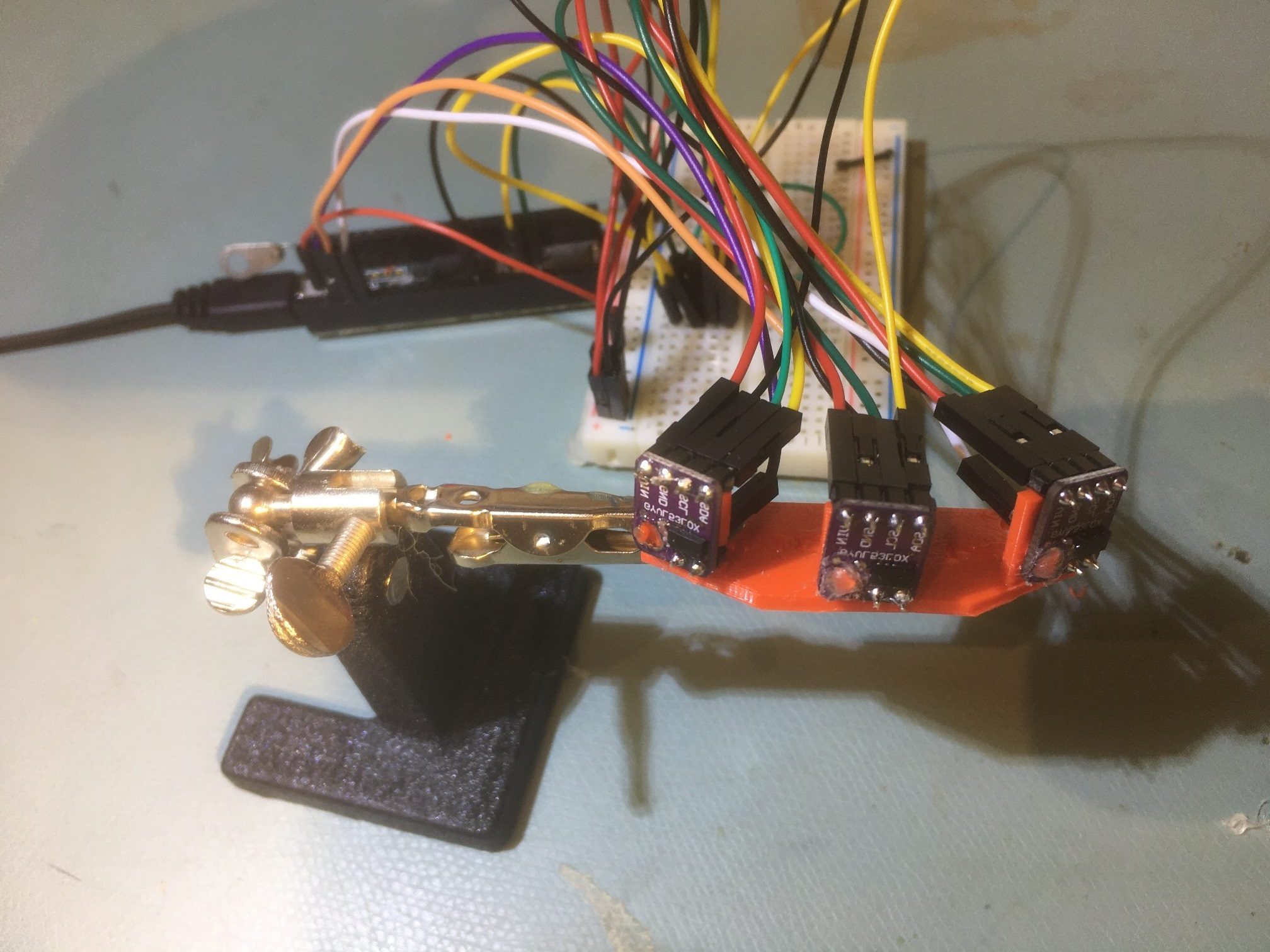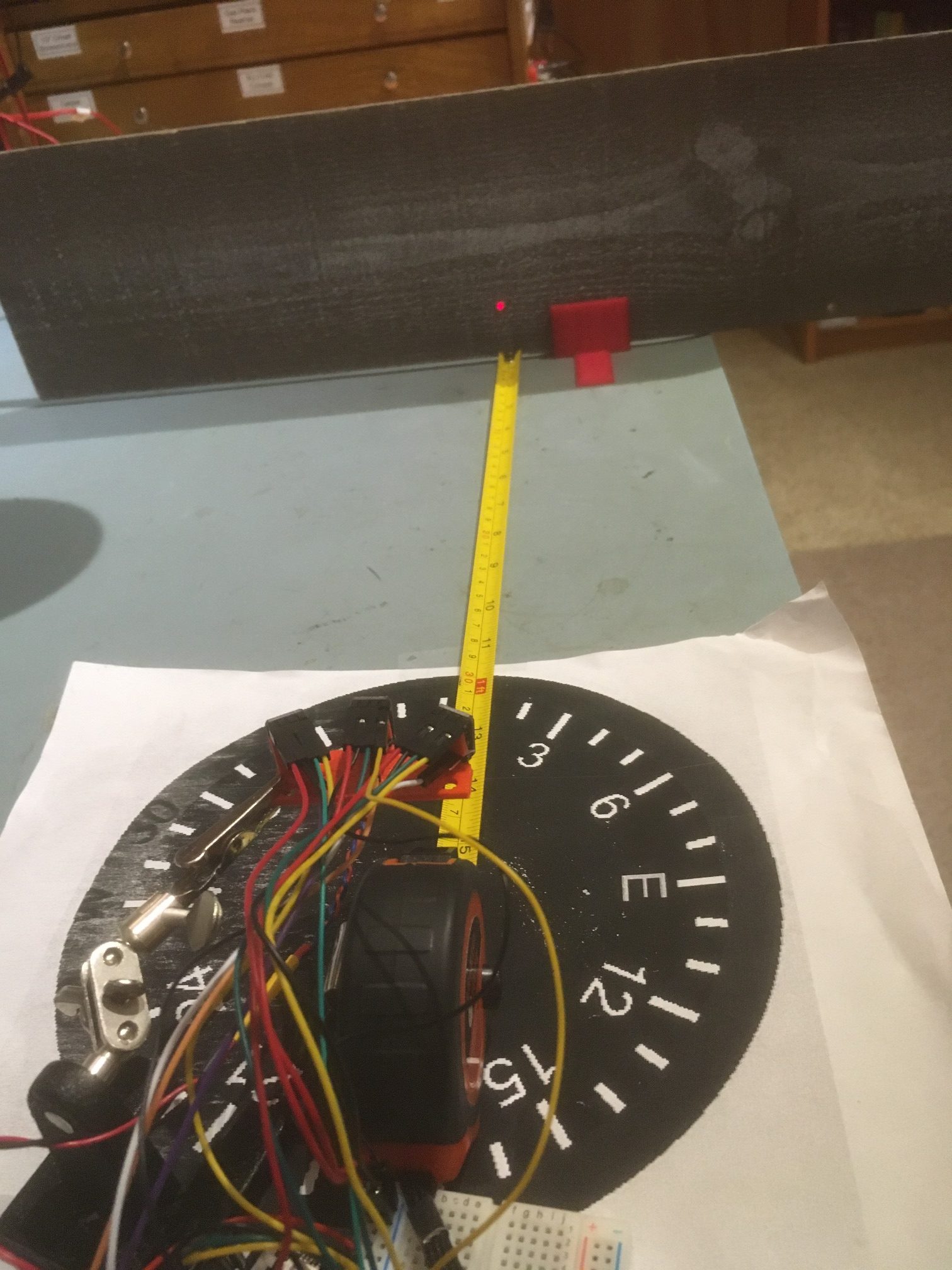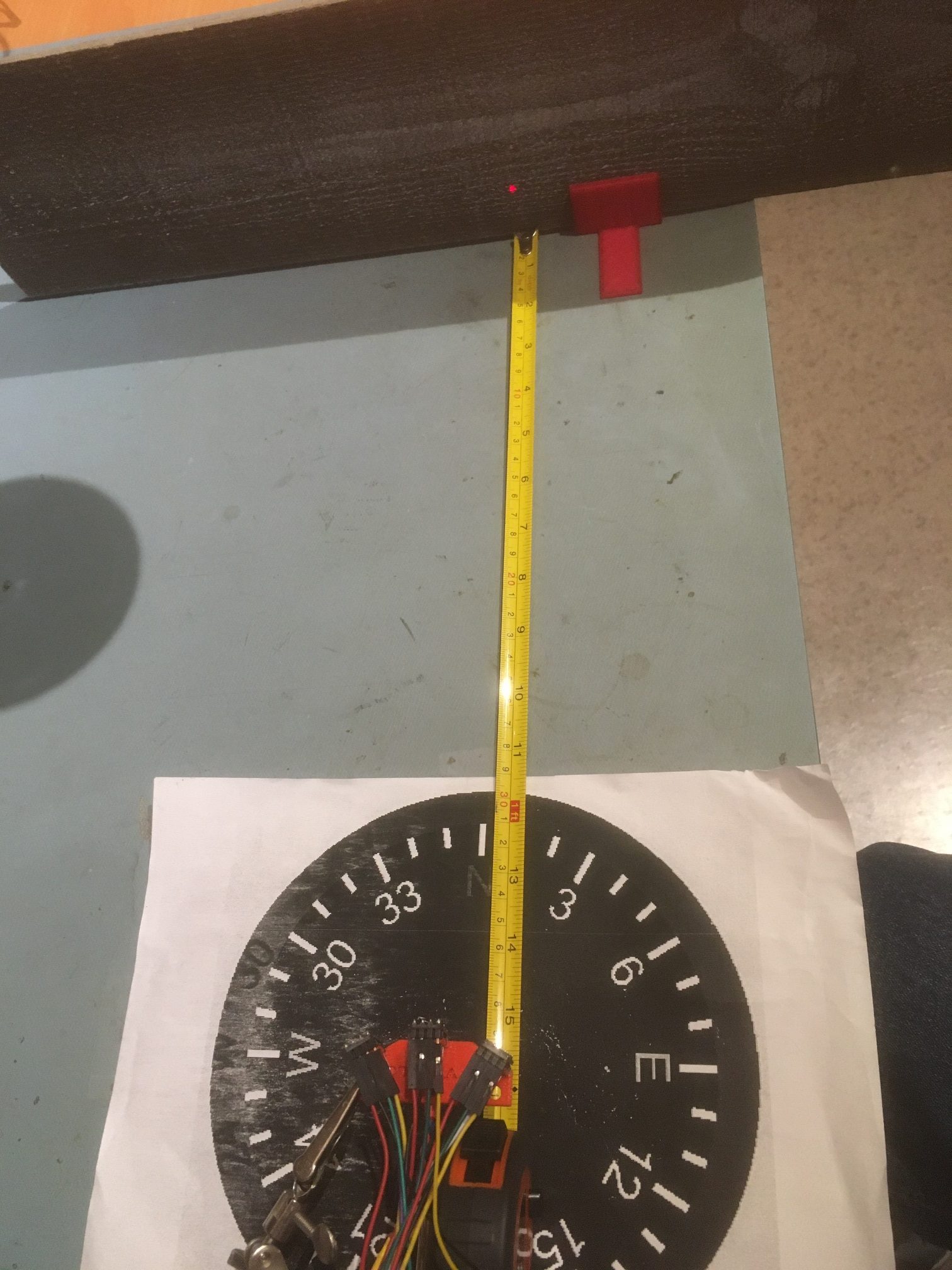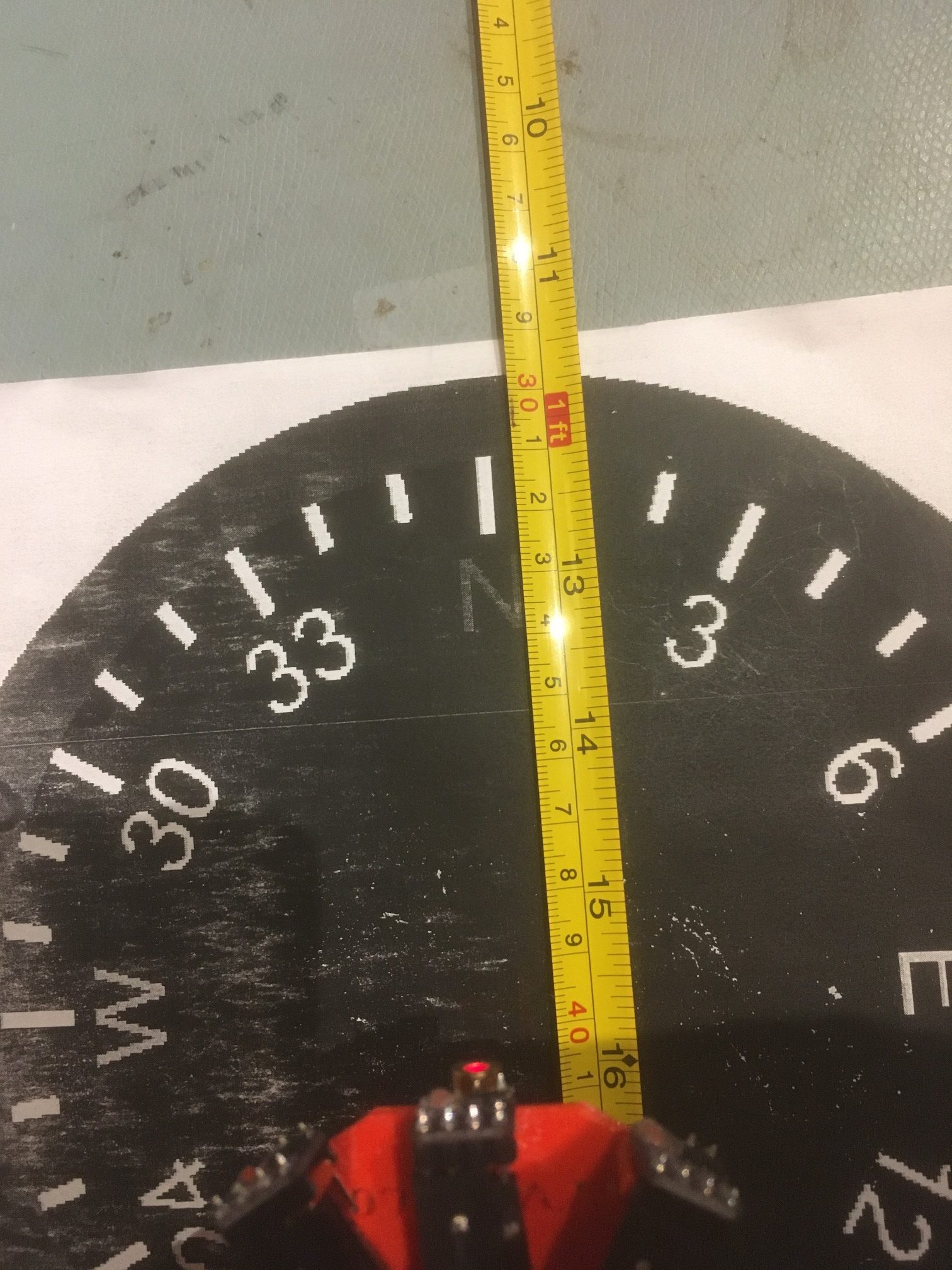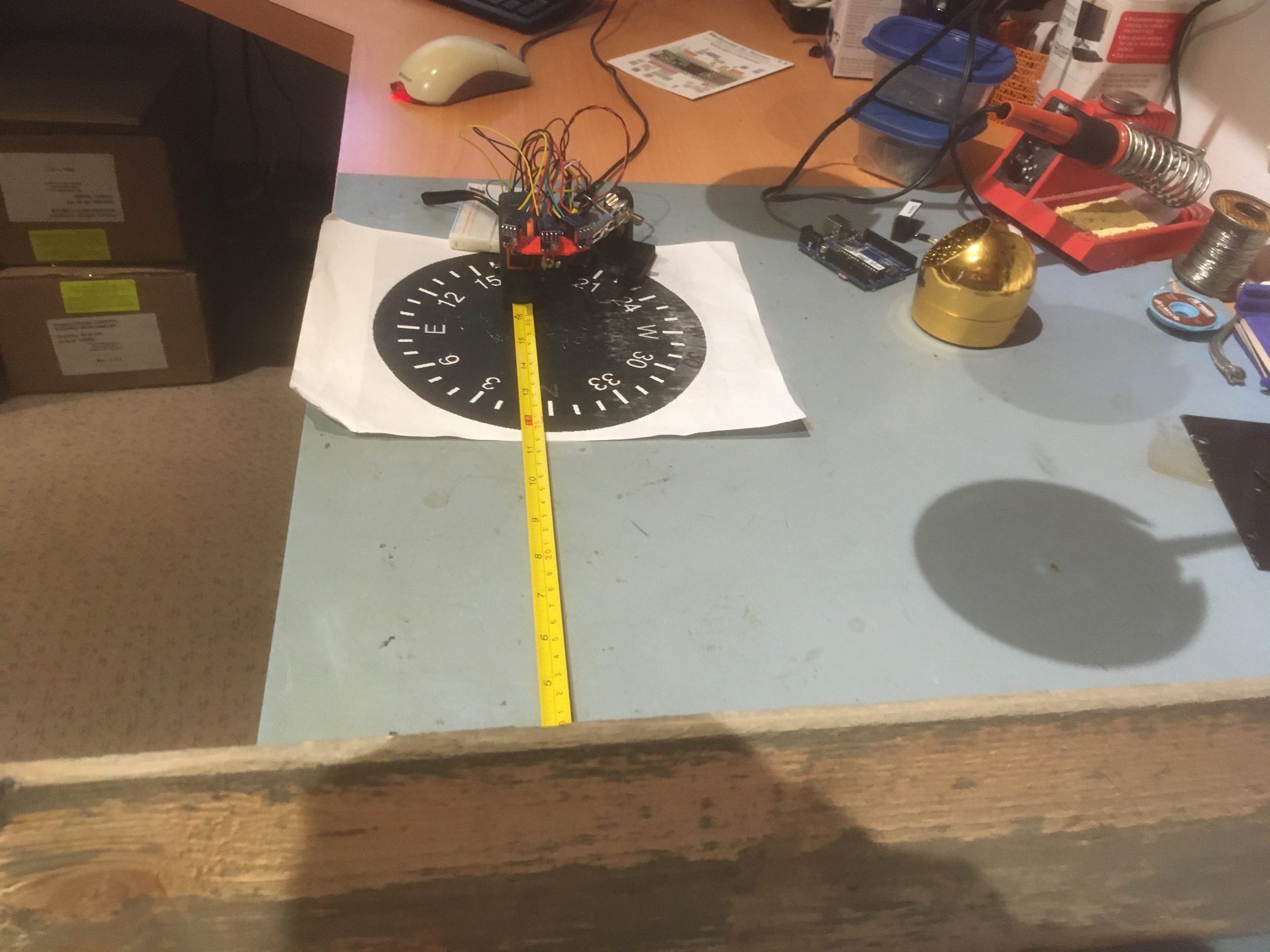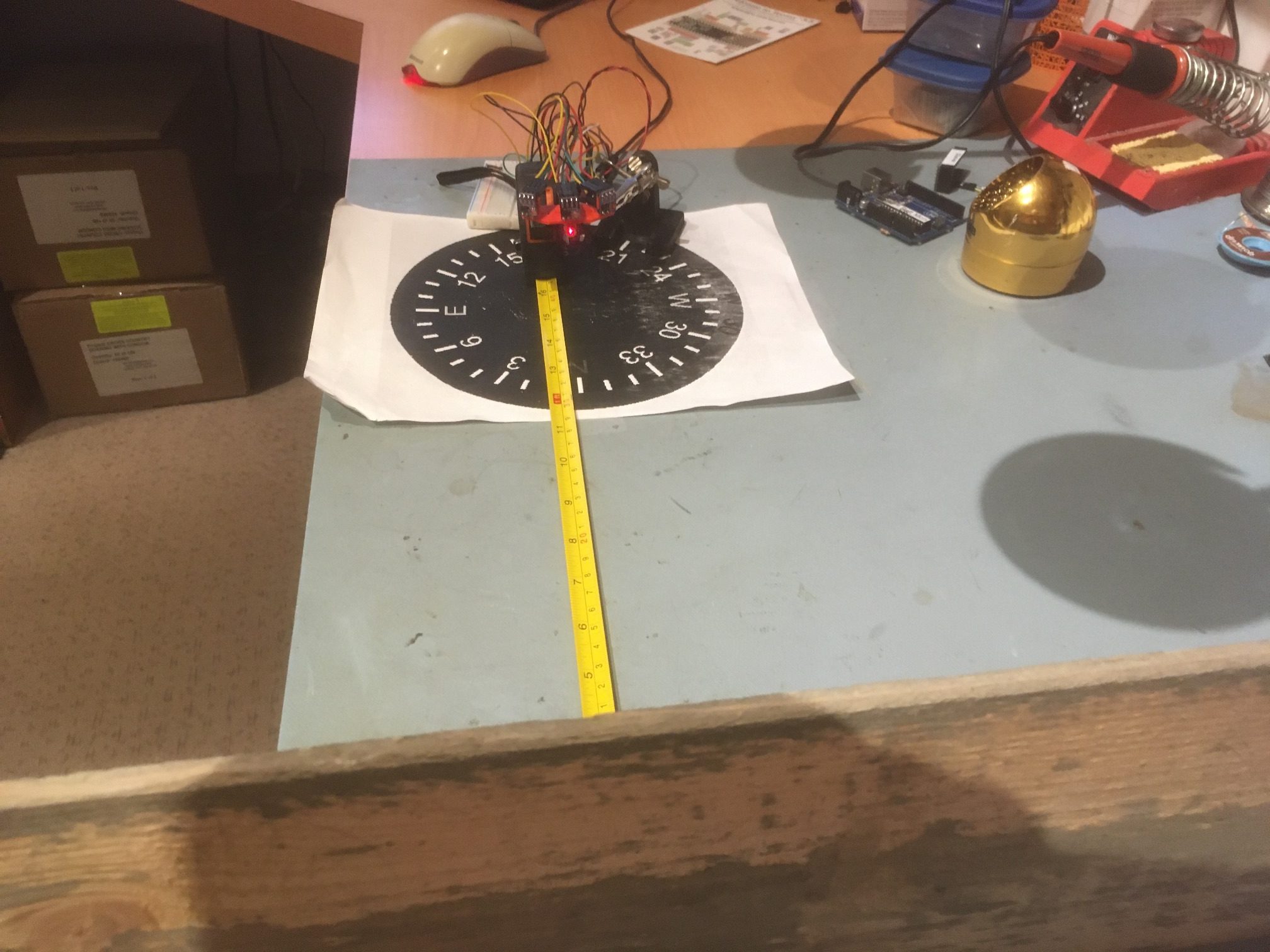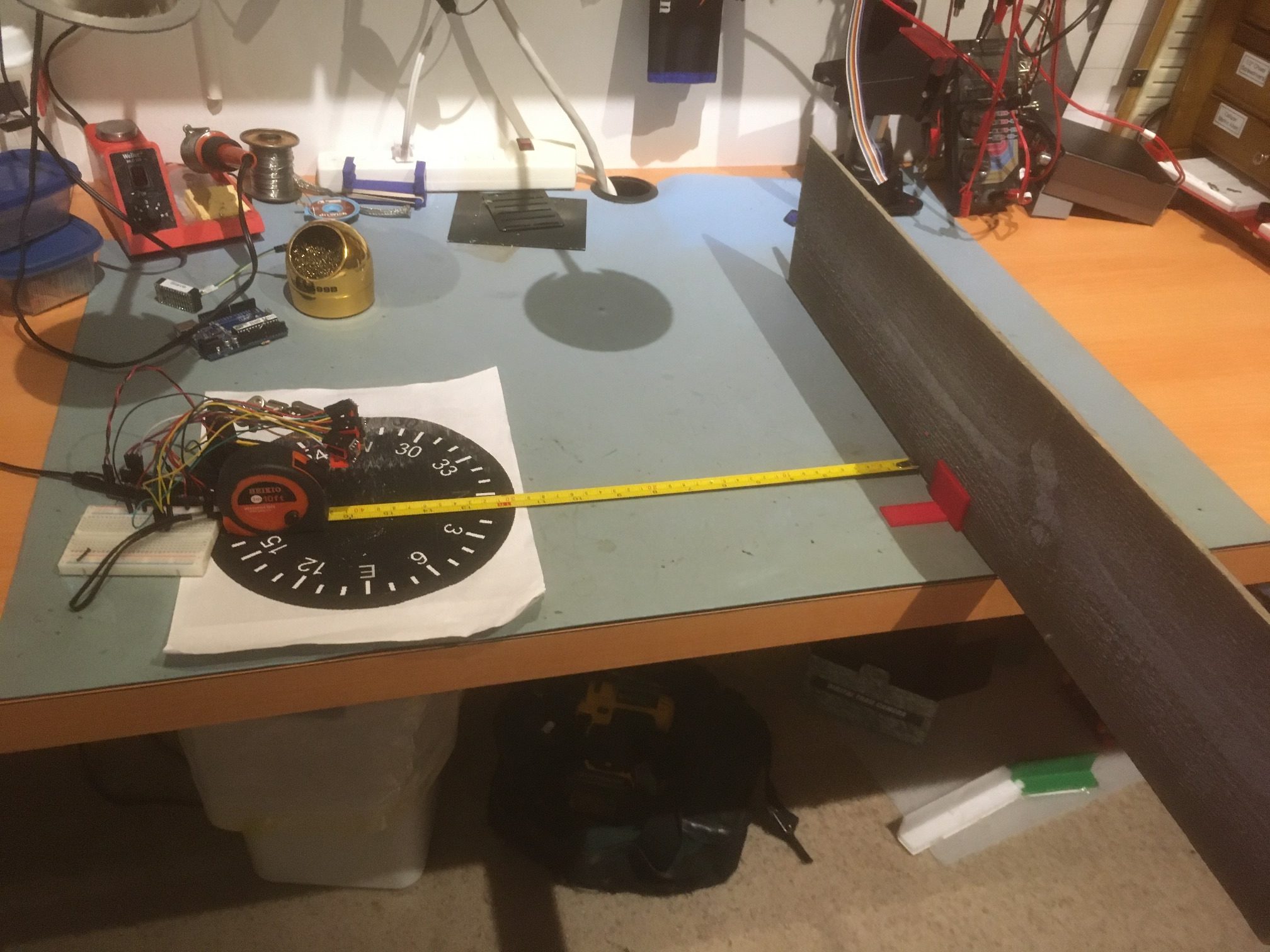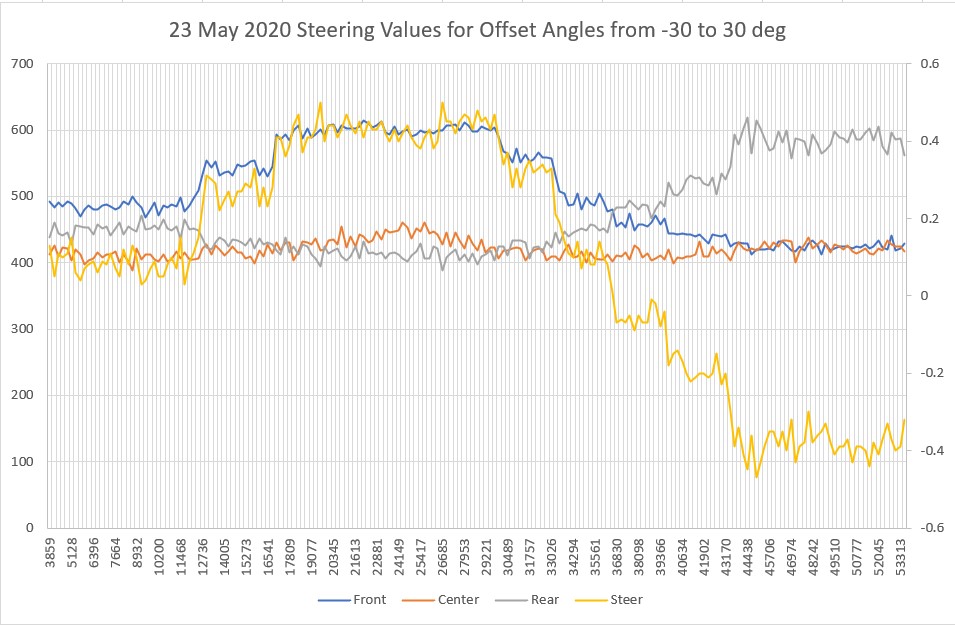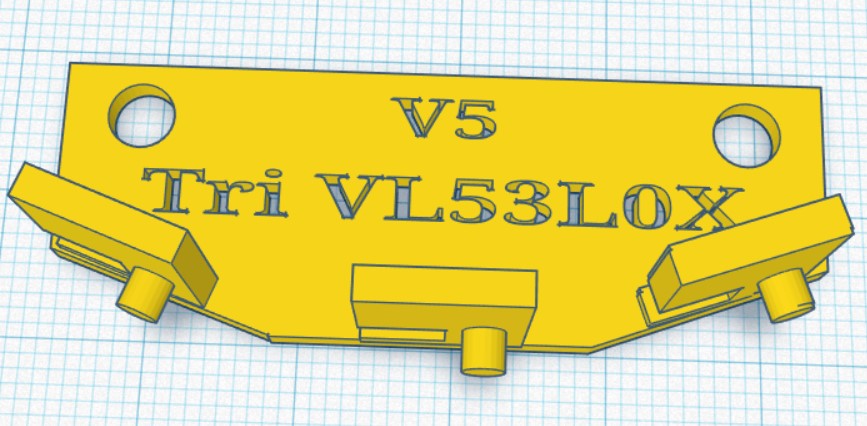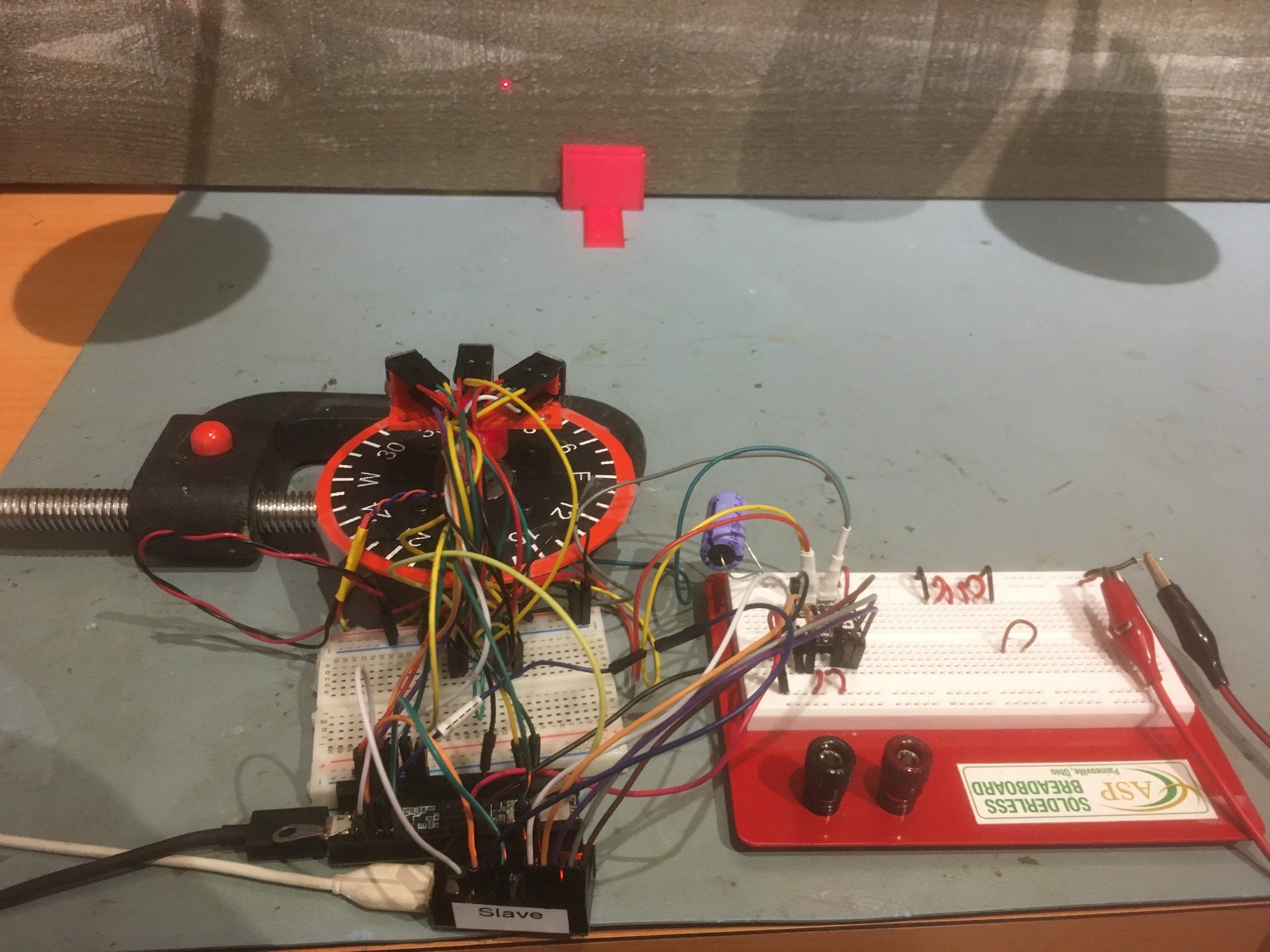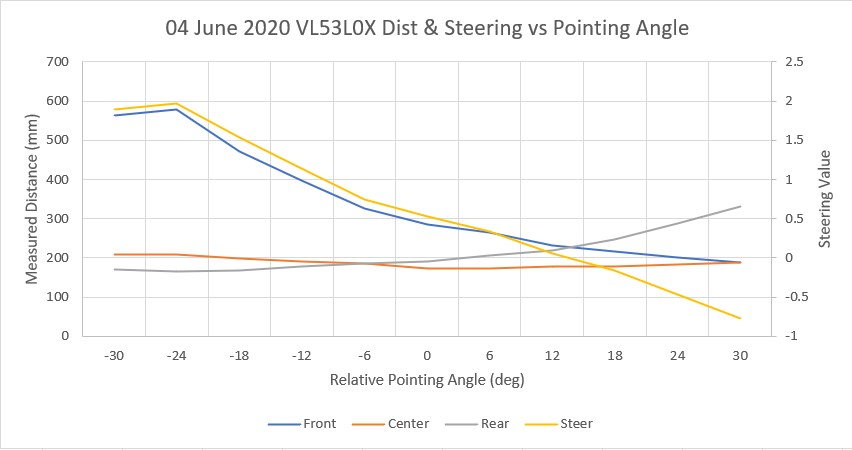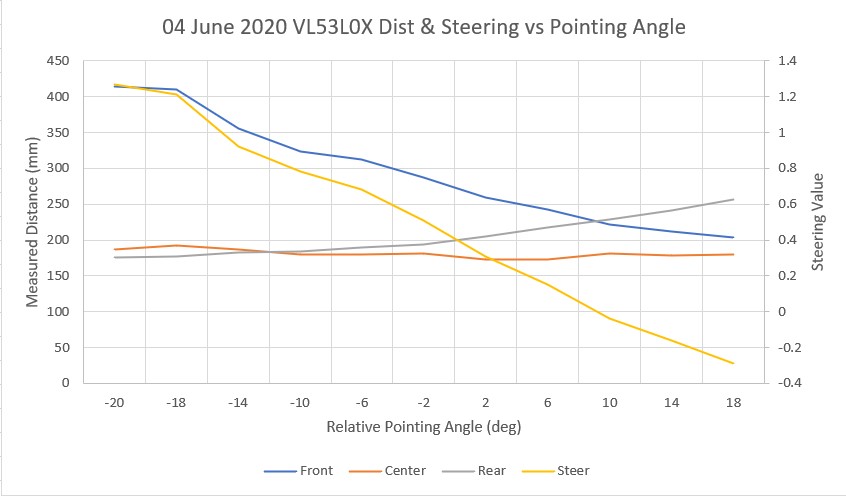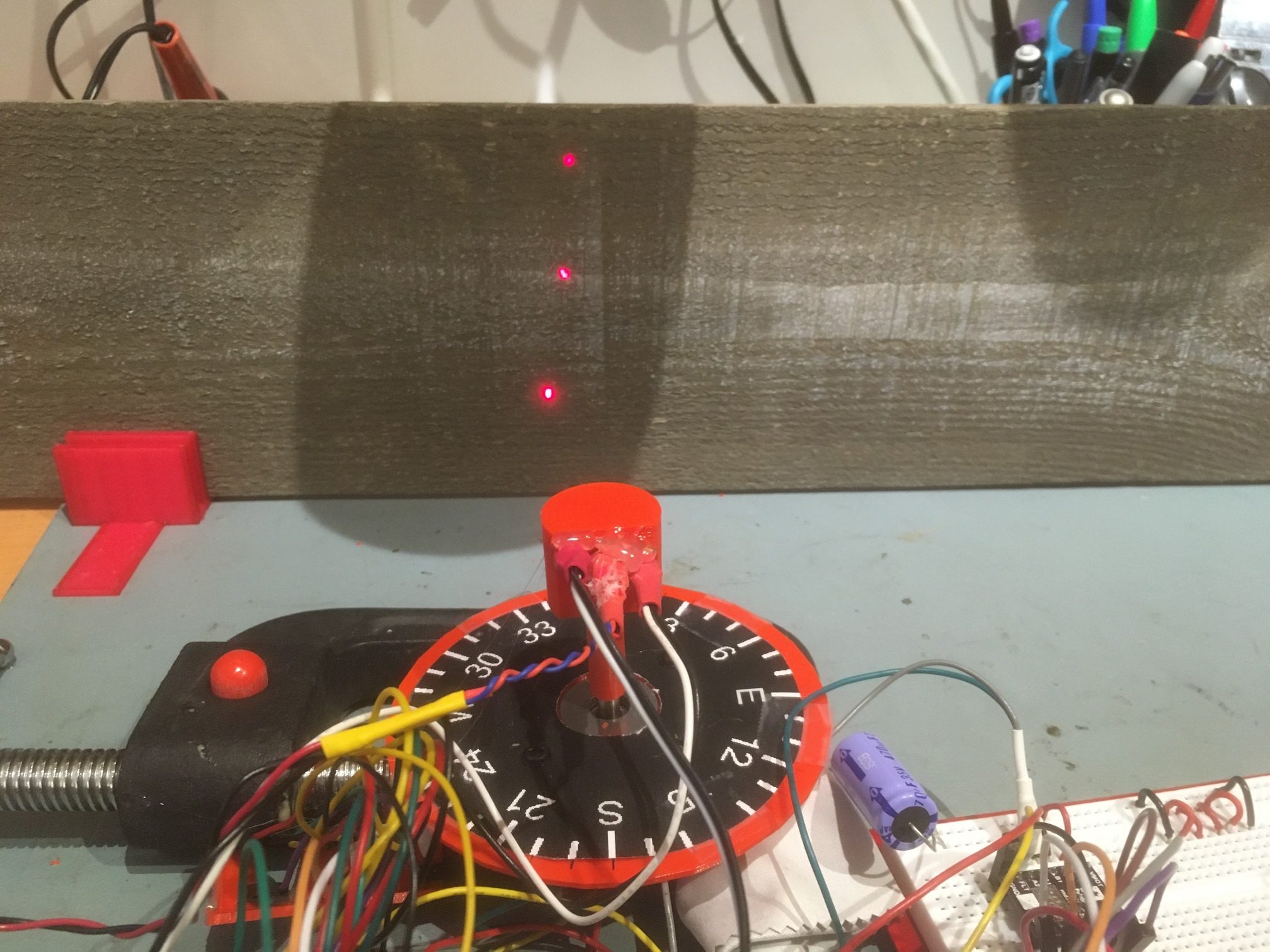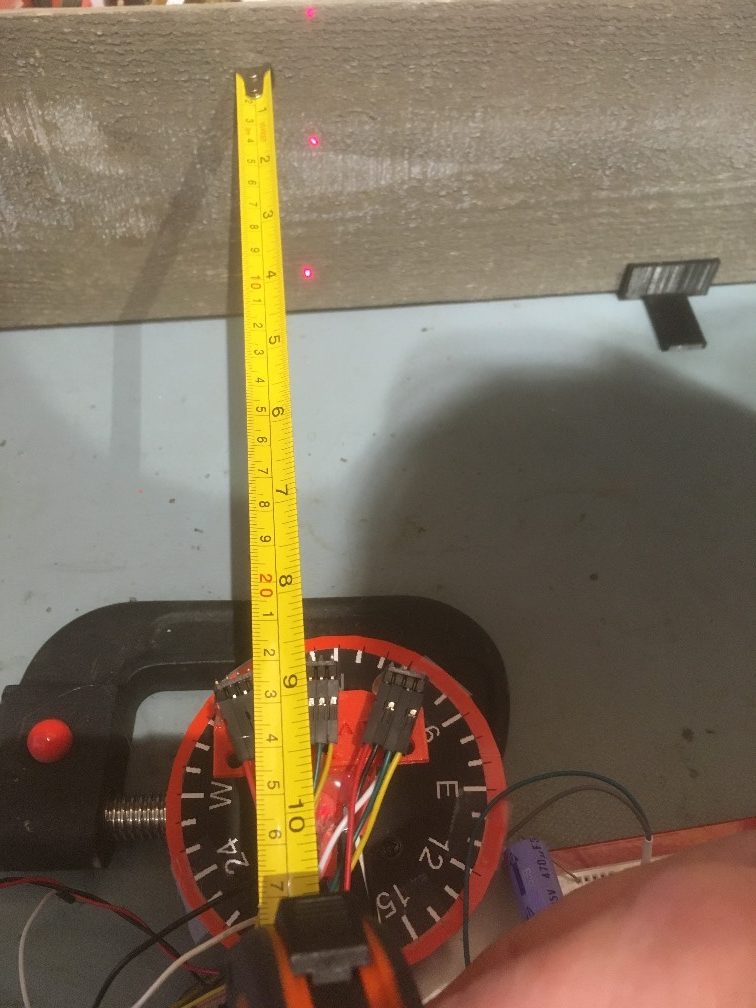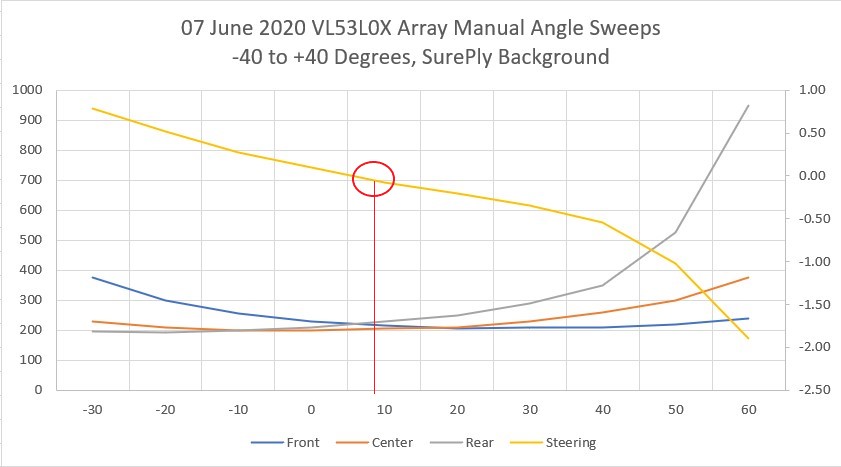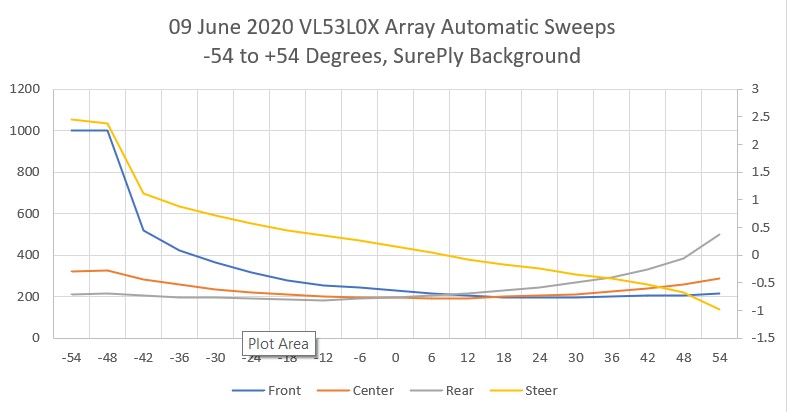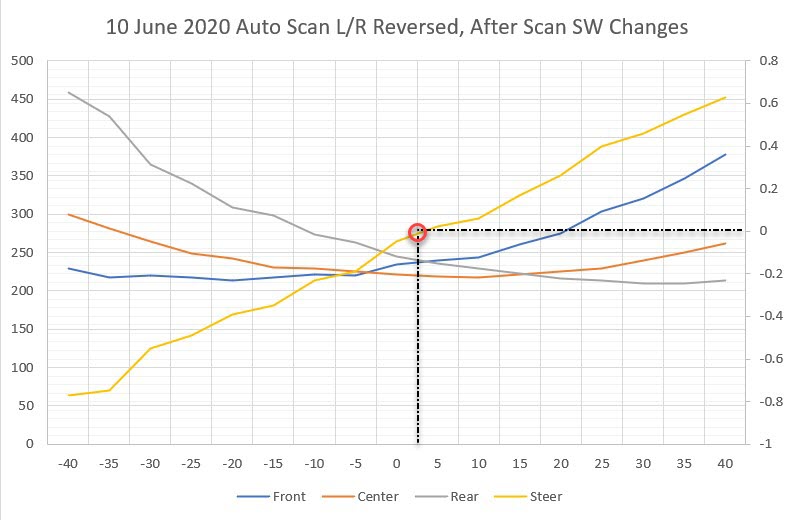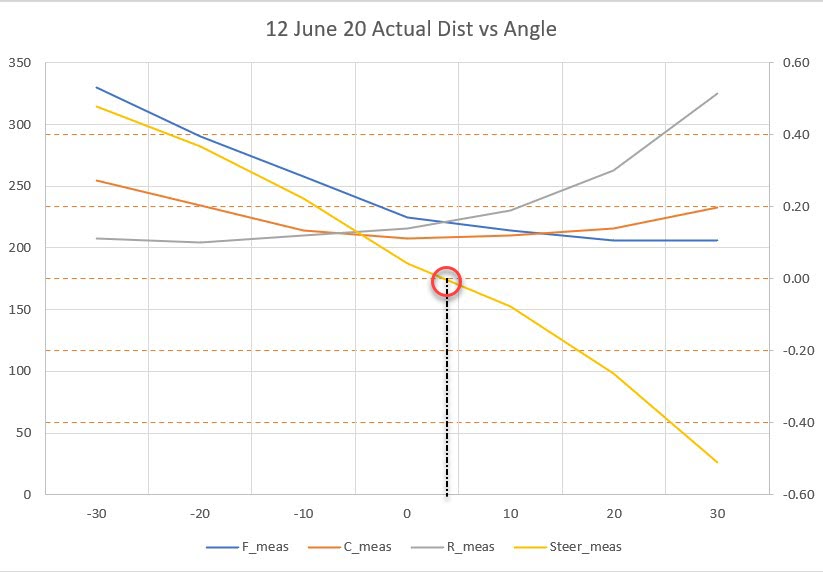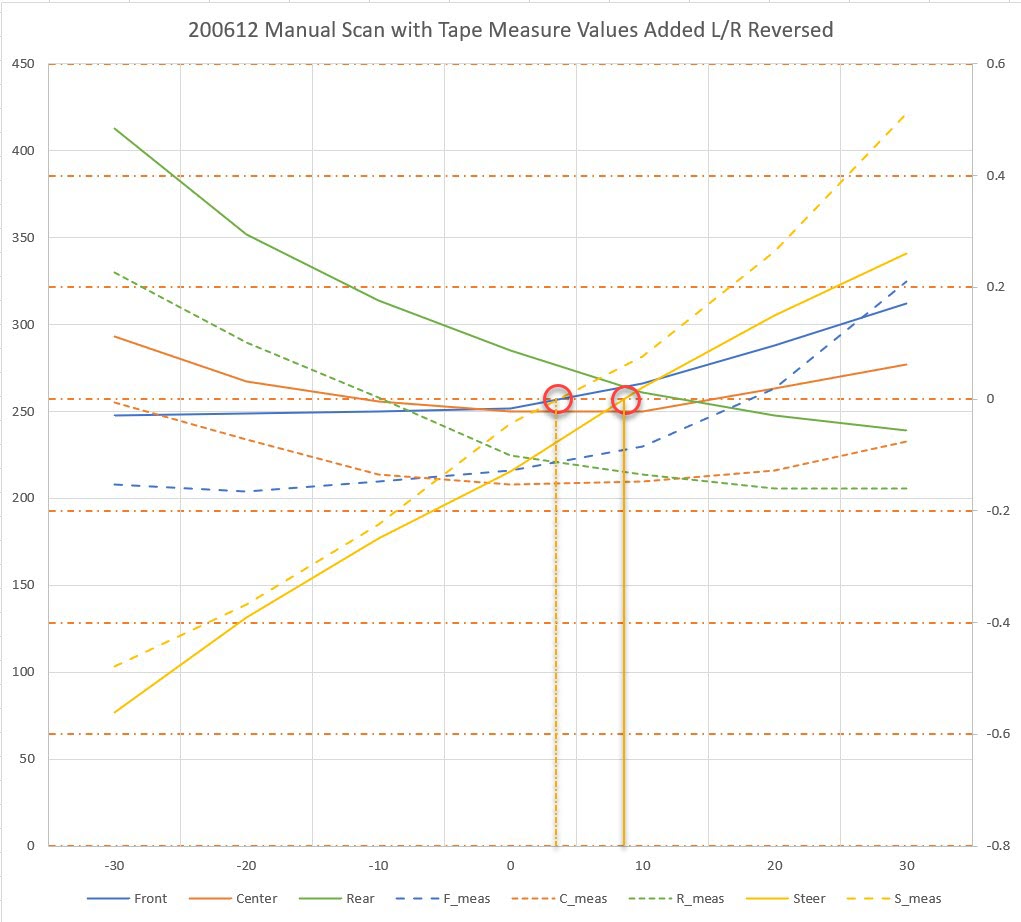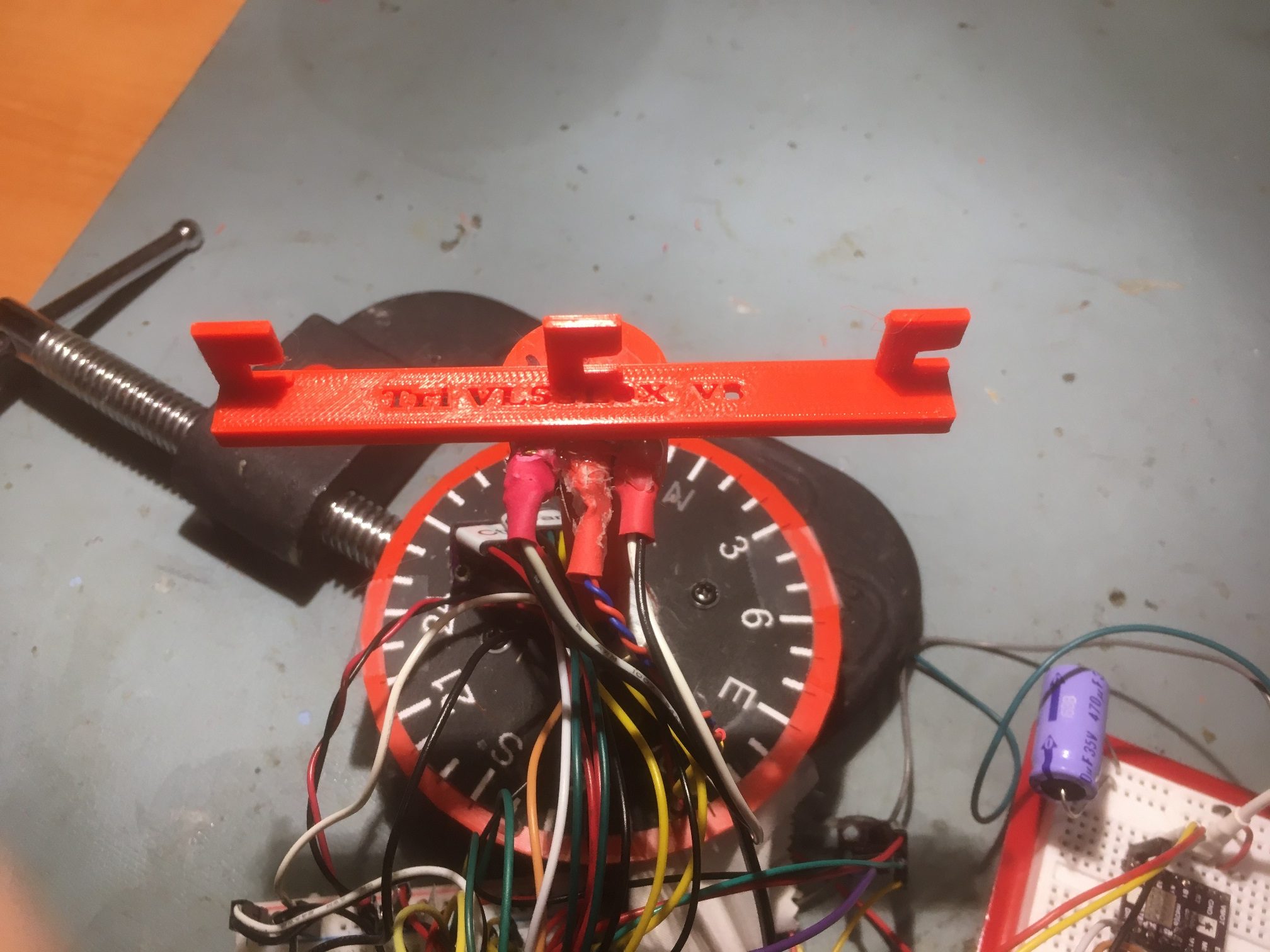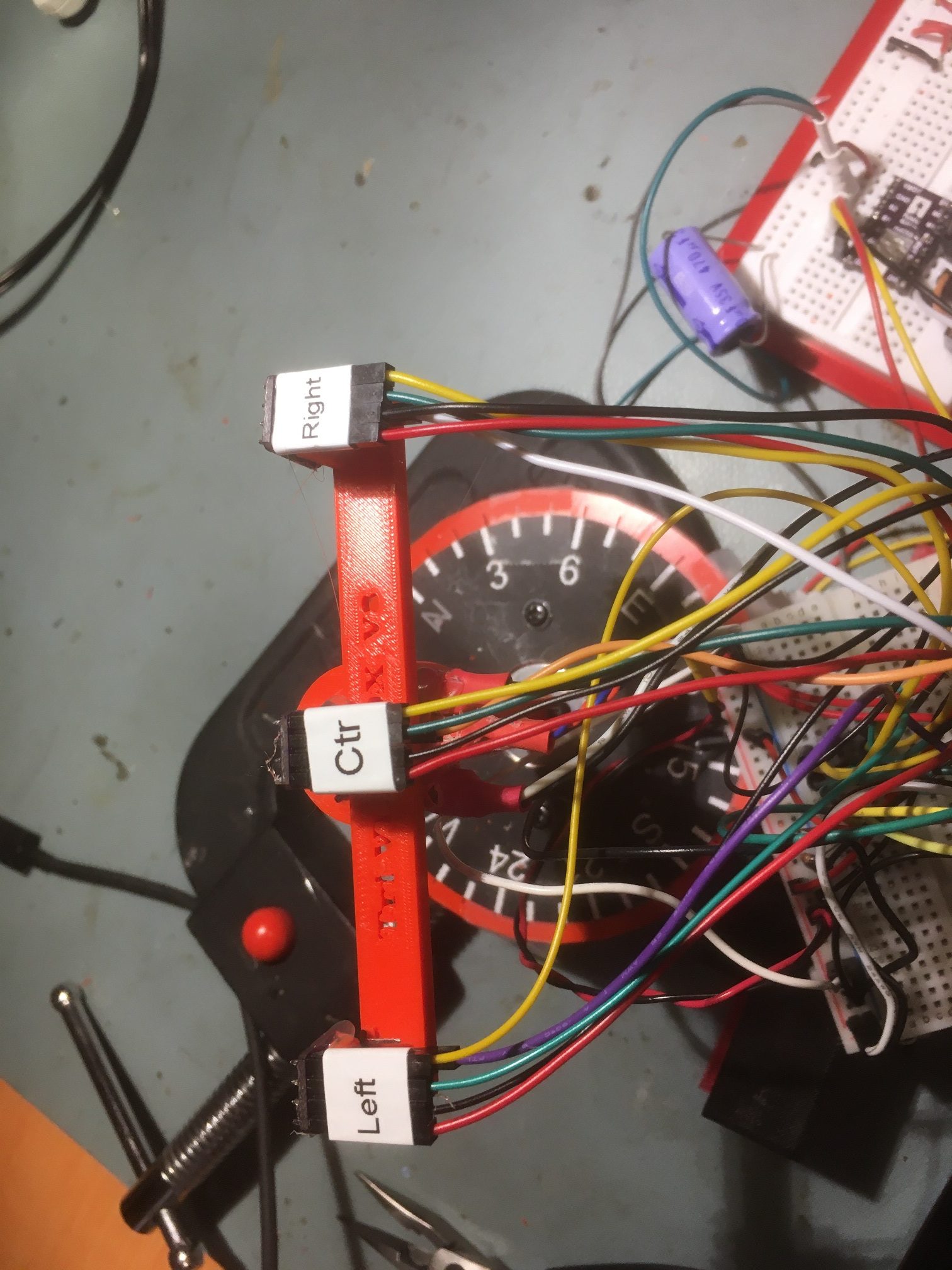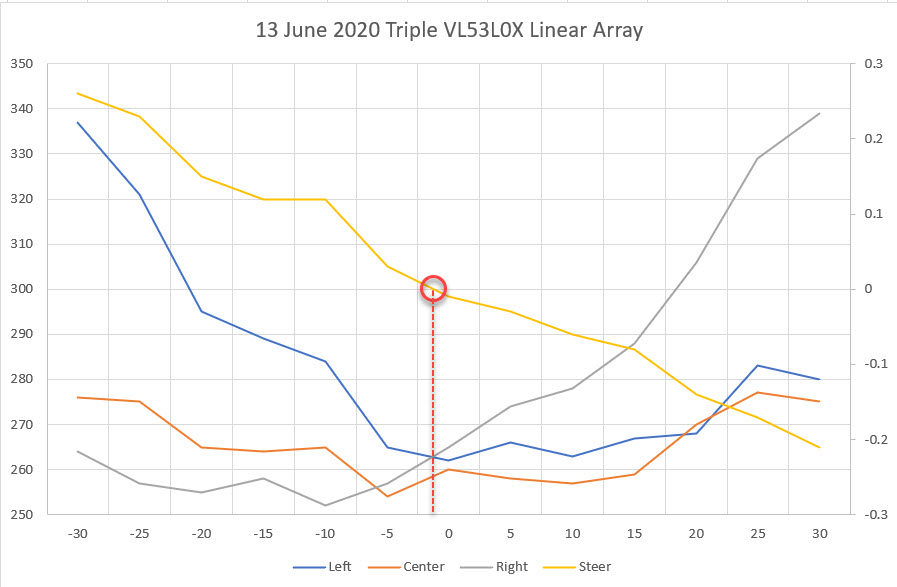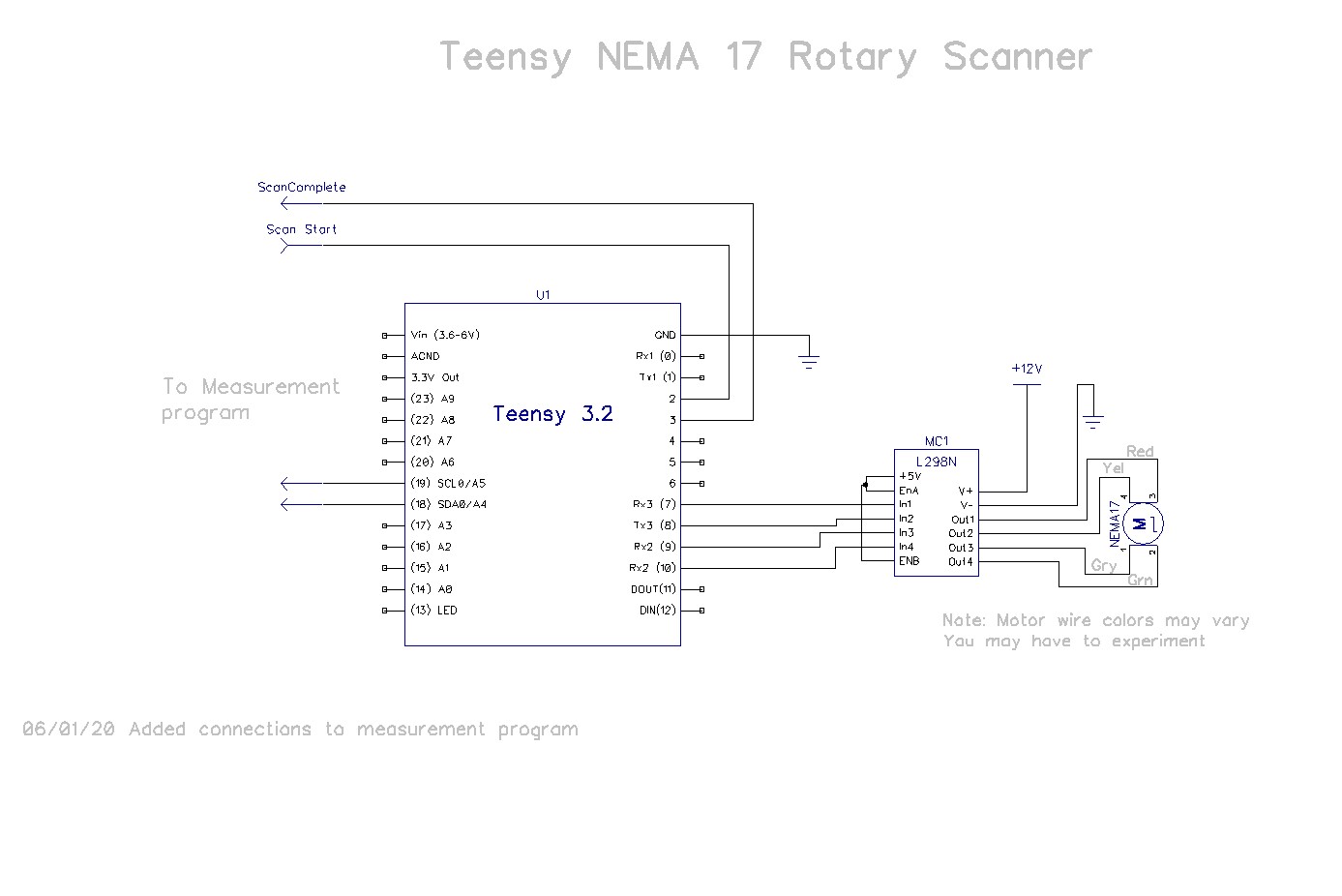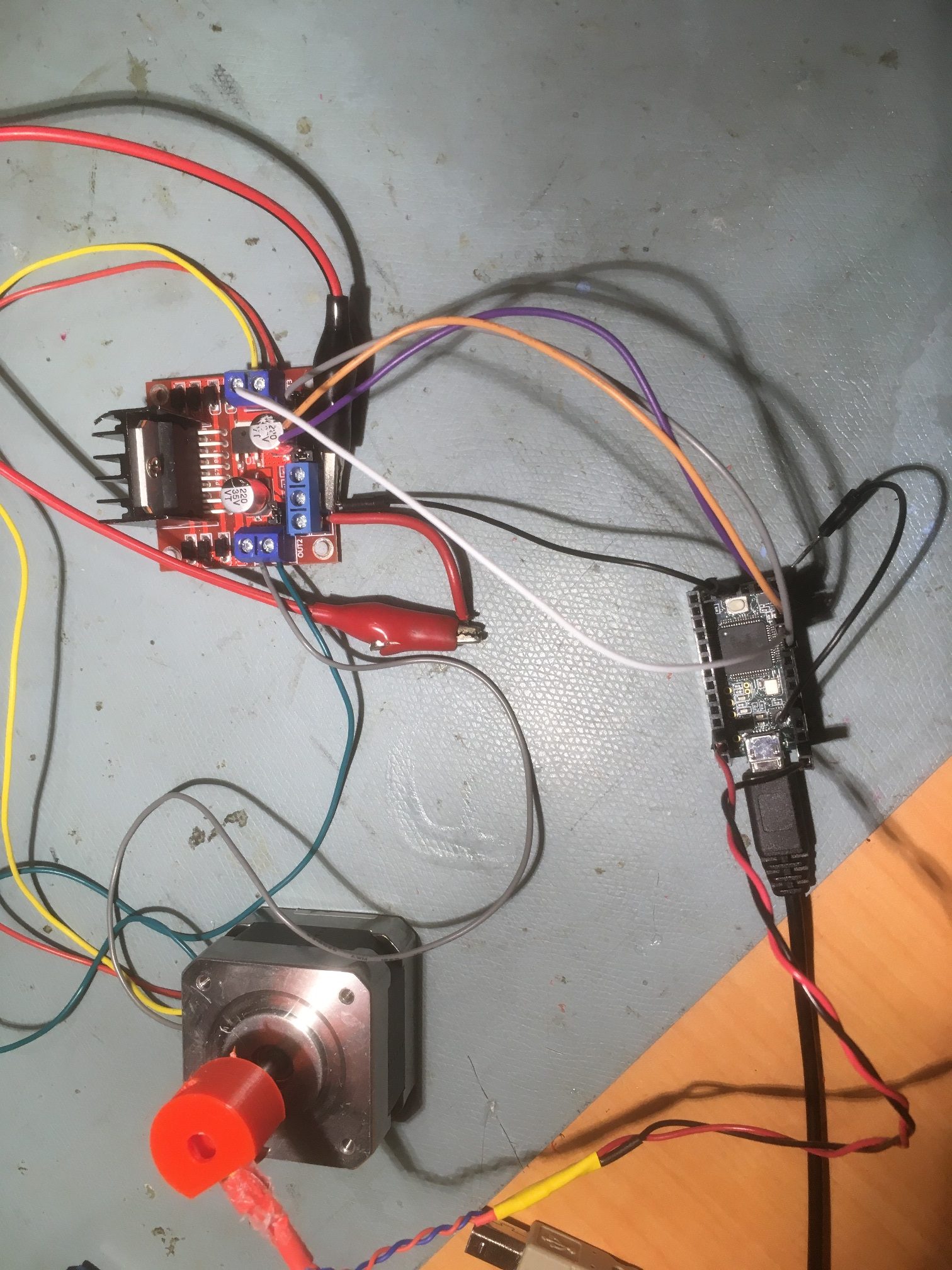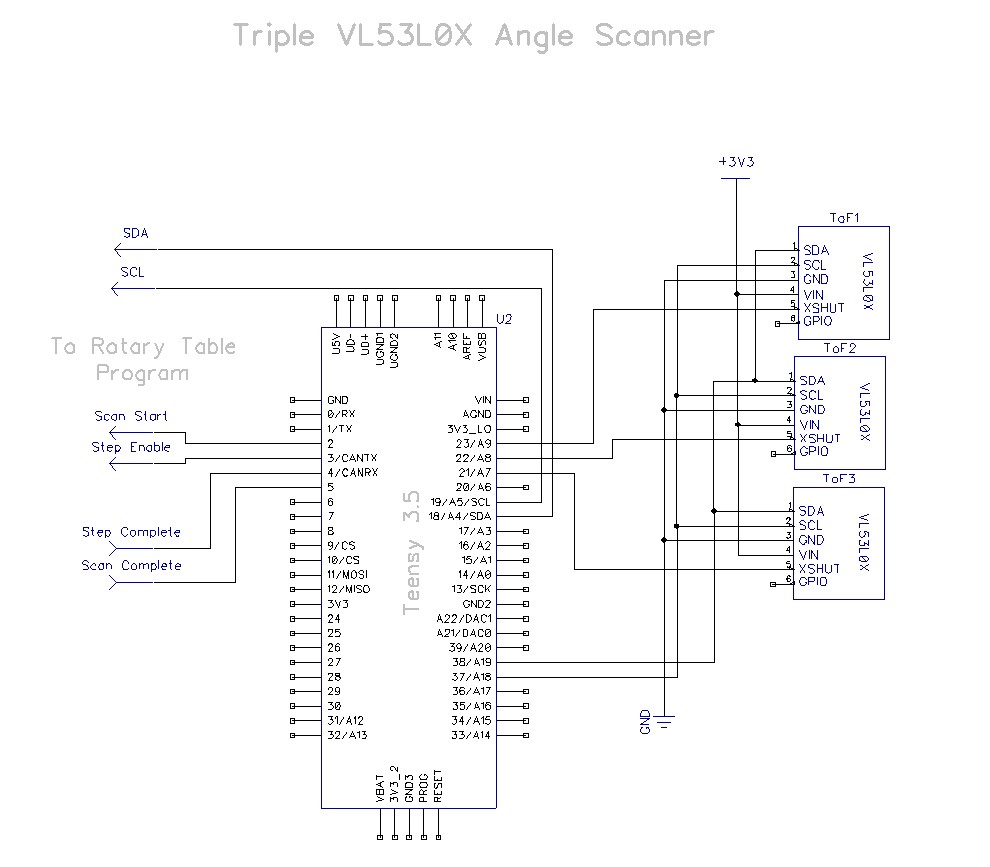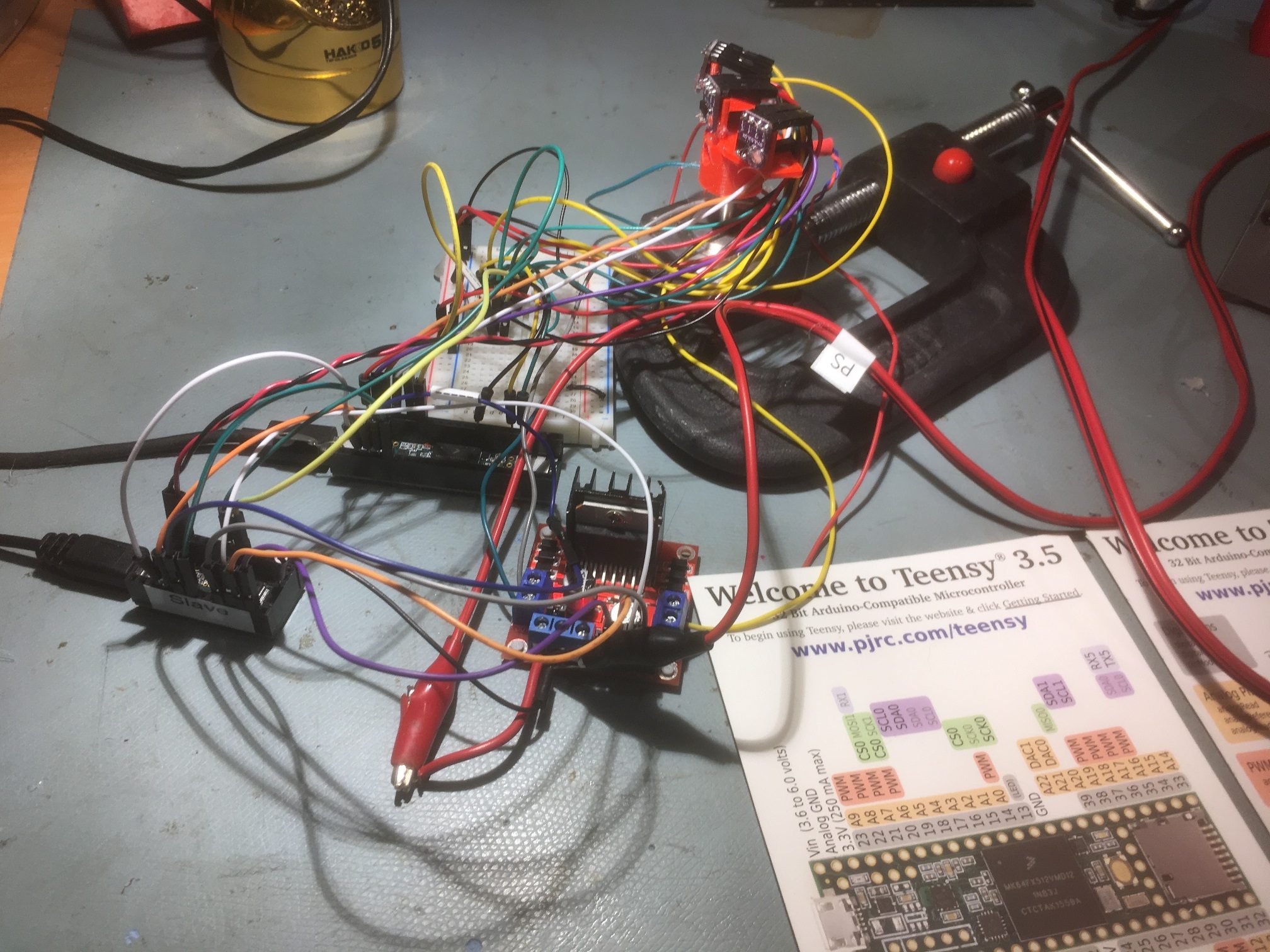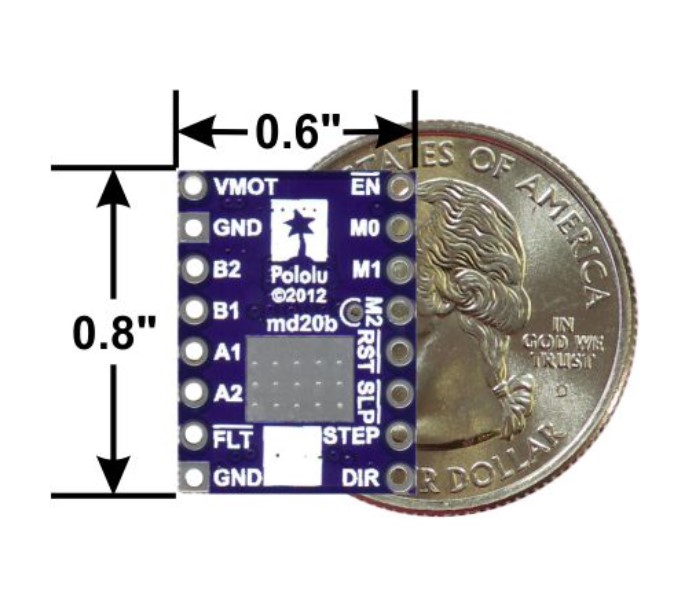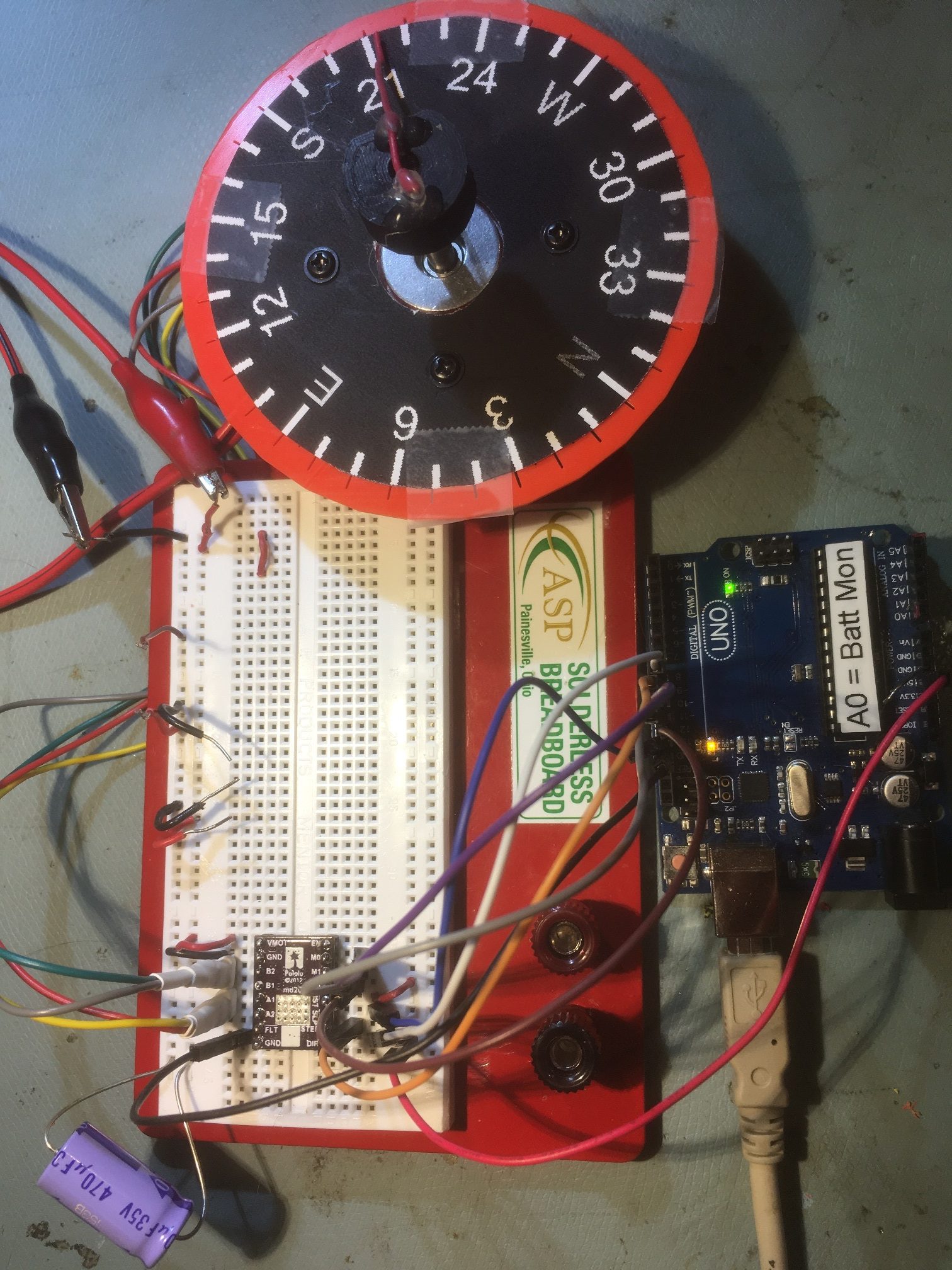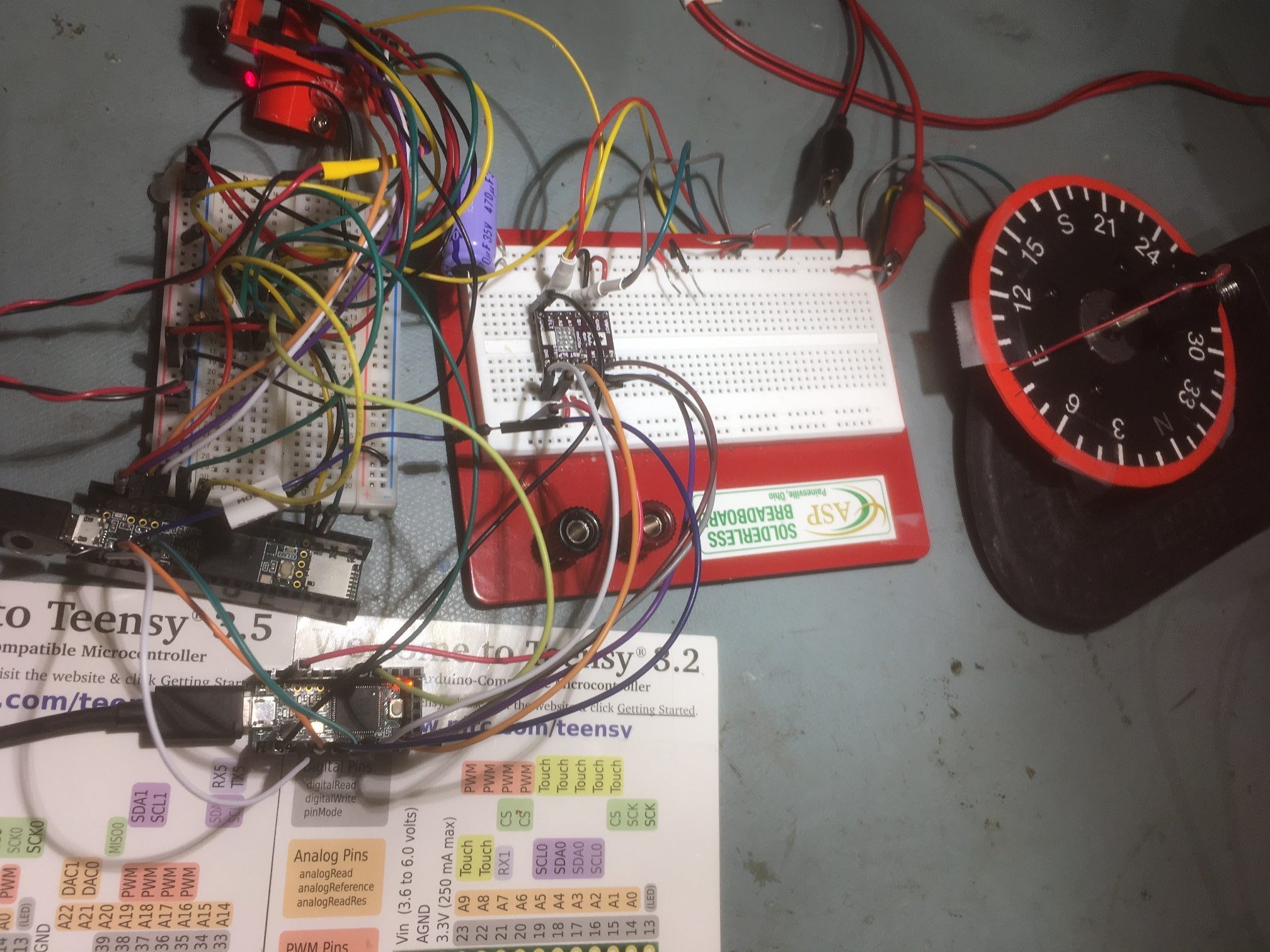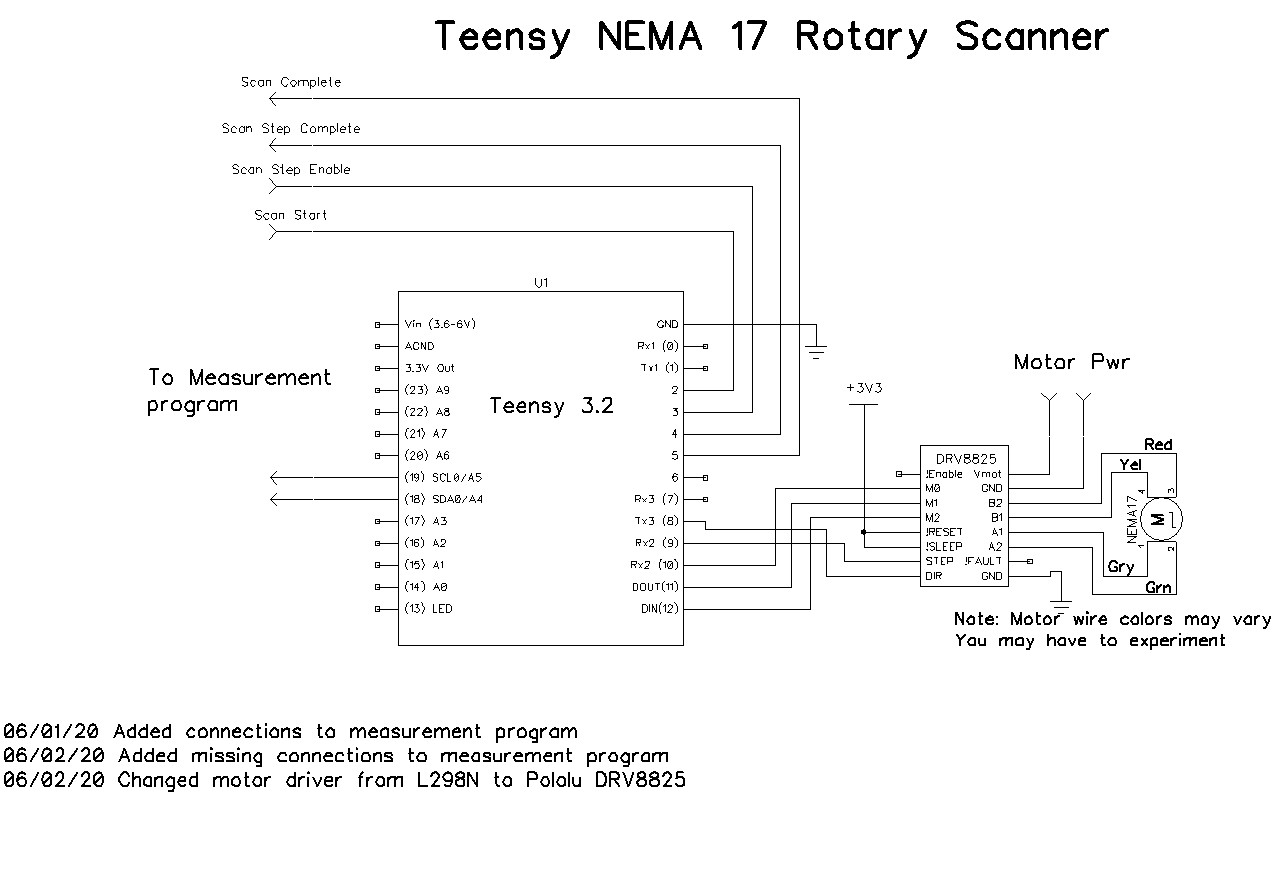Posted 05 October 2020
This post describes the successful left-side wall-tracking performance of my re-motored, re-wheeled, and re-sensored robot. Back in January of this year I was able to demonstrate reasonable wall tracking performance with my two-wheel robot using the old HC-SR04 ‘Ping’ sensors. However, I still wasn’t able to consistently track and maintain a desired wall offset, the main goal in this project stage
Since January, I have made the following changes to my larger four-wheel robot:
- Incorporated heading-based turns using the onboard MPU6050 IMU
- Developed an effective algorithm for finding the parallel heading to the nearest wall
- Replaced the two ‘ping’ sensors with two 3-element VL53L0X time-of-flight sensor arrays.
- Added a Teensy 3.5 MCU to manage the two VL53L0X sensor arrays and report distance measurements and steering values to the MEGA main MCU via I2C.
- Improved VL53L0X response by shifting to a 20 mSec measurement budget and ‘continuous’ vs ‘single’ measurements.
- Replaced the L298N motor drivers with Adafruit DRV8871 drivers.
- Replaced the wheels with custom 3D printed wheels and tires.
- Added a TIMER5 interrupt at 5Hz rate for sensor update timing
With all the changes, I had kind of lost track of the ultimate goal, which is to have the robot follow the nearest wall at a specified offset distance. All of the above updates were intended, in one way or another, to facilitate that goal, but I hadn’t yet got the robot to actually perform to expectations.
To help clear away some of the fog, I created a new version of the operating software that was pared down to just what was required to track the left wall, and nothing else. The idea was to work out all the bugs for offset capture and subsequent wall tracking with just the minimum required software, and then incorporate the modified code back into the mainstream software.
At first I was working with a 4-stage process;
- find the parallel heading to the selected wall
- drive at an angle toward the desired offset distance
- when the offset distance is obtained, turn parallel to the wall again
- track the wall at the desired offset
However, I found that the when the robot started off outside the desired wall offset, the second ‘turn to parallel’ operation took up too much space, both in terms of wall offset distance, and distance along the wall. By the time the second ‘find parallel’ operation was completed, the robot was usually much too close to the wall for effective offset tracking, meaning the entire 4-step process would have to be repeated. So, I eliminated step 3 in the process (the second ‘turn to parallel’ operation) entirely, and modified the wall tracking algorithm to capture the desired wall offset and track it. Instead of using the distance sensor measurements directly, I generate a ‘steering value’ proportional to the difference between the front and rear sensor measurements, and a target ‘steering value’ proportional to the difference between the desired offset and the center sensor measurement and use a PID controller to match the measured steering value to the target steering value. The effect of this is that the robot will track toward the offset at an angle, and then turn parallel to the wall and continue to track, as shown in the video below:
Here’s an Excel plot showing the wall offset distance versus time for the above demonstration run.
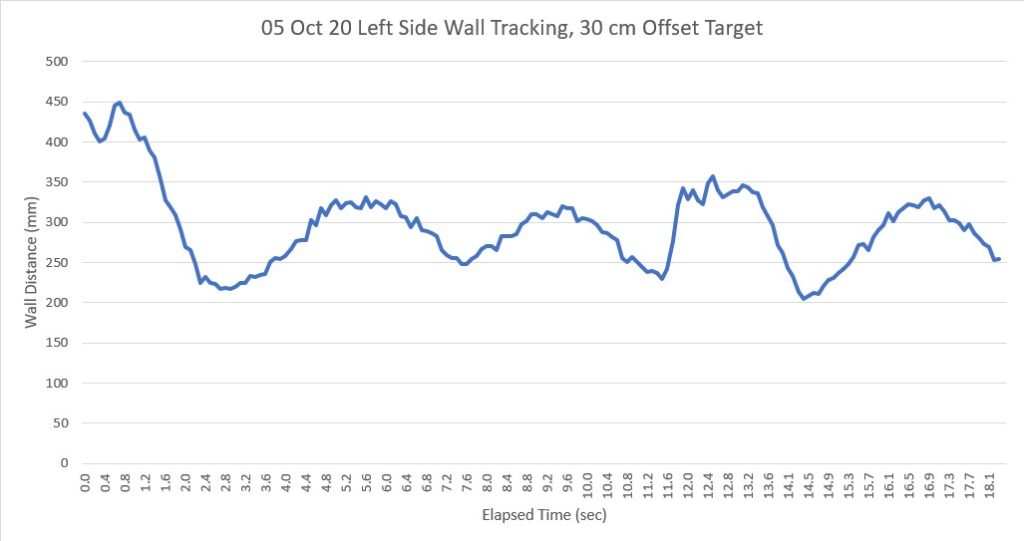
As can be seen in the above plot, the robot starts off at about 45 cm from the wall, tracks inward to capture the desired offset, and then continues to track the desired offset even when it goes around the 45-degree bend. The code that accomplished this is posted below:
|
1 2 3 4 5 6 7 8 9 10 11 12 13 14 15 16 17 18 19 20 21 22 23 24 25 26 27 28 29 30 31 32 33 34 35 36 37 38 39 40 41 42 43 44 45 46 47 48 49 50 51 52 53 54 55 56 57 58 59 60 61 62 63 64 65 66 67 68 69 70 71 72 73 74 75 76 77 78 79 80 81 82 83 84 85 86 87 88 89 90 91 92 93 94 95 96 97 98 99 100 101 102 103 104 105 106 107 108 109 110 111 112 113 114 115 116 117 118 119 120 121 122 123 124 125 126 127 128 129 130 131 132 133 134 135 136 137 138 139 140 141 142 143 144 145 146 147 148 149 150 151 152 153 154 155 156 157 158 159 160 161 162 163 164 165 166 167 168 169 170 171 172 173 174 175 176 177 178 179 180 181 182 183 184 185 186 187 188 189 190 191 192 193 194 195 196 197 198 199 200 201 202 203 204 205 206 207 208 209 210 211 212 213 214 215 216 217 218 219 220 221 222 223 224 225 226 227 228 229 230 231 232 233 234 235 236 237 238 239 240 241 242 243 244 245 246 247 248 249 250 251 252 253 254 255 256 257 258 259 260 261 262 263 264 265 266 267 268 269 270 271 272 273 274 275 276 277 278 279 280 281 282 283 284 285 286 287 288 289 290 291 292 293 294 295 296 297 298 299 300 301 302 303 304 305 306 307 308 309 310 311 312 313 314 315 316 317 318 319 320 321 322 323 324 325 326 327 328 329 330 331 332 333 334 335 336 337 338 339 340 341 342 343 344 345 346 347 348 349 350 351 352 353 354 355 356 357 358 359 360 361 362 363 364 365 366 367 368 369 370 371 372 373 374 375 376 377 378 379 380 381 382 383 384 385 386 387 388 389 390 391 392 393 394 395 396 397 398 399 400 401 402 403 404 405 406 407 408 409 410 411 412 413 414 415 416 417 418 419 420 421 422 423 424 425 426 427 428 429 430 431 432 433 434 435 436 437 438 439 440 441 442 443 444 445 446 447 448 449 450 451 452 453 454 455 456 457 458 459 460 461 462 463 464 465 466 467 468 469 470 471 472 473 474 475 476 477 478 479 480 481 482 483 484 485 486 487 488 489 490 491 492 493 494 495 496 497 498 499 500 501 502 503 504 505 506 507 508 509 510 511 512 513 514 515 516 517 518 519 520 521 522 523 524 525 526 527 528 529 530 531 532 533 534 535 536 537 538 539 540 541 542 543 544 545 546 547 548 549 550 551 552 553 554 555 556 557 558 559 560 561 562 563 564 565 566 567 568 569 570 571 572 573 574 575 576 577 578 579 580 581 582 583 584 585 586 587 588 589 590 591 592 593 594 595 596 597 598 599 600 601 602 603 604 605 606 607 608 609 610 611 612 613 614 615 616 617 618 619 620 621 622 623 624 625 626 627 628 629 630 631 632 633 634 635 636 637 638 639 640 641 642 643 644 645 646 647 648 649 650 651 652 653 654 655 656 657 658 659 660 661 662 663 664 665 666 667 668 669 670 671 672 673 674 675 676 677 678 679 680 681 682 683 684 685 686 687 688 689 690 691 692 693 694 695 696 697 698 699 700 701 702 703 704 705 706 707 708 709 710 711 712 713 714 715 716 717 718 719 720 721 722 723 724 725 726 727 728 729 730 731 732 733 734 735 736 737 738 739 740 741 742 743 744 745 746 747 748 749 750 751 752 753 754 755 756 757 758 759 760 761 762 763 764 765 766 767 768 769 770 771 772 773 774 775 776 777 778 779 780 781 782 783 784 785 786 787 788 789 790 791 792 793 794 795 796 797 798 799 800 801 802 803 804 805 806 807 808 809 810 811 812 813 814 815 816 817 818 819 820 821 822 823 824 825 826 827 828 829 830 831 832 833 834 835 836 837 838 839 840 841 842 843 844 845 846 847 848 849 850 851 852 853 854 855 856 857 858 859 860 861 862 863 864 865 866 867 868 869 870 871 872 873 874 875 876 877 878 879 880 881 882 883 884 885 886 887 888 889 890 891 892 893 894 895 896 897 898 899 900 901 902 903 904 905 906 907 908 909 910 911 912 913 914 915 916 917 918 919 920 921 922 923 924 925 926 927 928 929 930 931 932 933 934 935 936 937 938 939 940 941 942 943 944 945 946 947 948 949 950 951 952 953 954 955 956 957 958 959 960 961 962 963 964 965 966 967 968 969 970 971 972 973 974 975 976 977 978 979 980 981 982 983 984 985 986 987 988 989 990 991 992 993 994 995 996 997 998 999 1000 1001 1002 1003 1004 1005 1006 1007 1008 1009 1010 1011 1012 1013 1014 1015 1016 1017 1018 1019 1020 1021 1022 1023 1024 1025 1026 1027 1028 1029 1030 1031 1032 1033 1034 1035 1036 1037 1038 1039 1040 1041 1042 1043 1044 1045 1046 1047 1048 1049 1050 1051 1052 1053 1054 1055 1056 1057 1058 1059 1060 1061 1062 1063 1064 1065 1066 1067 1068 1069 1070 1071 1072 1073 1074 1075 1076 1077 1078 1079 1080 1081 1082 1083 1084 1085 1086 1087 1088 1089 1090 1091 1092 1093 1094 1095 1096 1097 1098 1099 1100 1101 1102 1103 1104 1105 1106 1107 1108 1109 1110 1111 1112 1113 1114 1115 1116 1117 1118 1119 1120 1121 1122 1123 1124 1125 1126 1127 1128 1129 1130 1131 1132 1133 1134 1135 1136 1137 1138 1139 1140 1141 1142 1143 1144 1145 1146 1147 1148 1149 1150 1151 1152 1153 1154 1155 1156 1157 1158 1159 1160 1161 1162 1163 1164 1165 1166 1167 1168 1169 1170 1171 1172 1173 1174 1175 1176 1177 1178 1179 1180 1181 1182 1183 1184 1185 1186 1187 1188 1189 1190 1191 1192 1193 1194 1195 1196 1197 1198 1199 1200 1201 1202 1203 1204 1205 1206 1207 1208 1209 1210 1211 1212 1213 1214 1215 1216 1217 1218 1219 1220 1221 1222 1223 1224 1225 1226 1227 1228 1229 1230 1231 1232 1233 1234 1235 1236 1237 1238 1239 1240 1241 1242 1243 1244 1245 1246 1247 1248 1249 1250 1251 1252 1253 1254 1255 1256 1257 1258 1259 1260 1261 1262 1263 1264 1265 1266 1267 1268 1269 1270 1271 1272 1273 1274 1275 1276 1277 1278 1279 1280 1281 1282 1283 1284 1285 1286 1287 1288 1289 1290 1291 1292 1293 1294 1295 1296 1297 1298 1299 1300 1301 1302 1303 1304 1305 1306 1307 1308 1309 1310 1311 1312 1313 1314 1315 1316 1317 1318 1319 1320 1321 1322 1323 1324 1325 1326 1327 1328 1329 1330 1331 1332 1333 1334 1335 1336 1337 1338 1339 1340 1341 1342 1343 1344 1345 1346 1347 1348 1349 1350 1351 1352 1353 1354 1355 1356 1357 1358 1359 1360 1361 1362 1363 1364 1365 1366 1367 1368 1369 1370 1371 1372 1373 1374 1375 1376 1377 1378 1379 1380 1381 1382 1383 1384 1385 1386 1387 1388 1389 1390 1391 1392 1393 1394 1395 1396 1397 1398 1399 1400 1401 1402 1403 1404 1405 1406 1407 1408 1409 1410 1411 1412 1413 1414 1415 1416 1417 1418 1419 1420 1421 1422 1423 1424 1425 1426 1427 1428 1429 1430 1431 1432 1433 1434 1435 1436 1437 1438 1439 1440 1441 1442 1443 1444 1445 1446 1447 1448 1449 1450 1451 1452 1453 1454 1455 1456 1457 1458 1459 1460 1461 1462 1463 1464 1465 1466 1467 1468 1469 1470 1471 1472 1473 1474 1475 1476 1477 1478 1479 1480 1481 1482 1483 1484 1485 1486 1487 1488 1489 1490 1491 1492 1493 1494 1495 1496 1497 1498 1499 1500 1501 1502 1503 1504 1505 1506 1507 1508 1509 1510 1511 1512 1513 1514 1515 1516 1517 1518 1519 1520 1521 1522 1523 1524 1525 1526 1527 1528 1529 1530 1531 1532 1533 1534 1535 1536 1537 1538 1539 1540 1541 1542 1543 1544 1545 1546 1547 1548 1549 1550 1551 1552 1553 1554 1555 1556 1557 1558 1559 1560 1561 1562 1563 1564 1565 1566 1567 1568 1569 1570 1571 1572 1573 1574 1575 1576 1577 1578 1579 1580 1581 1582 1583 1584 1585 1586 1587 1588 1589 1590 1591 1592 1593 1594 1595 1596 1597 1598 1599 1600 1601 1602 1603 1604 1605 1606 1607 1608 1609 1610 1611 1612 1613 1614 1615 1616 1617 1618 1619 1620 1621 1622 1623 1624 1625 1626 1627 1628 1629 1630 1631 1632 1633 1634 1635 1636 1637 1638 1639 1640 1641 1642 1643 1644 1645 1646 1647 1648 1649 1650 1651 1652 1653 1654 1655 1656 1657 1658 1659 1660 1661 1662 1663 1664 1665 1666 1667 1668 1669 1670 1671 1672 1673 1674 1675 1676 1677 1678 1679 1680 1681 1682 1683 1684 1685 1686 1687 1688 1689 1690 1691 1692 1693 1694 1695 1696 1697 1698 1699 1700 1701 1702 1703 1704 1705 1706 1707 1708 1709 1710 1711 1712 1713 1714 1715 1716 1717 1718 1719 1720 1721 1722 1723 1724 1725 1726 1727 1728 1729 1730 1731 1732 1733 1734 1735 1736 1737 1738 1739 1740 1741 1742 1743 1744 1745 1746 1747 1748 1749 1750 1751 1752 1753 1754 1755 1756 1757 1758 1759 1760 1761 1762 1763 1764 1765 1766 1767 1768 1769 1770 1771 1772 1773 1774 1775 1776 1777 1778 1779 1780 1781 1782 1783 1784 1785 1786 1787 1788 1789 1790 1791 1792 1793 1794 1795 1796 1797 1798 1799 1800 1801 1802 1803 1804 1805 1806 1807 1808 1809 1810 1811 1812 1813 1814 1815 1816 1817 1818 1819 1820 1821 1822 1823 1824 1825 1826 1827 1828 1829 1830 1831 1832 1833 1834 1835 1836 1837 1838 1839 1840 1841 1842 1843 1844 1845 1846 1847 1848 1849 1850 1851 1852 1853 1854 1855 1856 1857 1858 1859 1860 1861 1862 1863 1864 1865 1866 1867 1868 1869 1870 1871 1872 1873 1874 1875 1876 1877 1878 1879 1880 1881 1882 1883 1884 1885 1886 1887 1888 1889 1890 1891 1892 1893 1894 1895 1896 1897 1898 1899 1900 1901 1902 1903 1904 1905 1906 1907 1908 1909 1910 1911 1912 1913 1914 1915 1916 1917 1918 1919 1920 1921 1922 1923 1924 1925 1926 1927 1928 1929 1930 1931 1932 1933 1934 1935 1936 1937 1938 1939 1940 1941 1942 1943 1944 1945 1946 1947 1948 1949 1950 1951 1952 1953 1954 1955 1956 1957 1958 1959 1960 1961 1962 1963 1964 1965 1966 1967 1968 1969 1970 1971 1972 1973 1974 1975 1976 1977 1978 1979 1980 1981 1982 1983 1984 1985 1986 1987 1988 1989 1990 1991 1992 1993 1994 1995 1996 1997 1998 1999 2000 2001 2002 2003 2004 2005 2006 2007 2008 2009 2010 2011 2012 2013 2014 2015 2016 2017 2018 2019 2020 2021 2022 2023 2024 2025 2026 2027 2028 2029 2030 2031 2032 2033 2034 2035 2036 2037 2038 2039 2040 2041 2042 2043 2044 2045 2046 2047 2048 2049 2050 2051 2052 2053 2054 2055 2056 2057 2058 2059 2060 2061 2062 2063 2064 2065 2066 2067 2068 2069 2070 2071 2072 2073 2074 2075 2076 2077 2078 2079 2080 2081 2082 2083 2084 2085 2086 2087 2088 2089 2090 2091 2092 2093 2094 2095 2096 2097 2098 2099 2100 2101 2102 2103 2104 2105 2106 2107 2108 2109 2110 2111 2112 2113 2114 2115 2116 2117 2118 2119 2120 2121 2122 2123 2124 2125 2126 2127 2128 2129 2130 2131 2132 2133 2134 2135 2136 2137 2138 2139 2140 2141 2142 2143 2144 2145 2146 2147 2148 2149 2150 2151 2152 2153 2154 2155 2156 2157 2158 2159 2160 2161 2162 2163 2164 2165 2166 2167 2168 2169 2170 2171 2172 2173 2174 2175 2176 2177 2178 2179 2180 2181 2182 2183 2184 2185 2186 2187 2188 2189 2190 2191 2192 2193 2194 2195 2196 2197 2198 2199 2200 2201 2202 2203 2204 2205 2206 2207 2208 2209 2210 2211 2212 2213 2214 2215 2216 2217 2218 2219 2220 2221 2222 2223 2224 2225 2226 2227 2228 2229 2230 2231 2232 2233 2234 2235 2236 2237 2238 2239 2240 2241 2242 2243 2244 2245 2246 2247 2248 2249 2250 2251 2252 2253 2254 2255 2256 2257 2258 2259 2260 2261 2262 2263 2264 2265 2266 2267 2268 2269 2270 2271 2272 2273 2274 2275 2276 2277 2278 2279 2280 2281 2282 2283 2284 2285 2286 2287 2288 2289 2290 2291 2292 2293 2294 2295 2296 2297 2298 2299 2300 2301 2302 2303 2304 2305 2306 2307 2308 2309 2310 2311 2312 2313 2314 2315 2316 2317 2318 2319 2320 2321 2322 2323 2324 2325 2326 2327 2328 2329 2330 2331 2332 2333 2334 2335 2336 2337 2338 2339 2340 2341 2342 2343 2344 2345 2346 2347 2348 2349 2350 2351 2352 2353 2354 2355 2356 2357 2358 2359 2360 2361 2362 2363 2364 2365 2366 2367 2368 2369 2370 2371 2372 2373 2374 2375 2376 2377 2378 2379 2380 2381 2382 2383 2384 2385 2386 2387 2388 2389 2390 2391 2392 2393 2394 2395 2396 2397 2398 2399 2400 2401 2402 2403 2404 2405 2406 2407 2408 2409 2410 2411 2412 2413 2414 2415 2416 2417 2418 2419 2420 2421 2422 2423 2424 2425 2426 2427 2428 2429 2430 2431 2432 2433 2434 2435 2436 2437 2438 2439 2440 2441 2442 2443 2444 2445 2446 2447 2448 2449 2450 2451 2452 2453 2454 2455 2456 2457 2458 2459 2460 2461 2462 2463 2464 2465 2466 2467 2468 2469 2470 2471 2472 2473 2474 2475 2476 2477 2478 2479 2480 2481 2482 2483 2484 2485 2486 2487 2488 2489 2490 2491 2492 2493 2494 2495 2496 2497 2498 2499 2500 2501 2502 2503 2504 2505 2506 2507 2508 2509 2510 2511 2512 2513 2514 2515 2516 2517 2518 2519 2520 2521 2522 2523 2524 2525 2526 2527 2528 2529 2530 2531 2532 2533 2534 2535 2536 2537 2538 2539 2540 2541 2542 2543 2544 2545 2546 2547 2548 2549 2550 2551 2552 2553 2554 2555 2556 2557 2558 2559 2560 2561 2562 2563 2564 2565 2566 2567 2568 2569 2570 2571 2572 2573 2574 2575 2576 2577 2578 2579 2580 2581 2582 2583 2584 2585 2586 2587 2588 2589 2590 2591 2592 2593 2594 2595 2596 2597 2598 2599 2600 2601 2602 2603 2604 2605 2606 2607 2608 2609 2610 2611 2612 2613 2614 2615 2616 2617 2618 2619 2620 2621 2622 2623 2624 2625 2626 2627 2628 2629 2630 2631 2632 2633 2634 2635 2636 2637 2638 2639 2640 2641 2642 2643 2644 2645 2646 2647 2648 2649 2650 2651 2652 2653 2654 2655 2656 2657 2658 2659 2660 2661 2662 2663 2664 2665 2666 2667 2668 2669 2670 2671 2672 2673 2674 2675 2676 2677 2678 2679 2680 2681 2682 2683 2684 2685 2686 2687 2688 2689 2690 2691 2692 2693 2694 2695 2696 2697 2698 2699 2700 2701 2702 2703 2704 2705 2706 2707 2708 2709 2710 2711 2712 2713 2714 2715 2716 2717 2718 2719 2720 2721 2722 2723 2724 2725 2726 2727 2728 2729 2730 2731 2732 2733 2734 2735 2736 2737 2738 2739 2740 2741 2742 2743 2744 2745 2746 2747 2748 2749 2750 2751 2752 2753 2754 2755 2756 2757 2758 2759 2760 2761 2762 2763 2764 2765 2766 2767 2768 2769 2770 2771 2772 2773 2774 2775 2776 2777 2778 2779 2780 2781 2782 2783 2784 2785 2786 2787 2788 2789 2790 2791 2792 2793 2794 2795 2796 2797 2798 2799 2800 2801 2802 2803 2804 2805 2806 2807 2808 2809 2810 2811 2812 2813 2814 2815 2816 2817 2818 2819 2820 2821 2822 2823 2824 2825 2826 2827 2828 2829 2830 2831 2832 2833 2834 2835 2836 2837 2838 2839 2840 2841 2842 2843 2844 2845 2846 2847 2848 2849 2850 2851 2852 2853 2854 2855 2856 2857 2858 2859 2860 2861 2862 2863 2864 2865 2866 2867 2868 2869 2870 2871 2872 2873 2874 2875 2876 2877 2878 2879 2880 2881 2882 2883 2884 2885 2886 2887 2888 2889 2890 2891 2892 2893 2894 2895 2896 2897 2898 2899 2900 2901 2902 2903 2904 2905 2906 2907 2908 2909 2910 2911 2912 2913 2914 2915 2916 2917 2918 2919 2920 2921 2922 2923 2924 2925 2926 2927 2928 2929 2930 2931 2932 2933 2934 2935 2936 2937 2938 2939 2940 2941 2942 2943 2944 2945 2946 2947 2948 2949 2950 2951 2952 2953 2954 2955 2956 2957 2958 2959 2960 2961 2962 2963 2964 2965 2966 2967 2968 2969 2970 2971 2972 2973 2974 2975 2976 2977 2978 2979 2980 2981 2982 2983 2984 2985 2986 2987 2988 2989 2990 2991 2992 2993 2994 2995 2996 2997 2998 2999 3000 3001 3002 3003 3004 3005 3006 3007 3008 3009 3010 3011 3012 3013 3014 3015 3016 3017 3018 3019 3020 3021 3022 3023 3024 3025 3026 3027 3028 3029 3030 3031 3032 3033 3034 3035 3036 3037 3038 3039 3040 3041 3042 3043 3044 3045 3046 3047 3048 3049 3050 3051 3052 3053 3054 3055 3056 3057 3058 3059 3060 3061 3062 3063 3064 3065 3066 3067 3068 3069 3070 3071 3072 3073 3074 3075 3076 3077 3078 3079 3080 3081 3082 3083 3084 3085 3086 3087 3088 3089 3090 3091 3092 3093 3094 3095 3096 3097 3098 3099 3100 3101 3102 3103 3104 3105 3106 3107 3108 3109 3110 3111 3112 3113 3114 3115 3116 3117 3118 3119 3120 3121 3122 3123 3124 3125 3126 3127 3128 3129 3130 3131 3132 3133 3134 3135 3136 3137 3138 3139 3140 3141 3142 3143 3144 3145 3146 3147 3148 3149 3150 3151 3152 3153 3154 3155 3156 3157 3158 3159 3160 3161 3162 3163 3164 3165 3166 3167 3168 3169 3170 3171 3172 3173 3174 3175 3176 3177 3178 3179 3180 3181 3182 3183 3184 3185 3186 3187 3188 3189 3190 3191 3192 3193 3194 3195 3196 3197 3198 3199 3200 3201 3202 3203 3204 3205 3206 3207 3208 3209 3210 3211 3212 3213 3214 3215 3216 3217 3218 3219 3220 3221 3222 3223 3224 3225 3226 3227 3228 3229 3230 3231 3232 3233 3234 3235 3236 3237 3238 3239 3240 3241 3242 3243 3244 3245 3246 3247 3248 3249 3250 3251 3252 3253 3254 3255 3256 3257 3258 3259 3260 3261 3262 3263 3264 3265 3266 3267 3268 3269 3270 3271 3272 3273 3274 3275 3276 3277 3278 3279 3280 3281 3282 3283 3284 3285 3286 3287 3288 3289 3290 3291 3292 3293 3294 3295 3296 3297 3298 3299 3300 3301 3302 3303 3304 3305 3306 3307 3308 3309 3310 3311 3312 3313 3314 3315 3316 3317 3318 3319 3320 3321 3322 3323 3324 3325 3326 3327 3328 3329 3330 3331 3332 3333 3334 3335 3336 3337 3338 3339 3340 3341 3342 3343 3344 3345 3346 3347 3348 3349 3350 3351 3352 3353 3354 3355 3356 3357 3358 3359 3360 3361 3362 3363 3364 3365 3366 3367 3368 3369 3370 3371 3372 3373 3374 3375 3376 3377 3378 3379 3380 3381 3382 3383 3384 3385 3386 3387 3388 3389 3390 3391 3392 3393 3394 3395 3396 3397 3398 3399 3400 3401 3402 3403 3404 3405 3406 3407 3408 3409 3410 3411 3412 3413 3414 3415 3416 3417 3418 3419 3420 3421 3422 3423 3424 3425 3426 3427 3428 3429 3430 3431 3432 3433 3434 3435 3436 3437 3438 3439 3440 3441 3442 3443 3444 3445 3446 3447 3448 3449 3450 3451 3452 3453 3454 3455 3456 3457 3458 3459 3460 3461 3462 3463 3464 3465 3466 3467 3468 3469 3470 3471 3472 3473 3474 3475 3476 3477 3478 3479 3480 3481 3482 3483 3484 3485 3486 3487 3488 3489 3490 3491 3492 3493 3494 3495 3496 3497 3498 3499 3500 3501 3502 3503 3504 3505 3506 3507 3508 3509 3510 3511 3512 3513 3514 3515 3516 3517 3518 3519 3520 3521 3522 3523 3524 3525 3526 3527 3528 3529 3530 3531 3532 3533 3534 3535 3536 3537 3538 3539 3540 3541 3542 3543 3544 3545 3546 3547 3548 3549 3550 3551 3552 3553 3554 3555 3556 3557 3558 3559 3560 3561 3562 3563 3564 3565 3566 3567 3568 3569 3570 3571 3572 3573 3574 3575 3576 3577 3578 3579 3580 3581 3582 3583 3584 3585 3586 3587 3588 3589 3590 3591 3592 3593 3594 3595 3596 3597 3598 3599 3600 3601 3602 3603 3604 3605 3606 3607 3608 3609 3610 3611 3612 3613 3614 3615 3616 3617 3618 3619 3620 3621 3622 3623 3624 3625 3626 3627 3628 3629 3630 3631 3632 3633 3634 3635 3636 3637 3638 3639 3640 3641 3642 3643 3644 3645 3646 3647 3648 3649 3650 3651 3652 3653 3654 3655 3656 3657 3658 3659 3660 3661 3662 3663 3664 3665 3666 3667 3668 3669 3670 3671 3672 3673 3674 3675 3676 3677 3678 3679 3680 3681 3682 3683 3684 3685 3686 3687 3688 3689 3690 3691 3692 3693 3694 3695 3696 3697 3698 3699 3700 3701 3702 3703 3704 3705 3706 3707 3708 3709 3710 3711 3712 3713 3714 3715 3716 3717 3718 3719 3720 3721 3722 3723 3724 3725 3726 3727 3728 3729 3730 3731 3732 3733 3734 3735 3736 3737 3738 3739 3740 3741 3742 3743 3744 3745 3746 3747 3748 3749 3750 3751 3752 3753 3754 3755 3756 3757 3758 3759 3760 3761 3762 3763 3764 3765 3766 3767 3768 3769 3770 3771 3772 3773 3774 3775 3776 3777 3778 3779 3780 3781 3782 3783 3784 3785 3786 3787 3788 3789 3790 3791 3792 3793 3794 3795 3796 3797 3798 3799 3800 3801 3802 3803 3804 3805 3806 3807 3808 3809 3810 3811 3812 3813 3814 3815 3816 3817 3818 3819 3820 3821 3822 3823 3824 3825 3826 3827 3828 3829 3830 3831 3832 3833 3834 3835 3836 3837 3838 3839 3840 3841 3842 3843 3844 3845 3846 3847 3848 3849 3850 3851 3852 3853 3854 3855 3856 3857 3858 3859 3860 3861 3862 3863 3864 3865 3866 3867 3868 3869 3870 3871 3872 3873 3874 3875 3876 3877 3878 3879 3880 3881 3882 3883 3884 3885 3886 3887 3888 3889 3890 3891 3892 3893 3894 3895 3896 |
/* Name: FourWD_WallE2_V7.ino Created: 9/24/2020 11:03:59 AM Author: FRANKNEWXPS15\Frank */ #define TIMER_INT_OUTPUT_PIN 51 //scope monitor pin #pragma region INCLUDES #include <avr/sleep.h> //needed for sleep_enable() & sleep_cpu() functions #include <elapsedMillis.h> #include <PrintEx.h> //allows printf-style printout syntax #include "MPU6050_6Axis_MotionApps_V6_12.h" //changed to this version 10/05/19 #include "I2Cdev.h" //02/19/19: this includes SBWire.h #include "I2C_Anything.h" //needed for sending float data over I2C #include "Adafruit_FRAM_I2C.h" #include "RTClib.h" //07/11/20 this MUST be the #include "file" form for the "Local files override.." option to work #include <PID.h> //moved here 02/09/19 #include <limits.h> //added 04/19/19 #pragma endregion Includes #pragma region DEFINES //02/29/16 hardware defines //#define NO_MOTORS //#define NO_LIDAR //#define NO_PINGS //#define NO_IRDET //added 04/05/17 for daytime in-atrium testing (too much ambient IR) //#define DISTANCES_ONLY //added 11/14/18 to just display distances in infinite loop #define NO_FRAM_TELEMETRY //added 11/14/18 //#define FORCE_RTC_TO_LAST_COMPILE_TIME //added 02/18/19. Forces RTC to last compile time #define NO_STUCK //added 03/10/19 to disable 'stuck' detection //#define BATTERY_DISCHARGE //added 03/04/20 to discharge battery safely #define NO_POST //added 04/12/20 to skip all the POST checks #pragma endregion Program #Defines #pragma region PRE_SETUP StreamEx mySerial = Serial; //added 03/18/18 for printf-style printing Adafruit_FRAM_I2C fram = Adafruit_FRAM_I2C(); //I2C addr = 0x50 (default) //FramPacket.h holds 'inline' definition of CFRAMStatePacket class /*this has to come after the following lines #include "Adafruit_FRAM_I2C.h" Adafruit_FRAM_I2C fram = Adafruit_FRAM_I2C(); StreamEx mySerial = Serial; //added 03/18/18 for printf-style printing */ #include "FramPacket.h" //tri-sensor board RTC_DS3231 rtc; //I2C addr = 0x68 MPU6050 mpu(0x69); //06/23/18 chg to AD0 high addr, using INT connected to Mega pin 2 (INT0) CFRAMStatePacket FramPacket = CFRAMStatePacket(&fram); //this object is used for all FRAM transactions const char daysOfTheWeek[7][12] = { "Sunday", "Monday", "Tuesday", "Wednesday", "Thursday", "Friday", "Saturday" };//used for RTC date/time readouts //added 01/30/17 for IR homing support #pragma region IRHOMING uint8_t IR_HOMING_MODULE_SLAVE_ADDR = 8; //uint8_t type reqd here for Wire.requestFrom() call double IRHomingSetpoint, IRHomingLRSteeringVal, IRHomingOutput;//10/06/17 chg input variable name to something more descriptive PID IRHomingPID(&IRHomingLRSteeringVal, &IRHomingOutput, &IRHomingSetpoint, 1000, 0.0, 200.0, REVERSE);//10/15/17 'final' setup const long IR_BEAM_DETECTION_CHANNEL_MAX = 2621440; const long IR_BEAM_DETECTION_THRESHOLD = 10000; #pragma endregion IR Homing Parameters #pragma region ENUMS //01/05/16 enum types cannot be used as arguments or return types for functions due to Arduino pre-processor quirk //12/20/15 added for navigation support //01/15/16 revised to be consistent wtih nav modes identified in https://fpaynter.com/2016/01/making-wall-e2-smarter-using-karnaugh-maps/ enum NavCases { NAV_NONE = 0, NAV_WALLTRK, NAV_OBSTACLE, NAV_STEPTURN, NAV_STUCK, NAV_OPENCNR }; //04/10/20 Experiment with porting heading based tracking capability from two wheel robot enum TrackingState { TRK_RIGHT_NONE, TRK_RIGHT_CAPTURE, TRK_RIGHT_MAINTAIN, TRK_RIGHT_BACKUP_AND_TURN, TRK_RIGHT_STEP_TURN }; const char* NavStrArray[] = { "WallTrack", "Obstacle", "StepTurn", "Stuck", "OpenCorner" }; //03/08/17 added for new mode/state definitions; see https://fpaynter.com/2017/03/wall-e2-operating-mode-review/ enum OpModes { MODE_NONE = 0, //04/04/17 chg from MODE_DEFAULT and moved to top (zero) position MODE_CHARGING, MODE_IRHOMING, MODE_WALLFOLLOW, MODE_DEADBATTERY, //added 01/16/18 to handle dead battery case MODE_DISCHARGE //added 03/04/20 to safely discharge the battery }; const char* ModeStrArray[] = { "None", "Charge", "Home", "Wall", "DeadBatt", "Discharge" }; const char* LongModeStrArray[] = { "None", "Charging", "IR Homing", "Wall Following", "Dead Battery", "Discharging" }; enum WallTrackingCases { TRACKING_NONE = 0, TRACKING_LEFT, TRACKING_RIGHT, TRACKING_NEITHER }; const char* TrkStrArray[] = { "None", "Left", "Right", "Neither" }; #pragma endregion Tracking and Nav Case Enums #pragma region BATTCONSTS //03/10/15 added for battery charge level monitoring //const int LOW_BATT_THRESH_VOLTS = 7.4; //50% chg per http://batteryuniversity.com/learn/article/lithium_based_batteries const int LOW_BATT_THRESH_VOLTS = 8.4; //07/10/20 temp debug settingr//50% chg per http://batteryuniversity.com/learn/article/lithium_based_batteries const int MAX_AD_VALUE = 1023; const long BATT_CHG_TIMEOUT_SEC = 36000; //10 HRS, for test only //const long BATT_CHG_TIMEOUT_MIN = 120; //2 hours. Chg to min vs sec 01/09/18 const float DEAD_BATT_THRESH_VOLTS = 6; //added 01/24/17 //const float DEAD_BATT_THRESH_VOLTS = 6.2; //chg to 6.2 03/02/19 per https://www.fpaynter.com/2019/03/better-battery-charging-for-wall-e2/ //const float FULL_BATT_VOLTS = 8.2; //added 03/17/18. Chg to 8.2 02/24/19 const float FULL_BATT_VOLTS = 8.4; //added 03/17/18. Chg to 8.4 03/05/20 const int MINIMUM_CHARGE_TIME_SEC = 10; //added 04/01/18 const float VOLTAGE_TO_CURRENT_RATIO = 0.75f; //Volts/Amp rev 03/01/19. Used for both 'Total' and 'Run' sensors const float FULL_BATT_CURRENT_THRESHOLD = 0.5; //amps chg to 0.5A 03/02/19 per https://www.fpaynter.com/2019/03/better-battery-charging-for-wall-e2/ const int CURRENT_AVERAGE_NUMBER = 10; //added 03/01/19 const int VOLTS_AVERAGE_NUMBER = 5; //added 03/01/19 const int IR_HOMING_TELEMETRY_SPACING_MSEC = 200; //added 04/23/20 //battery fuel guage constants const float _20PCT_BATT_VOLTS = DEAD_BATT_THRESH_VOLTS + 0.2f * (FULL_BATT_VOLTS - DEAD_BATT_THRESH_VOLTS); const float _40PCT_BATT_VOLTS = DEAD_BATT_THRESH_VOLTS + 0.4f * (FULL_BATT_VOLTS - DEAD_BATT_THRESH_VOLTS); const float _60PCT_BATT_VOLTS = DEAD_BATT_THRESH_VOLTS + 0.6f * (FULL_BATT_VOLTS - DEAD_BATT_THRESH_VOLTS); const float _80PCT_BATT_VOLTS = DEAD_BATT_THRESH_VOLTS + 0.8f * (FULL_BATT_VOLTS - DEAD_BATT_THRESH_VOLTS); const float ZENER_VOLTAGE_OFFSET = 5.84; //measured zener voltage const float ADC_REF_VOLTS = 3.3; //03/27/18 now using analogReference(EXTERNAL) with Teensy 3.3V connected to AREF #pragma endregion Battery Constants #pragma region DISTANCE_MEASUREMENT_SUPPORT //misc LIDAR and Ping sensor parameters const int MIN_OBS_DIST_CM = 20; //rev 04/28/17 for better obstacle handling const int CHG_STN_AVOIDANCE_DIST_CM = 30; //added 03/11/17 for charge stn avoidance //const int STEPTURN_DIST_CM = 80; //rev 04/28/17 to be indep of MIN_OBS_DIST_CM //const int STEPTURN_DIST_CM = 0; //rev 05/16/20 to temporarily disable const int STEPTURN_DIST_CM = 50; //rev 06/29/20 to temporarily disable const int MAX_FRONT_DISTANCE_CM = 400; const int MAX_LR_DISTANCE_CM = 200; //04/19/15 now using sep parameters for front and side sensors //const int MIN_PING_INTERVAL_MSEC = 200; //rev 03/12/16 //const int MIN_PING_INTERVAL_MSEC = 50; //rev 10/03/20 const int MIN_PING_INTERVAL_MSEC = 30; //rev 10/03/20 const int CHG_STN_FINAL_APPR_DIST_CM = 20; //added 03/11/17 for charge stn avoidance //04/01/2015 added for 'stuck' detection support const int FRONT_DIST_ARRAY_SIZE = 25; //04/28/19 - final value (I hope) const int FRONT_DIST_AVG_WINDOW_SIZE = 3; //moved here & renamed 04/28/19 const int LR_PING_DIST_ARRAY_SIZE = 3; //04/28/19 added to reinstate l/r dist running avg const int LR_PING_AVG_WINDOW_SIZE = 3; //added 04/28/19 so front & lr averages can differ const int STUCK_FRONT_VARIANCE_THRESHOLD = 50; //chg to 50 04/28/17 //const int STUCK_FRONT_VARIANCE_THRESHOLD = 0; //chg to 0 09/15/18 const int NO_LIDAR_FRONT_VAR_VAL = 10 * STUCK_FRONT_VARIANCE_THRESHOLD; //01/16/19 uint16_t aFrontDist[FRONT_DIST_ARRAY_SIZE]; //04/18/19 rev to use uint16_t vs byte //04/28/19 added to reinstate l/r dist running avg //06/28/20 chg to uint_16 to accommodate change from cm to mm //byte aLeftDist[LR_PING_DIST_ARRAY_SIZE]; //byte aRightDist[LR_PING_DIST_ARRAY_SIZE]; uint16_t aLeftDist[LR_PING_DIST_ARRAY_SIZE]; uint16_t aRightDist[LR_PING_DIST_ARRAY_SIZE]; //added 12/26/14 for wall following support int prevleftdistval = 0; int prevrightdistval = 0; int prevfrontdistcm = 0; int curMinObstacleDistance = MIN_OBS_DIST_CM;//added 03/11/17 for chg stn avoidance //04/13/20 moved distance vars up here so can be initialized just before loop() int leftdistval = 0; int rightdistval = 0; int frontdistval = 0; //double frontvar = 0; volatile double frontvar = 0; //08/11/20 now updated in timer1 ISR #pragma endregion Distance Measurement Support #pragma region MOTOR_PARAMETERS //drive wheel speed parameters const int MOTOR_SPEED_FULL = 200; //range is 0-255 const int MOTOR_SPEED_MAX = 255; //range is 0-255 const int MOTOR_SPEED_HALF = 127; //range is 0-255 const int MOTOR_SPEED_QTR = 75; //added 09/25/20 const int MOTOR_SPEED_LOW = 50; //added 01/22/15 const int MOTOR_SPEED_OFF = 0; //range is 0-255 const int MOTOR_SPEED_CAPTURE_OFFSET = 75; //added 06/21/20 for offset capture //const int MOTOR_SPEED_CAPTURE_OFFSET = 125; //added 06/28/20 for offset capture const int MOTOR_SPEED_ADJ_FACTOR = 40; //chg to 40 at 5:55pm const int LEFT_SPEED_COMP_VAL_FWD = 15; //left speed compensation value const int RIGHT_SPEED_COMP_VAL_FWD = -LEFT_SPEED_COMP_VAL_FWD; //right speed compensation value const int LEFT_SPEED_COMP_VAL_REV = 5; //left speed compensation value const int RIGHT_SPEED_COMP_VAL_REV = -LEFT_SPEED_COMP_VAL_REV; //right speed compensation value //drive wheel direction constants const boolean FWD_DIR = true; const boolean REV_DIR = !FWD_DIR; //Motor direction variables boolean bLeftMotorDirIsFwd = true; boolean bRightMotorDirIsFwd = true; bool bIsForwardDir = true; //default is foward direction #pragma endregion Motor Parameters #pragma region HEADING_BASED_TURN_PARAMS //09/11/18 new heading-based turn support constants const int ESS_TURN_DEG = 45; const int QUARTER_TURN_DEG = 90; const float DEFAULT_HDG_JUMP_VAL = 20.f; const int DEFAULT_TURN_DEG = QUARTER_TURN_DEG; const float ROLLING_TURN_MAX_SEC_PER_DEG = 1 / 15.0; //used to limit time in rolling turns //const int OFFSIDE_MOTOR_SPEED = MOTOR_SPEED_LOW; //const int OFFSIDE_MOTOR_SPEED = 0; //03/04/20 debug const int OFFSIDE_MOTOR_SPEED = 25; //03/04/20 turn debug - leave at this value for now const int DRIVESIDE_MOTOR_SPEED_HIGH = MOTOR_SPEED_MAX; const int DRIVESIDE_MOTOR_SPEED_HALF = MOTOR_SPEED_HALF;//added 02/16/20 for wall tracking support const int DRIVESIDE_MOTOR_SPEED_LOW = MOTOR_SPEED_HALF; const long MSEC_PER_HDG_CHECK = 100; //added 08/29/18 const float HDG_NEAR_MATCH_VAL = 0.9; //slow the turn down here //const float HDG_FULL_MATCH_VAL = 0.98; //stop the turn here const float HDG_FULL_MATCH_VAL = 0.99; //stop the turn here //rev 05/17/20 const float HDG_MIN_MATCH_VAL = 0.6; //added 09/08/18: don't start checking slope until turn is well started elapsedMillis sinceLastTimeCheck; //used for rolling turn timeout #pragma endregion Heading-based turn support parameters #pragma region VL53L0X_TOF_LIDAR_SUPPORT //const int ToFArray_PARALLEL_FIND_Kp = 800; //const int ToFArray_PARALLEL_FIND_Kp = 80; //const int ToFArray_PARALLEL_FIND_Kp = 120; const int ToFArray_PARALLEL_FIND_Kp = 200; const int ToFArray_PARALLEL_FIND_Ki = 20; //added 09/22/20 const int ToFArray_PARALLEL_FIND_Kd = 0; //added 09/22/20 //const float ToFArray_PARALLEL_FIND_SETPOINT = 0.05; //09/22/20 moved here const float ToFArray_PARALLEL_FIND_SETPOINT = 0.01; //09/22/20 moved here const int ToFArray_OFFSET_CAPTURE_Kp = 200; //const int ToFArray_OFFSET_CAPTURE_Ki = 0; //06/28/20 const int ToFArray_OFFSET_CAPTURE_Ki = 50; const int ToFArray_OFFSET_CAPTURE_Kd = 50; const int ToFArray_OFFSET_TRACK_Kp = 10; const int ToFArray_OFFSET_TRACK_Kd = 0; //const int ToFArray_OFFSET_TRACK_Kd = 50; double LeftSteeringVal, RightSteeringVal; //added 08/06/20 double ToFSetpoint, ToFSteeringVal, ToFOutput;//10/06/17 chg input variable name to something more descriptive PID ToFArrayPID(&ToFSteeringVal, &ToFOutput, &ToFSetpoint, ToFArray_PARALLEL_FIND_Kp, 0.0, 0.0, DIRECT);//06/19/20 use this for now const int ROTATE_TO_PARALLEL_TELEMETRY_SPACING_MSEC = 200; const float PARALLEL_ORIENTATION_STEERING_VALUE_THRESHOLD = 0.1; //rev 06/21/20 - now using (F-R)/100 //const float CAPTURE_APPROACH_STEERING_VALUE = 0.2; //added 06/21/20 - now using (F-R)/100 const float CAPTURE_APPROACH_STEERING_VALUE = 0.4; //rev 06/28/20 - now using (F-R)/100 //const float WALL_OFFSET_CAPTURE_WINDOW_CM = 5.0; //just a guess const float WALL_OFFSET_CAPTURE_WINDOW_CM = 2.0; //just a guess const int VL53L0X_I2C_SLAVE_ADDRESS = 0x20; ////Teensy 3.5 VL53L0X ToF LIDAR controller //Sensor data values int Lidar_RightFront; int Lidar_RightCenter; int Lidar_RightRear; int Lidar_LeftFront; int Lidar_LeftCenter; int Lidar_LeftRear; elapsedMillis lastToFArrayTelemetryMsec; //used to space out telemetry prints enum VL53L0X_REQUEST { VL53L0X_CENTERS_ONLY, VL53L0X_RIGHT, VL53L0X_LEFT, VL53L0X_BOTH //added 08/06/20 }; #pragma endregion VL53L0X ToF LIDAR Support //vvvvvvvvvvvvvvvvvvvvvvvvvvvvvvvvvvvvvvvvvvvvvvvvvvvvvvvvvvvvvv// //=================== START PIN ASSIGNMENTS ===================// //vvvvvvvvvvvvvvvvvvvvvvvvvvvvvvvvvvvvvvvvvvvvvvvvvvvvvvvvvvvvvv// #pragma region MOTOR_PINS //09/11/20 Now using two Adafruit DRV8871 drivers for all 4 motors const int In1_Left = 10; const int In2_Left = 11; const int In1_Right = 8; const int In2_Right = 9; #pragma endregion Motor Pin Assignments //Laser pointer const int RED_LASER_DIODE_PIN = 7; //LIDAR MODE pin (continuous mode) const int LIDAR_MODE_PIN = 4; //mvd here 01/10/18 //BATT Monitor and IR Detector pin assignments added 01/30/17 const int BATT_MON_PIN = A1; #pragma region CHG_SUPP_PINS //04/22/20 bugfix - RUN & TOT input definitions were reversed //const int RUN_CURR_PIN = A8; //02/25/19 bugfix 02/28/19 name chg //const int TOT_CURR_PIN = A9; //02/24/19 now connected to 1NA619 charge current sensor const int RUN_CURR_PIN = A9; //connected to 1NA619 between battery and rest of robot const int TOT_CURR_PIN = A8; //connected to 1NA619 between charge plug and battery const int CHG_CONNECT_PIN = 23; //goes HIGH when chg cable connected //LED en/dis output pins //03/15/18 revised for TP5100 module const int FIN_LED_PIN = 35; const int _80PCT_LED_PIN = 33; const int _60PCT_LED_PIN = 31; const int _40PCT_LED_PIN = 29; const int _20PCT_LED_PIN = 27; const int CHG_LED_PIN = 25; //pwr2 signal line repl by Batt2 long chgStartMsec;//added 02/24/17 #pragma endregion Charge Control/Status Pins //05/03/17 moved below Chg supp LED defs so can re-use them //03/15/18 revised for TP5100 module #pragma region BACKUP_TURN_LED_PINS //03/19/18 new plan - use 'full/half/qtr_left, full/half/qtr_right aliases const int FULL_LEFT_LED_PIN = FIN_LED_PIN; const int HALF_LEFT_LED_PIN = _80PCT_LED_PIN; const int QTR_LEFT_LED_PIN = _60PCT_LED_PIN; const int QTR_RIGHT_LED_PIN = _40PCT_LED_PIN; const int HALF_RIGHT_LED_PIN = _20PCT_LED_PIN; const int FULL_RIGHT_LED_PIN = CHG_LED_PIN; #pragma endregion Rear Bumper Display LEDs #pragma region SPEAKER_CONSTANTS //const int SOS_PWM_PIN = 3; const int SOS_PWM_PIN = 2; //chg to proper pin 09/13/2020 const int DOT_MS = 200; const int DASH_MS = 800; const int HIGHTONE = 1000; const int LOWTONE = 500; #pragma endregion Speaker Constants //const int PWRDWN_INTERRUPT_PIN = 2; //added 03/27/18 //^^^^^^^^^^^^^^^^^^^^^^^^^^^^^^^^^^^^^^^^^^^^^^^^^^^^^^^^// //=================== END PIN ASSIGNMENTS ================// //^^^^^^^^^^^^^^^^^^^^^^^^^^^^^^^^^^^^^^^^^^^^^^^^^^^^^^^^// //03/08/17 added Mode/state-specific telemetry header strings #pragma region TELEMETRYSTRINGS //const String IRHomingTelemStr = "Time\tBattV\tFin1\tFin2\tSteer\tPID_In\tPID_Out\tLSpd\tRSpd"; const String IRHomingTelemStr = "Time\tBattV\tFin1\tFin2\tSteer\tPID_Out\t\tLSpd\tRSpd\tFrontD"; //const String WallFollowTelemStr = "DateTime\tBatt\tMode\tTrack\tLeft\tRight\tFront\tVar\tLSpd\tRSpd"; //const char* WallFollowTelemStr = "DateTime\tBatt\tMode\tTrack\tLeft\tRight\tFront\tVar\tLSpd\tRSpd"; const char* WallFollowTelemStr = "Msec\tMode\tTrack\tFront\tCtr\tRear\tSteer\tOutput\tLSpd\tRSpd"; //09/01/20 PID tuning //const String WallFollowTelemStr = "NewDist\tOldDist\tBmean\tBvar\tOldImean\tOldIvar\tOldD^2\tNewD^2\tImean\tIvar"; //04/17/19 added for Ivar debug //const String WallFollowTelemStr = "New_D\tOld_D\tB_mean\tB_var\told_Im\told_Ivar\told_d^2\tnew_d^2\tI_mean\tIm_sq\toldIm_sq\tI_var\tB_uSec\tI_uSec\n"; //const String ChargingTelemStr = "ChgSec\tBattV\tTotalI\tRunI\tChgI\tATotI\tARunI\tChrging\n"; //rev 02/28/19 to chg 'BattI' to 'TotI', added 'RunI', ChgI const String ChargingTelemStr = "ChgSec\tBattV\tTotalI\tRunI\tChgI\n"; //rev 05/02/20 #pragma endregion Mode-specific telemetry header strings #pragma region LOOP_VARS //loop() variables double deltaD = 0; double olddist = 0; double newdist = 0; boolean bStuck = false; int leftspeednum = MOTOR_SPEED_HALF; int rightspeednum = MOTOR_SPEED_HALF; elapsedMillis sinceLastNavUpdateMsec; //added 10/15/18 to replace lastmillisec NavCases NavCase = NAV_WALLTRK; WallTrackingCases TrackingCase = TRACKING_NEITHER; //added 01/05/16 WallTrackingCases PrevTrackingCase = TRACKING_LEFT; OpModes PrevOpMode = MODE_NONE; //added 03/08/17, rev to MODE_NONE 04/04/17 OpModes CurrentOpMode = MODE_NONE; //added 10/13/17 so can use in motor speed setting routines //04/10/20 added for experiment to port heading based wall tracking from two wheel robot TrackingState CurrentTrackingState = TRK_RIGHT_NONE; TrackingState PrevTrackingState = TRK_RIGHT_NONE; //02/13/16 added for 'pause' debug int m_FinalLeftSpeed = 0; int m_FinalRightSpeed = 0; //11/03/18 added for new incremental variance calc double last_incvar = 0; double last_incmean = 0; elapsedMillis lastHomingTelemetryMsec; //used to space out telemetry prints #pragma endregion Loop Variables #pragma region I2C_VARS #pragma endregion I2C related parameters #pragma region TRISENSOR PARAMS //FRAM constants/params const int NUM_FRAM_BYTES_TO_CLEAR = 2000; const int FIRST_TIME_STORAGE_ADDR = 2;//addr 0/1 reserved for nextFramWriteAddr const int NEXTFRAMWRITEADDR_FRAMSTORAGELOCATION = 0; const int NUM_TIMES_TO_DISPLAY = 10; //const unsigned long FRAM_WRITE_INTERVAL_MSEC = 60000; //one minute const unsigned long FRAM_WRITE_INTERVAL_MSEC = 6000; //one minute int nextFramWriteAddr = FIRST_TIME_STORAGE_ADDR; elapsedMillis sinceLastFRAMWriteMsec; //added 09/19/18 #pragma endregion TRISENSOR #pragma region MPU6050_SUPPORT uint8_t mpuIntStatus; // holds actual interrupt status byte from MPU. Used in Homer's Overflow routine uint8_t devStatus; // return status after each device operation (0 = success, !0 = error) uint16_t packetSize; // expected DMP packet size (default is 42 bytes) uint16_t fifoCount; // count of all bytes currently in FIFO uint8_t fifoBuffer[64]; // FIFO storage buffer // orientation/motion vars Quaternion q; // [w, x, y, z] quaternion container VectorInt16 aa; // [x, y, z] accel sensor measurements VectorInt16 aaReal; // [x, y, z] gravity-free accel sensor measurements VectorInt16 aaWorld; // [x, y, z] world-frame accel sensor measurements VectorFloat gravity; // [x, y, z] gravity vector float euler[3]; // [psi, theta, phi] Euler angle container float ypr[3]; // [yaw, pitch, roll] yaw/pitch/roll container and gravity vector int GetPacketLoopCount = 0; int OuterGetPacketLoopCount = 0; //MPU6050 status flags bool bMPU6050Ready = true; bool dmpReady = false; // set true if DMP init was successful volatile float IMUHdgValDeg = 0; //updated by UpdateIMUHdgValDeg() const uint16_t MAX_GETPACKET_LOOPS = 100; //10/30/19 added for backup loop exit condition in GetCurrentFIFOPacket() uint8_t GetCurrentFIFOPacket(uint8_t* data, uint8_t length, uint16_t max_loops = MAX_GETPACKET_LOOPS); //prototype here so can define a default param bool bFirstTime = true; #define MPU6050_CCW_INCREASES_YAWVAL //added 12/05/19 #pragma endregion MPU6050 Support #pragma region FRAM/RTC Support //RTC/FRAM/MPU6050 status flags bool RTC_Avail = true; bool bRTCLostPower = false; //added 10/17/18 bool bFRAMReady = true; #pragma endregion FRAM/RTC Support #pragma region WALL_FOLLOW_SUPPORT //12/05/19 defiine 'TURNDIR_CCW' & 'TURN_CW' identifiers for better readability. Now I can call //RollingTurn(TURNDIR_CCW,...) and RollingTurn(TURNDIR_CW) instead of just RollingTurn(true/false) const bool TURNDIR_CCW = true; const bool TURNDIR_CW = false; const int DESIRED_WALL_OFFSET_DIST_CM = 30; const int ROLLING_TURN_RADIUS_CM = 5; //const int NINETY_DEG_FUDGE_FACTOR_CM = 5; //added 04/17/20 const int NINETY_DEG_FUDGE_FACTOR_CM = 10; //added 04/17/20 const int WALL_APPR_ERR_WIN_MULTFACT = 2; //added 08/12/19 const int WALL_APPR_MAX_AGGREGATE_CUT = 30; //added 05/09/20 const int WALL_TRK_ERR_WIN_MULTFACT = 1; //added 08/12/19 const int VERY_FAR_AWAY_CM = 5; const int FAR_AWAY_CM = 2; const int CLOSE_CM = 1; const int VERY_FAR_AWAY_TURN_DEG = 20; const int FAR_AWAY_TURN_DEG = 10; const int CLOSE_TURN_DEG = 5; const int TURN_INCREMENT_DEG = 10; int m_PrevHdgCutDeg = 0; bool m_PrevHdgCutDir = TURNDIR_CW; //CW int m_PrevLeftDistCm = 0; int m_PrevRightDistCm = 0; int m_AggregateCutDeg = 0; //added 05/09/20 elapsedMillis sinceLastHdgCutUpdateMsec; //added 10/15/18 to replace lastmillisec int m_TrkErrWinMult = WALL_APPR_ERR_WIN_MULTFACT; //used to increase close in response bool bIsFirst180 = true; //added 01/25/20 for boomerang mode tracking elapsedMillis mSecSinceLastParDistChk = 0; //added 02/14/20 to steepen distance/measurement slope #pragma endregion Wall Following Support #pragma endregion PRE_SETUP #pragma region TIMER_ISR //08/10/20 added timer ISR volatile bool bIsStuck = false; volatile bool bIsStuck_Slow = false; //08/12/20 added for half-speed offset capture operations volatile bool bObstacleAhead = false; volatile uint32_t Last_ISR_Msec; volatile bool bTimeForNavUpdate = false; //DEBUG!! //uint32_t elapsedUsec = micros()-Last_ISR_Msec; //mySerial.printf("MSec\tUSec\tFdist\tFvar\n"); //mySerial.printf("%lu\t%lu\t%d\t%2.3f\n", millis(), elaspsed, frontdist, frontvar); //DEBUG!! // ISR(TIMER5_COMPA_vect) //timer1 interrupt 1Hz toggles pin 13 (LED) { //digitalWrite(TIMER_INT_OUTPUT_PIN, HIGH); //delayMicroseconds(30); //digitalWrite(TIMER_INT_OUTPUT_PIN, LOW); bTimeForNavUpdate = true; #ifndef NO_STUCK uint16_t frontdist = GetFrontDistCm(); frontvar = CalcDistArrayVariance(frontdist, aFrontDist); bIsStuck = frontvar < STUCK_FRONT_VARIANCE_THRESHOLD; bIsStuck_Slow = frontvar < STUCK_FRONT_VARIANCE_THRESHOLD / 2; bObstacleAhead = frontdist < MIN_OBS_DIST_CM; #endif // !NO_STUCK } #pragma endregion TIMER_ISR #pragma region WALL_OFFSET_TRACKING const int WALL_OFFSET_TRACK_Kp = 100; const int WALL_OFFSET_TRACK_Ki = 0; const int WALL_OFFSET_TRACK_Kd = 0; const double WALL_OFFSET_TRACK_SETPOINT_LIMIT = 0.3; double WallTrackSteerVal, WallTrackOutput, WallTrackSetPoint; PID WallTrackPID(&WallTrackSteerVal, &WallTrackOutput, &WallTrackSetPoint, WALL_OFFSET_TRACK_Kp, 0.0, 0.0, REVERSE); #pragma endregion Wall Offset Tracking Support #pragma region SETUP void setup() { Serial.begin(115200); delay(1000); FramPacket = CFRAMStatePacket(&fram); //09/27/18 comes after Serial.begin(). Calls Wire.begin() & fram.begin() #pragma region RTC if (rtc.begin()) //02/19/19 this now returns FALSE if RTC doesn't respond { Serial.println("Found RTC..."); delay(100); bRTCLostPower = rtc.lostPower(); //added 10/17/18 mySerial.printf("rtc.lostPower() reports %d\n", bRTCLostPower); if (rtc.lostPower()) { Serial.println("RTC lost power. Setting RTC to last compile time"); rtc.adjust(DateTime(F(__DATE__), F(__TIME__)));// sets RTC to last compile date/time } #ifdef FORCE_RTC_TO_LAST_COMPILE_TIME Serial.println("Forcing RTC to last compile time"); rtc.adjust(DateTime(F(__DATE__), F(__TIME__)));// sets RTC to last compile date/time #endif DateTime now = rtc.now(); char buffer[100]; memset(buffer, '\0', 100); mySerial.printf("Retrieving Date/Time from RTC with rtc.now() = %ld\n", now.unixtime()); GetDayDateTimeStringFromDateTime(now, buffer); Serial.print("Date/Time: "); Serial.println(buffer); RTC_Avail = true; } else { Serial.println("Couldn't find RTC. Real-time clock functions won't be available"); RTC_Avail = false; //use this instead } if (RTC_Avail && rtc.lostPower()) { DateTime Comp_dt = DateTime(F(__DATE__), F(__TIME__)); //__DATE__ & __TIME__ are environment variables) uint8_t mydayofweek = Comp_dt.dayOfTheWeek(); //returns 0 for Sunday, 6 for Saturday dayOfTheWeek int mymonth = Comp_dt.month(); int myday = Comp_dt.day(); int myyear = Comp_dt.year(); int myhour = Comp_dt.hour(); int mymin = Comp_dt.minute(); int mysec = Comp_dt.second(); long unixtime = Comp_dt.unixtime(); char* dayofweek = (char*)daysOfTheWeek[mydayofweek]; Serial.print("day of week value = "); Serial.println(mydayofweek); Serial.print("day of week value = "); Serial.println(Comp_dt.dayOfTheWeek()); //mySerial.printf("RTC lost power - setting to datetime of last compile %ld (%s %4d/%02d/%02d at %02d:%02d:%02d)\n", // dt.unixtime(), daysOfTheWeek[dt.dayOfTheWeek()], dt.year(), dt.month(), dt.day(), // dt.hour(), dt.minute(), dt.second()); mySerial.printf("RTC lost power - setting to datetime of last compile %ld (%s %4d/%02d/%02d at %02d:%02d:%02d)\n", unixtime, dayofweek, myyear, mymonth, myday, myhour, mymin, mysec); rtc.adjust(Comp_dt); } #pragma endregion RTC #pragma region FRAM if (fram.begin())// you can stick a non-default i2c addr in here, e.g. begin(0x51); { Serial.println("Found I2C FRAM"); bFRAMReady = true; } else { Serial.println("I2C FRAM not identified ... check your connections?\r\n"); Serial.println("Will continue in case this processor doesn't support repeated start\r\n"); bFRAMReady = false; } // Read the stored nextFramWriteAddr value from the first two bytes, and the last stored packet if (bFRAMReady) { fram.FRAM_I2C_readAnything(NEXTFRAMWRITEADDR_FRAMSTORAGELOCATION, nextFramWriteAddr); mySerial.printf("Read %d (nextFramWriteAddr) from FRAM address %d\n", nextFramWriteAddr, NEXTFRAMWRITEADDR_FRAMSTORAGELOCATION); //if any packets have been written since last FRAM clear, display last-written one if (nextFramWriteAddr > FIRST_TIME_STORAGE_ADDR) { int FramPacketSize = CFRAMStatePacket::packet_size; mySerial.printf("printing packet written to FRAM at %d\n", nextFramWriteAddr - FramPacketSize); FramPacket.Read(nextFramWriteAddr - FramPacketSize); FramPacket.Print(); } } #pragma endregion FRAM #pragma region MPU6050 Serial.println(F("Initializing MPU6050 ...")); mpu.initialize(); // verify connection Serial.println(F("Testing device connections...")); Serial.println(mpu.testConnection() ? F("MPU6050 connection successful") : F("MPU6050 connection failed")); float StartSec = 0; //used to time MPU6050 init Serial.println(F("Initializing DMP...")); devStatus = mpu.dmpInitialize(); // make sure it worked (returns 0 if successful) if (devStatus == 0) { //12/06/19 don't need to do this every time. Above cal constants should work. //// Calibration Time: generate offsets and calibrate our MPU6050 //mpu.CalibrateAccel(6); //mpu.CalibrateGyro(6); //Serial.println(); //mpu.PrintActiveOffsets(); // turn on the DMP, now that it's ready Serial.println(F("Enabling DMP...")); mpu.setDMPEnabled(true); // set our DMP Ready flag so the main loop() function knows it's okay to use it Serial.println(F("DMP ready! Waiting for MPU6050 drift rate to settle...")); dmpReady = true; // get expected DMP packet size for later comparison packetSize = mpu.dmpGetFIFOPacketSize(); bMPU6050Ready = true; StartSec = millis() / 1000.f; mySerial.printf("\nMPU6050 Ready at %2.2f Sec\n", StartSec); } else { // ERROR! // 1 = initial memory load failed // 2 = DMP configuration updates failed // (if it's going to break, usually the code will be 1) Serial.print(F("DMP Initialization failed (code ")); Serial.print(devStatus); Serial.println(F(")")); bMPU6050Ready = false; } #pragma endregion MPU6050 //DEBUG!! //print out Homing PID parameters mySerial.printf("IRHomingPID Parameters (Kp,Ki,Kd,DIR) = (%2.2f,%2.2f,%2.2f,%d)\n", IRHomingPID.GetKp(), IRHomingPID.GetKi(), IRHomingPID.GetKd(), IRHomingPID.GetDirection()); //DEBUG!! #pragma region L/R/FRONT DISTANCE ARRAYS InitFrontDistArray(); //08/12/20 code extracted to fcn so can call elsewhere //04/28/19 put aLeftDist[], aRightDist[] arrays back in for (int i = 0; i < LR_PING_DIST_ARRAY_SIZE; i++) { aLeftDist[i] = random(0, 200); aRightDist[i] = random(0, 200); ////DEBUG!! // mySerial.printf("aLeft/RightDist[%d] = %d, %d\n",i, aLeftDist[i], aRightDist[i]); ////DEBUG!! } #pragma endregion L/R/FRONT DISTANCE ARRAYS #pragma region I/O PIN SETUP //09/11/20 now using two DRV8871 motor drivers for all four motors pinMode(In1_Left, OUTPUT); pinMode(In2_Left, OUTPUT); pinMode(In1_Right, OUTPUT); pinMode(In2_Right, OUTPUT); //Laser pointer pinMode(RED_LASER_DIODE_PIN, OUTPUT); //01/30/17 added for chg stn supp pinMode(BATT_MON_PIN, INPUT);//Battery voltage monitor input analogReference(EXTERNAL); //03/18/18 now using external 3.3V ref with 5.84V zener voltage shifter //02/28/19 revised to repurpose CHG_SIG_PIN AND CHG_FIN_PIN for current measurement pinMode(RUN_CURR_PIN, INPUT); //02/24/19 now connected to 'Run Current' 1NA619 charge current sensor digitalWrite(RUN_CURR_PIN, LOW); //turn off the internal pullup resistor pinMode(TOT_CURR_PIN, INPUT);//02/24/19 now connected to 'Total Current' 1NA619 charge current sensor digitalWrite(TOT_CURR_PIN, LOW); //turn off the internal pullup resistor pinMode(CHG_CONNECT_PIN, INPUT_PULLUP); //goes HIGH when chg cable connected //Charge status LED en/dis pins pinMode(FIN_LED_PIN, OUTPUT); pinMode(_80PCT_LED_PIN, OUTPUT); pinMode(_60PCT_LED_PIN, OUTPUT); pinMode(_40PCT_LED_PIN, OUTPUT); pinMode(_20PCT_LED_PIN, OUTPUT); pinMode(CHG_LED_PIN, OUTPUT); //added 03/27/18 //pinMode(SOS_PWM_PIN, OUTPUT); //LIDAR mode pin pinMode(LIDAR_MODE_PIN, INPUT); // Set LIDAR input monitor pin #pragma endregion I/O PIN SETUP //11/14/18 added this section for distance printout only //08/06/20 revised for VL53L0X support #ifdef DISTANCES_ONLY sinceLastNavUpdateMsec = 0; digitalWrite(RED_LASER_DIODE_PIN, HIGH); //enable the front laser dot mySerial.printf("\n------------ DISTANCES ONLY MODE!!! -----------------\n\n"); int i = 0; //added 09/20/20 for in-line header display mySerial.printf("Msec\tLFront\tLCenter\tLRear\tRFront\tRCenter\tRRear\n"); while (true) { //if (sinceLastNavUpdateMsec > MIN_PING_INTERVAL_MSEC) //{ // sinceLastNavUpdateMsec -= MIN_PING_INTERVAL_MSEC; //09/20/20 re-display the column headers //if (i % 20 == 0) //{ //} GetRequestedVL53l0xValues(VL53L0X_BOTH); //mySerial.printf("Both: %lu\t%d\t%d\t%d\t%d\t%d\t%d\n", // millis(), Lidar_LeftFront, Lidar_LeftCenter, Lidar_LeftRear, // Lidar_RightFront, Lidar_RightCenter, Lidar_RightRear); mySerial.printf("%lu\t%d\t%d\t%d\t%d\t%d\t%d\n", millis(), Lidar_LeftFront, Lidar_LeftCenter, Lidar_LeftRear, Lidar_RightFront, Lidar_RightCenter, Lidar_RightRear); //i++; //} } #else prevleftdistval = GetAvgLeftDistCm(); prevrightdistval = GetAvgRightDistCm(); prevfrontdistcm = GetFrontDistCm(); #endif // DISTANCES_ONLY #pragma region TIMER_INTERRUPT //set timer5 interrupt at (1000/MIN_PING_INTERVAL_MSEC)Hz 5Hz a/o 08/10/20 //09/18/20 can't use Timer1 cuz doing so conflicts with PWM on pins 10-12 cli();//stop interrupts TCCR5A = 0;// set entire TCCR5A register to 0 TCCR5B = 0;// same for TCCR5B TCNT5 = 0;//initialize counter value to 0 // set compare match register for 5hz increments OCR5A = 3124;// = (16*10^6) / (5*1024) - 1 (must be <65536) TCCR5B |= (1 << WGM52);// turn on CTC mode TCCR5B |= (1 << CS52) | (1 << CS50);// Set CS10 and CS12 bits for 1024 prescaler TIMSK5 |= (1 << OCIE5A);// enable timer compare interrupt sei();//allow interrupts #pragma endregion TIMER_INTERRUPT pinMode(TIMER_INT_OUTPUT_PIN, OUTPUT); #pragma region POST //Check battery voltage mySerial.printf("Checking Battery Voltage...\n"); mySerial.printf("Battery voltage = %2.3f\n", GetBattVoltage()); #ifndef NO_POST //Power On Self-Test (POST) //Check speaker mySerial.printf("Checking Speaker...\n"); tone(SOS_PWM_PIN, HIGHTONE, DOT_MS); //returns immediately delay(DOT_MS); //delay for LED viewing tone(SOS_PWM_PIN, LOWTONE, DASH_MS); //returns immediately delay(DOT_MS); //delay for LED viewing tone(SOS_PWM_PIN, HIGHTONE, DOT_MS); //returns immediately delay(DOT_MS); //delay for LED viewing tone(SOS_PWM_PIN, LOWTONE, DASH_MS); //returns immediately //Turn on LASER mySerial.printf("Checking Laser pointer\n"); digitalWrite(RED_LASER_DIODE_PIN, HIGH); delay(1000); digitalWrite(RED_LASER_DIODE_PIN, LOW); delay(1000); digitalWrite(RED_LASER_DIODE_PIN, HIGH); delay(1000); digitalWrite(RED_LASER_DIODE_PIN, LOW); //check for reasonable LIDAR value #ifndef NO_LIDAR mySerial.printf("LIDAR reports %d cm\n", GetFrontDistCm()); #else mySerial.printf("LIDAR Disabled\n"); #endif // !NO_LIDAR // // mySerial.printf("Checking Left & Right Distance Sensors...\n"); //#ifndef NO_PINGS // mySerial.printf("Left\tRight\n"); // for (size_t i = 0; i < 10; i++) // { // mySerial.printf("%d\t%d\n", GetLeftDistCm(), GetRightDistCm()); // } // //#else // mySerial.printf("Distance Sensors Disabled\n"); //#endif // !NO_LIDAR // //set all chg status LEDs OFF (HIGH) digitalWrite(FIN_LED_PIN, HIGH); digitalWrite(_80PCT_LED_PIN, HIGH); digitalWrite(_60PCT_LED_PIN, HIGH); digitalWrite(_40PCT_LED_PIN, HIGH); digitalWrite(_20PCT_LED_PIN, HIGH); digitalWrite(CHG_LED_PIN, HIGH); delay(1000); //set all chg status LEDs ON (LOW) digitalWrite(_40PCT_LED_PIN, LOW); digitalWrite(_20PCT_LED_PIN, LOW); digitalWrite(CHG_LED_PIN, LOW); digitalWrite(_60PCT_LED_PIN, LOW); digitalWrite(_80PCT_LED_PIN, LOW); digitalWrite(FIN_LED_PIN, LOW); //Disable LEDs in sequence from center out delay(500); digitalWrite(_40PCT_LED_PIN, HIGH); digitalWrite(_60PCT_LED_PIN, HIGH); delay(100); digitalWrite(_20PCT_LED_PIN, HIGH); digitalWrite(_80PCT_LED_PIN, HIGH); delay(100); digitalWrite(CHG_LED_PIN, HIGH); digitalWrite(FIN_LED_PIN, HIGH); delay(500); //Enable LEDs in sequence from outside in digitalWrite(CHG_LED_PIN, LOW); digitalWrite(FIN_LED_PIN, LOW); delay(100); digitalWrite(_20PCT_LED_PIN, LOW); digitalWrite(_80PCT_LED_PIN, LOW); delay(100); digitalWrite(_40PCT_LED_PIN, LOW); digitalWrite(_60PCT_LED_PIN, LOW); delay(500); //Disable LEDs in sequence from center out digitalWrite(_40PCT_LED_PIN, HIGH); digitalWrite(_60PCT_LED_PIN, HIGH); delay(100); digitalWrite(_20PCT_LED_PIN, HIGH); digitalWrite(_80PCT_LED_PIN, HIGH); delay(100); digitalWrite(CHG_LED_PIN, HIGH); digitalWrite(FIN_LED_PIN, HIGH); //10/08/17 make sure motors control lines are all in STOP state StopLeftMotors(); StopRightMotors(); //run through motor test sequence //10/06/17 added check for charger connection //if (!IsChargerConnected()) //{ // //fwd 1 sec // SetLeftMotorDir(FWD_DIR); // SetRightMotorDir(FWD_DIR); // RunBothMotorsMsec(1000, MOTOR_SPEED_HALF, MOTOR_SPEED_HALF); //run for 1 sec // //reverse 1 sec // SetLeftMotorDir(REV_DIR); // SetRightMotorDir(REV_DIR); // RunBothMotorsMsec(1000, MOTOR_SPEED_HALF, MOTOR_SPEED_HALF); //run for 1 sec // StopBothMotors(); //} //08/09/20 modified to use DRV8871 motor driver if (!IsChargerConnected()) { //fwd 1 sec RunBothMotorsMsec(true, 1000, MOTOR_SPEED_HALF, MOTOR_SPEED_HALF); //run for 1 sec //reverse 1 sec RunBothMotorsMsec(false, 1000, MOTOR_SPEED_HALF, MOTOR_SPEED_HALF); //run for 1 sec StopBothMotors(); } #else mySerial.printf("\n*********** POST checks Skipped!!********************\n\n"); #endif // !NO_POST #pragma endregion POST //09/20/20 have to do this for parallel finding to go the right way mySerial.printf("Initializing Left & Right Distance Arrays...\n"); #ifndef NO_PINGS mySerial.printf("Left\tRight\n"); for (size_t i = 0; i < LR_PING_DIST_ARRAY_SIZE; i++) { int leftdist = GetLeftDistCm(); int rightdist = GetRightDistCm(); mySerial.printf("%d\t%d\n", leftdist, rightdist); UpdateLRDistanceArrays(leftdist, rightdist); } #else mySerial.printf("Distance Sensors Disabled\n"); #endif // !NO_LIDAR ////01/26/15 start the robot going straight MoveAhead(MOTOR_SPEED_LOW, MOTOR_SPEED_LOW); //04/13/20 initialize just before loop() leftdistval = GetLeftDistCm(); rightdistval = GetRightDistCm(); frontdistval = GetFrontDistCm(); sinceLastNavUpdateMsec = 0; //added 10/15/18 sinceLastFRAMWriteMsec = 0; //added 09/19/18 mySerial.printf("sinceLastNavUpdateMsec in setup() = %lu\n", (uint32_t)sinceLastNavUpdateMsec); #pragma endregion Setup //09/24/20 set WallOffsetTrackingPID parameters here WallTrackPID.SetTunings(WALL_OFFSET_TRACK_Kp, WALL_OFFSET_TRACK_Ki, WALL_OFFSET_TRACK_Kd); //try more aggresive than capture, but less than parallel rotate WallTrackPID.SetOutputLimits(-MOTOR_SPEED_QTR, MOTOR_SPEED_QTR); WallTrackSetPoint = DESIRED_WALL_OFFSET_DIST_CM * 10; //now track the desired offset distance, in mm mySerial.printf("WallTrackPID Parameters (Kp,Ki,Kd) = (%2.f,%2.f,%2.f)\n", WallTrackPID.GetKp(), WallTrackPID.GetKi(), WallTrackPID.GetKd()); WallTrackPID.SetMode(AUTOMATIC); mySerial.printf("mSec\tFront\tCenter\tRear\tSteer\tSetPt\tOut\tleftSpd\tRightSpd\n"); MoveAhead(MOTOR_SPEED_QTR, MOTOR_SPEED_QTR); CaptureWallOffset(TRACKING_LEFT, DESIRED_WALL_OFFSET_DIST_CM + ROLLING_TURN_RADIUS_CM); //delay for 2 sec, but check for user input during delay. unsigned long now = millis(); while (millis()-now < 2000) { CheckForUserInput(); } TrackLeftWall(DESIRED_WALL_OFFSET_DIST_CM); //infinite loop } //setup int ComputeCount = 0; const int ComputeSkipsPerHeaderPrint = 20; void loop() { CheckForUserInput(); GetRequestedVL53l0xValues(VL53L0X_LEFT); WallTrackSteerVal = LeftSteeringVal; //09/25/20 need a positive offset when ctr dist < desired. 4cm diff ->> 0.4 ->> approx 20 deg WallTrackSetPoint = (double)(10*DESIRED_WALL_OFFSET_DIST_CM - Lidar_LeftCenter) / 100.f; //update motor speeds, skipping bad values if (!isnan(WallTrackSteerVal)) { //By default, computes new output approx 10 times/sec (use SetSampleTime() to change) if (WallTrackPID.Compute())//if Compute returns TRUE, IRHomingOutput has new value { digitalWrite(TIMER_INT_OUTPUT_PIN, HIGH); delayMicroseconds(10); digitalWrite(TIMER_INT_OUTPUT_PIN, LOW); leftspeednum = MOTOR_SPEED_QTR + WallTrackOutput; rightspeednum = MOTOR_SPEED_QTR - WallTrackOutput; mySerial.printf("%lu\t%d\t%d\t%d\t%2.1f\t%2.1f\t%2.1f\t%d\t%d\n", millis(), Lidar_LeftFront, Lidar_LeftCenter, Lidar_LeftRear, WallTrackSteerVal, WallTrackSetPoint, WallTrackOutput, leftspeednum, rightspeednum); MoveAhead(leftspeednum, rightspeednum); ComputeCount++; if (ComputeCount > ComputeSkipsPerHeaderPrint) { mySerial.printf("mSec\tFront\tCenter\tRear\tSteer\tSetPt\tOut\tleftSpd\tRightSpd\n"); ComputeCount = 0; } } } } //06/18/20 Rewritten to utilize VL53L0X ToF sensor array void TrackLeftWall(int tgt_offset) { WallTrackPID.SetTunings(WALL_OFFSET_TRACK_Kp, WALL_OFFSET_TRACK_Ki, WALL_OFFSET_TRACK_Kd); //try more aggresive than capture, but less than parallel rotate WallTrackPID.SetOutputLimits(-MOTOR_SPEED_QTR, MOTOR_SPEED_QTR); //give PID full rein on motor speeds mySerial.printf("WallOffsetTrackPID Parameters (Kp,Ki,Kd) = (%2.f,%2.f,%2.f)\n", WallTrackPID.GetKp(), WallTrackPID.GetKi(), WallTrackPID.GetKd()); while (true) { GetRequestedVL53l0xValues(VL53L0X_LEFT); WallTrackSteerVal = LeftSteeringVal; //computed by Teensy 3.5 //at 20mm from tgt offset, setpoint will be +/-0.2 WallTrackSetPoint = (float)(10 * tgt_offset - Lidar_LeftCenter) / 100.f; //10/04/20 positive value drives robot toward wall if (WallTrackSetPoint > WALL_OFFSET_TRACK_SETPOINT_LIMIT) WallTrackSetPoint = WALL_OFFSET_TRACK_SETPOINT_LIMIT; if (WallTrackSetPoint < -WALL_OFFSET_TRACK_SETPOINT_LIMIT) WallTrackSetPoint = -WALL_OFFSET_TRACK_SETPOINT_LIMIT; //update motor speeds, skipping bad values if (!isnan(WallTrackSteerVal)) { //By default, computes new output approx 10 times/sec (use SetSampleTime() to change) if (WallTrackPID.Compute())//if Compute returns TRUE, IRHomingOutput has new value { leftspeednum = MOTOR_SPEED_QTR - WallTrackOutput; rightspeednum = MOTOR_SPEED_QTR + WallTrackOutput; MoveAhead(leftspeednum, rightspeednum); mySerial.printf("%lu\t%d\t%d\t%d\t%2.2f\t%2.2f\t%2.2f\t%d\t%d\n", millis(), Lidar_LeftFront, Lidar_LeftCenter, Lidar_LeftRear, WallTrackSteerVal, WallTrackOutput, WallTrackSetPoint, leftspeednum, rightspeednum); } } //01/30/17 added for manual remote control via Wixel CheckForUserInput(); } } #pragma region TIME/DATE FUNCTIONS //02/18/19 copied from RTC Test project, and used to remove dependence on Time/TimeLib libraries void GetDayDateTimeStringFromDateTime(DateTime dt, char* bufptr) { int mydayofweek = dt.dayOfTheWeek(); int myday = dt.day(); int mymonth = dt.month(); int myyear = dt.year(); int myhour = dt.hour(); int mymin = dt.minute(); int mysec = dt.second(); char* dayofweek = (char*)daysOfTheWeek[mydayofweek]; //now concatenate everything into the provided buffer sprintf(bufptr, "%s %4d/%02d/%02d at %02d:%02d:%02d", dayofweek, mymonth, myday, myyear, myhour, mymin, mysec); } #pragma endregion Time & Date Support Functions #pragma region DISTANCE_SUPPORT //08/12/20 Extracted inline FRONT_DIST_ARRAY init code so can be called from anywhere void InitFrontDistArray() { //04/01/15 initialize 'stuck detection' arrays //06/17/20 re-wrote for better readability //to ensure var > STUCK_FRONT_VARIANCE_THRESHOLD for first FRONT_DIST_ARRAY_SIZE loops //array is initialized with sawtooth from 0 to MAX_FRONT_DISTANCE_CM int newval = 0; int bumpval = MAX_FRONT_DISTANCE_CM / FRONT_DIST_ARRAY_SIZE; bool bgoingUp = true; for (int i = 0; i < FRONT_DIST_ARRAY_SIZE; i++) { aFrontDist[i] = newval; //DEBUG!! //mySerial.printf("i = %d, newval = %d, aFrontdist[%d] = %d\n", i, newval, i, aFrontDist[i]); //DEBUG!! if (bgoingUp) { if (newval < MAX_FRONT_DISTANCE_CM - bumpval) //don't want newval > MAX_FRONT_DISTANCE_CM { newval += bumpval; } else { bgoingUp = false; } } else { if (newval > bumpval) //don't want newval < 0 { newval -= bumpval; } else { bgoingUp = true; } } } //04/19/19 init last_incmean & last_incvar to mean/var respectively long sum = 0; for (int i = 0; i < FRONT_DIST_ARRAY_SIZE; i++) { sum += aFrontDist[i]; //adds in rest of values } last_incmean = (float)sum / (float)FRONT_DIST_ARRAY_SIZE; // Step2: calc new 'brute force' variance float sumsquares = 0; for (int i = 0; i < FRONT_DIST_ARRAY_SIZE; i++) { sumsquares += (aFrontDist[i] - last_incmean) * (aFrontDist[i] - last_incmean); } last_incvar = sumsquares / FRONT_DIST_ARRAY_SIZE; mySerial.printf("aFrontDist Init: last_incmean = %3.2f, last_incvar = %3.2f\n", last_incmean, last_incvar); } float GetAvgFrontDistCm() { int dist = 0; for (size_t i = 0; i < 3; i++) { dist += GetFrontDistCm(); delay(50); //delay(10); } return dist / 3; } float GetAvgRightDistCm() { //Notes: // 04/09/20 revised to compute proper running average of // latest LR_PING_AVG_WINDOW_SIZE ping measurements //DEBUG!! //int totdist = 0; //for (size_t i = 0; i < LR_PING_AVG_WINDOW_SIZE; i++) //{ // totdist += aRightDist[i]; // //mySerial.printf("dist/total = %d\t%d\n", aRightDist[i], totdist); //} //float avg = (float)totdist / (float)LR_PING_AVG_WINDOW_SIZE; //return avg; //DEBUG!! int rightavgdist_cm = 0; for (int validx = 0; validx < LR_PING_AVG_WINDOW_SIZE; validx++) { rightavgdist_cm += aRightDist[LR_PING_DIST_ARRAY_SIZE - 1 - validx]; } float avg = (float)rightavgdist_cm / (float)LR_PING_AVG_WINDOW_SIZE; return avg; } float GetAvgLeftDistCm() { //Notes: // 04/09/20 revised to compute proper running average of // latest LR_PING_AVG_WINDOW_SIZE ping measurements //int totdist = 0; //for (size_t i = 0; i < LR_PING_AVG_WINDOW_SIZE; i++) //{ // totdist += aLeftDist[i]; //} //float avg = (float)totdist / (float)LR_PING_AVG_WINDOW_SIZE; int leftavgdist_cm = 0; for (int validx = 0; validx < LR_PING_AVG_WINDOW_SIZE; validx++) { leftavgdist_cm += aLeftDist[LR_PING_DIST_ARRAY_SIZE - 1 - validx]; } float avg = (float)leftavgdist_cm / (float)LR_PING_AVG_WINDOW_SIZE; return avg; } //11/05/15 added to get LIDAR measurement int GetFrontDistCm() { //Notes: // 12/05/15 chg to MODE line vs I2C // 01/06/16 rev to return avg of prev distances on error #ifndef NO_LIDAR unsigned long pulse_width; int LIDARdistCm; pulse_width = pulseIn(LIDAR_MODE_PIN, HIGH); // Count how long the pulse is high in microseconds LIDARdistCm = pulse_width / 10; // 10usec = 1 cm of distance for LIDAR-Lite //mySerial.printf("Front Dist = %d at %lu mSec\n", LIDARdistCm, millis()); //chk for erroneous reading if (LIDARdistCm == 0) { mySerial.printf("%lu: Error in GetFrontDistCm()\n", millis()); //replace with average of last three readings from aFrontDist int avgdist = 0; for (int i = 0; i < FRONT_DIST_AVG_WINDOW_SIZE; i++) { avgdist += aFrontDist[FRONT_DIST_ARRAY_SIZE - 1 - i]; } avgdist = avgdist / FRONT_DIST_AVG_WINDOW_SIZE; LIDARdistCm = avgdist; } //04/30/17 added limit detection/correction LIDARdistCm = (LIDARdistCm > 0) ? LIDARdistCm : MAX_FRONT_DISTANCE_CM; return LIDARdistCm; #else return 10; //safe number, I hope #endif } //08/09/20 added no_param version f/u/by blocking functions like IRHomeToChgStn() and RotateToParallelOrientation() double CalcDistArrayVariance() { frontdistval = GetFrontDistCm(); return CalcDistArrayVariance(frontdistval, aFrontDist); } double CalcDistArrayVariance(unsigned long newdistval, uint16_t* aDistArray) { //Purpose: Calculate Variance of input array //Inputs: aDistArray = FRONT_DIST_ARRAY_SIZE array of integers representing left/right/front distances //Outputs: Variance of selected array //Plan: // Step1: Calculate mean for array // Step2: Sum up squared deviation of each array item from mean // Step3: Divide squared deviation sum by number of array elements //Notes: // 11/01/18 this function takes about 1.8mSec - small compared to 200mSec loop interval // 11/02/18 added distval to sig to facilitate incremental calc algorithm // 11/12/18 re-wrote incr alg // see C:\Users\Frank\Documents\Arduino\FourWD_WallE2_V1\Variance.xlsm // and C:\Users\Frank\Documents\Arduino\VarianceCalcTest.ino // 01/16/19 added 'return inc_var' // 04/21/19 copied number overflow corrections from VarianceCalcTest.ino // 04/28/19 commented out the 'brute force' sections - now using incr var exclusively //unsigned long funcStartMicrosec = micros(); //11/03/18 update distance array, saving oldest for later use in incremental calcs unsigned long oldestDistVal = aFrontDist[0]; for (int i = 0; i < FRONT_DIST_ARRAY_SIZE - 1; i++) { aFrontDist[i] = aFrontDist[i + 1]; } aFrontDist[FRONT_DIST_ARRAY_SIZE - 1] = newdistval; //11/02/18 now re-do the calculation using the incremental method, and compare the times //mu_t = mu_(t-1) - dist_(t-N)/N + dist_t/N //Example: mu_7 = mu_(6) - dist_(2)/N + dist_7/N //var^2_t = var^2_(t-1) + dist^2_(t) - dist^2_(t-N) + mu^2_(t-1) - mu^2_t //Example: var^2_7 = var^2_(6) + dist^2_(7) - dist^2_(t-N) + mu^2_(6) - mu^2_7 //DEBUG!! //for (int i = 0; i < FRONT_DIST_ARRAY_SIZE; i++) //{ // Serial.print("aDistArray["); Serial.print(i); Serial.print("] = "); Serial.println(aDistArray[i]); //} //DEBUG!! double inc_mean = last_incmean - (double)oldestDistVal / (double)FRONT_DIST_ARRAY_SIZE + (double)newdistval / (double)FRONT_DIST_ARRAY_SIZE; unsigned long olddist_squared = oldestDistVal * oldestDistVal; unsigned long newdist_squared = newdistval * newdistval; double last_incmean_squared = last_incmean * last_incmean; double inc_mean_squared = inc_mean * inc_mean; double inc_var = last_incvar + ((double)newdist_squared / FRONT_DIST_ARRAY_SIZE) - ((double)olddist_squared / FRONT_DIST_ARRAY_SIZE) + last_incmean_squared - inc_mean_squared; //long uSecI = micros() - funcStartMicrosec - uSecB; //DEBUG!! //display results: //mySerial.printf("%lu\t%lu\t%lu\t%4.2f\t%4.2f\t%4.2f\n", millis(), // newdistval, oldestDistVal, last_incmean, last_incvar, inc_var); //DEBUG!! last_incvar = inc_var; //save for next time last_incmean = inc_mean; //save for next time return inc_var; //added 01/16/19 } //04/28/18 added to update left/right dist arrays, so can reinstate incr l/r dist avg void UpdateLRDistanceArrays(int leftdistval, int rightdistval) { //Purpose: Update the L/R distance arrays with the latest values, shifting all other values down 1 //Inputs: // Latest left/right values from sensors //Outputs: // latest value placed at Array[LR_PING_DIST_ARRAY_SIZE - 1], all other values moved down one //Plan: // Step 1: For each array, shift all values down one (the 0th value drops into the bit bucket) // Step 2: Place the latest reading at [LR_PING_DIST_ARRAY_SIZE - 1]. //Notes: //DEBUG!! mySerial.printf("UpdateLRDistanceArrays(left = %d, right = %d)", leftdistval, rightdistval); //DEBUG!! //Step 1: For each array, shift all values down one (the 0th value drops into the bit bucket) for (int i = 0; i < LR_PING_DIST_ARRAY_SIZE - 1; i++) //for (int i = 0; i < DIST_ARRAY_SIZE; i++) { aRightDist[i] = aRightDist[i + 1]; aLeftDist[i] = aLeftDist[i + 1]; } //Step 2: Place the latest reading at [DIST_ARRAY_SIZE - 1]. aRightDist[LR_PING_DIST_ARRAY_SIZE - 1] = rightdistval; aLeftDist[LR_PING_DIST_ARRAY_SIZE - 1] = leftdistval; } #pragma endregion Distance Measurement Support #pragma region MOTOR SUPPORT //09/08/20 modified for DRV8871 motor driver void MoveReverse(int leftspeednum, int rightspeednum) { //Purpose: Move in reverse direction continuously - companion to MoveAhead() //ProvEnA_Pinnce: G. Frank Paynter 09/08/18 //Inputs: // leftspeednum = integer denoting speed (0=stop, 255 = full speed) // rightspeednum = integer denoting speed (0=stop, 255 = full speed) //Outputs: both drive Motors energized with the specified speed //Plan: // Step 1: Set reverse direction for both wheels // Step 2: Run both Motors at specified speeds //Notes: // 01/22/20 now using Adafruit DRV8871 drivers //Step 1: Set reverse direction and speed for both wheels SetLeftMotorDirAndSpeed(REV_DIR, leftspeednum); SetRightMotorDirAndSpeed(REV_DIR, rightspeednum); } //09/08/20 modified for DRV8871 motor driver void MoveAhead(int leftspeednum, int rightspeednum) { //Purpose: Move ahead continuously //ProvEnA_Pinnce: G. Frank Paynter and Danny Frank 01/24/2014 //Inputs: // leftspeednum = integer denoting speed (0=stop, 255 = full speed) // rightspeednum = integer denoting speed (0=stop, 255 = full speed) //Outputs: both drive Motors energized with the specified speed //Plan: // Step 1: Set forward direction for both wheels // Step 2: Run both Motors at specified speeds //Notes: // 01/22/20 now using Adafruit DRV8871 drivers //mySerial.printf("InMoveAhead(%d,%d)\n", leftspeednum, rightspeednum); //Step 1: Set forward direction and speed for both wheels SetLeftMotorDirAndSpeed(true, leftspeednum); SetRightMotorDirAndSpeed(true, rightspeednum); } //09/08/10 modified for DRV8871 motor driver void StopLeftMotors() { analogWrite(In1_Left, MOTOR_SPEED_OFF); analogWrite(In2_Left, MOTOR_SPEED_OFF); } void StopRightMotors() { analogWrite(In1_Right, MOTOR_SPEED_OFF); analogWrite(In2_Right, MOTOR_SPEED_OFF); } //09/08/20 added bool bisFwd param for DRV8871 motor driver void RunBothMotors(bool bisFwd, int leftspeednum, int rightspeednum) { //Purpose: Run both Motors at left/rightspeednum speeds //Inputs: // speednum = speed value (0 = OFF, 255 = full speed) //Outputs: Both Motors run for timesec seconds at speednum speed //Plan: // Step 1: Apply drive to both wheels //Notes: // 01/14/15 - added left/right speed offset for straightness compensation // 01/22/15 - added code to restrict fast/slow values // 01/24/15 - revised for continuous run - no timing // 01/26/15 - speednum modifications moved to UpdateWallFollowmyMotorspeeds() // 12/07/15 - chg args from &int to int //Step 1: Apply drive to both wheels ////DEBUG!! // mySerial.printf("In RunBothMotors(%d,%d)\n", leftspeednum, rightspeednum); ////DEBUG!! SetLeftMotorDirAndSpeed(bisFwd, leftspeednum); SetRightMotorDirAndSpeed(bisFwd, rightspeednum); } //09/08/20 added bool bisFwd param for DRV8871 motor driver void RunBothMotorsMsec(bool bisFwd, int timeMsec, int leftspeednum, int rightspeednum) { //Purpose: Run both Motors for timesec seconds at speednum speed //Inputs: // timesec = time in seconds to run the Motors // speednum = speed value (0 = OFF, 255 = full speed) //Outputs: Both Motors run for timesec seconds at speednum speed //Plan: // Step 1: Apply drive to both wheels // Step 2: Delay timsec seconds // Step 3: Remove drive from both wheels. //Notes: // 01/14/15 - added left/right speed offset for straightness compensation // 01/22/15 - added code to restrict fast/slow values // 11/25/15 - rev to use motor driver class object // 09/08/20 added bool bisFwd param for DRV8871 motor driver RunBothMotors(bisFwd, leftspeednum, rightspeednum); //Step 2: Delay timsec seconds delay(timeMsec); } //11/25/15 added for symmetry ;-). void StopBothMotors() { StopLeftMotors(); StopRightMotors(); } //01/10/18 reverted to regular ping(). median distance function takes too long int GetLeftDistCm() { //Serial.print("LeftPing\t"); Serial.println(millis()); //Notes: // 04/30/17 added limit detection/correction // 07/20/20 rewritten for VL53L0X vs 'ping' sensors GetRequestedVL53l0xValues(VL53L0X_LEFT); int distCm = round((float)Lidar_LeftCenter / 10.f); //try to make this accurate return distCm; } //06/17/20 rewritten for VL53L0X sensor int GetRightDistCm() { //Purpose: Get right center VL53L0X distance in Cm //Notes: // 06/17/20: Copied from 'ping' version and adapted for VL53L0X //DEBUG!! //unsigned long now = millis(); //DEBUG!! GetRequestedVL53l0xValues(VL53L0X_RIGHT); int distCm = round((float)Lidar_RightCenter / 10.f); //try to make this accurate //DEBUG!! //mySerial.printf("GetRightDistCm() returned %d in %lu Msec\n", distCm, millis() - now); //DEBUG!! return distCm; } void SetLeftMotorDirAndSpeed(bool bIsFwd, int speed) { //mySerial.printf("SetLeftMotorDirAndSpeed(%d,%d)\n", bIsFwd, speed); #ifndef NO_MOTORS if (bIsFwd) { digitalWrite(In1_Left, LOW); analogWrite(In2_Left, speed); //mySerial.printf("In SetLeftMotorDirAndSpeed(%s, %d)\n", // (bIsFwd == true) ? "true" : "false", speed); } else { digitalWrite(In2_Left, LOW); analogWrite(In1_Left, speed); } #endif // !NO_MOTORS } void SetRightMotorDirAndSpeed(bool bIsFwd, int speed) { //mySerial.printf("In SetRightMotorDirAndSpeed(%s, %d)\n", // (bIsFwd == true) ? "true" : "false", speed); #ifndef NO_MOTORS if (bIsFwd) { digitalWrite(In1_Right, LOW); analogWrite(In2_Right, speed); } else { digitalWrite(In2_Right, LOW); analogWrite(In1_Right, speed); } #endif // !NO_MOTORS } #pragma endregion Motor Support Functions #pragma region CHARGE SUPPORT bool IsIRBeamAvail() { //Purpose: Determine whether or not an IR beam is available for homing //Inputs: call from loop() //Outputs: true if an IR beam is detected, false otherwise //Plan: // Step1: Get analog levels from all 4 IR detectors // Step2: return true if any of the 4 show detection level //Notes: // Might need some hysteresis here to avoid toggling in and out of the TRACKING_IRBEAM mode // 02/21/17 read each det 3 times. If any sum is less than 3 X threshold, return true. Otherwise return false // 10/15/17 rewritten to use info from IR Demod Module // 04/05/20 revised to incorporate changes from 'I2C_Master_Tut5.ino' //get latest info from IR Demod Module long Fin1, Fin2;//04/05/20 needs to be 'long int' (4 bytes) here to match Teensy int (4 bytes) float SteeringValue; Wire.requestFrom(IR_HOMING_MODULE_SLAVE_ADDR, sizeof(Fin1) + sizeof(Fin2) + sizeof(SteeringValue)); I2C_readAnything(Fin1); I2C_readAnything(Fin2); I2C_readAnything(SteeringValue); float total = Fin1 + Fin2; ////DEBUG!! // mySerial.printf("Fin1 = %ld, Fin2 = %ld, SteeringValue = %3.2f\n", Fin1, Fin2, SteeringValue); ////DEBUG!! return (total > IR_BEAM_DETECTION_THRESHOLD); } float GetTotalAmps() { //Purpose: Get total current in amps //Inputs: // Voltage on TOT_CURR_PIN is approximately Ichg*2 Amps // VOLTAGE_TO_CURRENT_RATIO = measured voltage to current ratio //Outputs: // returns total robot current (chg current plus running current) //Notes: // 02/28/18 chg name from GetBattChgAmps() to GetTotalAmps() int ITotAnalogReading = GetAverageAnalogReading(TOT_CURR_PIN, CURRENT_AVERAGE_NUMBER); //range is 0-1023 float ITotVolts = ((float)ITotAnalogReading / (float)MAX_AD_VALUE) * ADC_REF_VOLTS; float ITotAmps = ITotVolts * VOLTAGE_TO_CURRENT_RATIO; ////DEBUG!! //mySerial.printf("GetTotalAmps(): Areading, ITotVolts, ITotAmps = %d, %3.2f, %3.2f\n", // ITotAnalogReading, ITotVolts, ITotAmps); ////DEBUG!! return ITotAmps; } //added 02/28/19 to service 2nd 1Na169 current sensor float GetRunningAmps() { //Purpose: Get robot running current in amps //Inputs: // Voltage on RUN_CURR_PIN is approximately IRun Amps // VOLTAGE_TO_CURRENT_RATIO = measured voltage to current ratio for running current //Outputs: // returns robot running current //Notes: // 02/28/18 copied from GetTotalAmps() and adapted //int IRunAnalogReading = analogRead(RUN_CURR_PIN); //range is 0-1023 int IRunAnalogReading = GetAverageAnalogReading(RUN_CURR_PIN, CURRENT_AVERAGE_NUMBER); //range is 0-1023 float IRunVolts = ((float)IRunAnalogReading / (float)MAX_AD_VALUE) * ADC_REF_VOLTS; float IRunAmps = IRunVolts * VOLTAGE_TO_CURRENT_RATIO; ////DEBUG!! // mySerial.printf("GetRunningAmps(): Areading, IRunvolts, IRunAmps = %d, %3.2f, %3.2f\n", // IRunAnalogReading, IRunVolts,IRunAmps); ////DEBUG!! return IRunAmps; } bool IsStillCharging() { //Purpose: Determine battery charge status //Inputs: // Battry charging current in amps from GetBattChgAmps() // Battery voltage from GetBattV() //Outputs: // returns TRUE if battery voltage is below full charge voltage threshold // AND charging current is above full charge current threshold. Otherwise returns FALSE float BattV = GetBattVoltage(); float TotI = GetTotalAmps(); float RunI = GetRunningAmps(); ////DEBUG!! // mySerial.printf("IsStillCharging(): BattV = %2.3f, TotI = %2.3f, RunI = %2.3f\n", // BattV, TotI, RunI); ////DEBUG!! return (BattV < FULL_BATT_VOLTS&& TotI - RunI > FULL_BATT_CURRENT_THRESHOLD); } bool IsChargerConnected() { bool bConnect = digitalRead(CHG_CONNECT_PIN); //goes HIGH when chg cable connected ////DEBUG!! // mySerial.printf("IsChargerConnected() returns %d\n", bConnect); ////DEBUG!! return bConnect; } bool MonitorChargeUntilDone() { //Purpose: Monitor charging status until charge is complete //Inputs: startMsec = millis() at the time of the function call //Outputs: // returns TRUE if charging completes successfully, FALSE otherwise // provides mode-specific telemetry to PC via Wixel //Plan: // Step1: Blink charger display LEDs // Step1: Get current time check for sufficiently elapsed time // Step2: Get charger status signals, and echo them to display LEDs // Step2: Send telemetry to PC via Serial port (Wixel) // Step2: Check for end-of-charge or failure (don't know what this would be yet...) //Notes: // 03/11/17 for testing, rev to return as soon as connection dropped // 05/21/17 rev to xmit telemetry before loop & then delay a bit before entering loop // 05/21/17 abstracted status reporting code to separate function // 10/16/17 removed startMsec from call sig // 03/15/18 revised for TP5100 charger module // 04/01/18 rev to always stay on charge for at least MINIMUM_CHARGE_TIME_SEC sec // 02/24/19 rev to use new 1NA169 current sensor output // 02/28/19 moved ChargeTelemetryString printout here from MODE_CHARGING case //Step1: Get current time & check for sufficient elapsed time int ElapsedChgTimeSec = 0; float ElapsedChgTimeMin = 0; //added 05/02/20 bool bChgConn = digitalRead(CHG_CONNECT_PIN); //goes HIGH when chg cable connected Serial.println(ChargingTelemStr); //moved here from main loop MODE_CHARGING case bool bStillCharging = true; //04/27/20 re-arranged for clarity while (ElapsedChgTimeSec < MINIMUM_CHARGE_TIME_SEC || (bStillCharging && ElapsedChgTimeSec < BATT_CHG_TIMEOUT_SEC && bChgConn) ) { delay(1000); //one-second loop ElapsedChgTimeSec++; bStillCharging = IsStillCharging(); //02/24/19 - now using 1NA169 current sensor bChgConn = digitalRead(CHG_CONNECT_PIN); //goes HIGH when chg cable connected //05/02/20 rev to only print out 10 times/min if (ElapsedChgTimeSec % 6 == 0) { ElapsedChgTimeMin = (float)ElapsedChgTimeSec / 60.f; float BattV = GetBattVoltage(); float TotalI = GetTotalAmps(); //rev 02/28/19: chg name from 'Batt' to 'Total' float RunI = GetRunningAmps(); //mySerial.printf("%d\t%2.4f\t%2.4f\t%2.4f\t%2.4f\n", // ElapsedChgTimeSec, BattV, TotalI, RunI, TotalI - RunI); //rev 02/24/19 for 1Na169 sensor mySerial.printf("%3.1f\t%2.4f\t%2.4f\t%2.4f\t%2.4f\n", ElapsedChgTimeMin, BattV, TotalI, RunI, TotalI - RunI); //rev 02/24/19 for 1Na169 sensor UpdateChgStatusLEDs(BattV, bStillCharging); //updates 'fuel guage' LEDs 04/22/20 added bStillCharging to sig } } //Step2: Check for end-of-charge or failure (don't know what this would be yet...) //if charging ran over time, something went wrong //10/16/17 revised for better telemetry //if (bChgConn == LOW) //charger unplugged if (!bChgConn) //charger unplugged { Serial.print("Charge connection dropped after "); Serial.print(ElapsedChgTimeSec / 60); Serial.println(" minutes"); return false; } else if (ElapsedChgTimeSec < BATT_CHG_TIMEOUT_SEC) { Serial.print("Charging Completed Successfully in "); Serial.print(ElapsedChgTimeSec / 60); Serial.print(" minutes at "); Serial.println(millis()); return true; } else { Serial.print("Charging timout value of "); Serial.print(BATT_CHG_TIMEOUT_SEC); Serial.print(" secs expired at "); Serial.println(millis()); return false; } } float GetBattVoltage() { //02/18/17 get corrected battery voltage. Voltage reading is 1/3 actual Vbatt value int analog_batt_reading = GetAverageAnalogReading(BATT_MON_PIN, VOLTS_AVERAGE_NUMBER);//rev 03/01/19 to average readings float calc_volts = ZENER_VOLTAGE_OFFSET + ADC_REF_VOLTS * (double)analog_batt_reading / (double)MAX_AD_VALUE; ////DEBUG!! // mySerial.printf("a/d = %d, calc = %2.2f\n", analog_batt_reading,calc_volts); ////DEBUG!! return calc_volts; } bool ExecDisconManeuver() { //Purpose: Disconnect from charging station //Inputs: Call from Charging Mode case block //Outputs: Robot disconnects from charging station, backs up, and turns 90 away from near wall //Plan: // Step1: Turn OFF charger status LEDs (added 04/28/17) // Step2: Determine which side wall is closer // Step3: Back straight up for long enough to clear side rails // Step4: Turn 90 away from near side wall //Notes: // 02/15/18 rev to use full speed to disengage, and new rolling turn routines // 03/27/18 rev for TP5100 charging module float batv = GetBattVoltage(); mySerial.printf("in ExecDisconManeuver() with BattV = %2.4f\n", batv); //Step1: Turn OFF charger status LEDs (added 04/28/17) //chg status LEDs are all enabled via a LOW digital output //03/15/18 rev for TP5100 digitalWrite(FIN_LED_PIN, HIGH); //output is LOW (active) when Pw1_IN is HIGH/TRUE digitalWrite(_80PCT_LED_PIN, HIGH); //output is LOW (active) when Pw2_IN is HIGH/TRUE digitalWrite(_60PCT_LED_PIN, HIGH); //output is LOW (active) when Chg1_IN is LOW/FALSE digitalWrite(_40PCT_LED_PIN, HIGH); //output is LOW (active) when Chg2_IN is LOW/FALSE digitalWrite(_20PCT_LED_PIN, HIGH); //output is LOW (active) when Fin1_IN is LOW/FALSE digitalWrite(CHG_LED_PIN, HIGH); //output is LOW (active) when Fin2_IN is LOW/FALSE //Step2: Determine which side wall is closer. Ping sensors on 2nd deck can see over charger side rails int leftdist = GetAvgLeftDistCm(); int rightdist = GetAvgRightDistCm(); Serial.print("leftdist = "); Serial.print(leftdist); Serial.print(", "); Serial.print("rightdist = "); Serial.println(rightdist); //Step3: Back straight up for long enough to clear side rails //09/08/20 modified for DRV8871 motor driver //SetLeftMotorDir(REV_DIR); //SetRightMotorDir(REV_DIR); //RunBothMotorsMsec(2000, MOTOR_SPEED_FULL, MOTOR_SPEED_FULL); RunBothMotorsMsec(false, 2000, MOTOR_SPEED_FULL, MOTOR_SPEED_FULL); // //Step4: Turn 90 away from near side wall RollingTurn(rightdist < leftdist, true, 90); //turn 90 deg away from nearest wall ////DEBUG!! // MoveAhead(0, 0); // delay(500); // cli(); // sleep_enable(); // sleep_cpu(); ////DEBUG!! return true; //can't think of anything else at the moment } long GetBatRunDurationSec() { return 1; //dummy for now } bool IRHomeToChgStn(int avoidancedistCm, int initleftspeed, int initrightspeed) { //Purpose: Home in to charging station with optional avoidance manuever //Inputs: // avoidancedistCm = int denoting how far away to start avoidance maneuver //Outputs: // either connected to charging station or turn away at avoidancedistCm //Plan: // Step1: Initialize PID for homing // Step2: If front distance < avoidancedistCm, turn 90 deg away from near wall // otherwise continue homing until connected or stuck //Notes: // 03/19/17 rev to add initial left/right speed vals to calling sig // 08/09/20 added IsStuck() call, limited to 5 calls/sec to avoid false positives // 08/10/20 now using timer ISR for this so only need to check bIsStuck state String trackstr = "IR"; //used for telemetry printouts String str = ""; //telemetry string bool result = true; //added 01/16/19 to supress warning //elapsedMillis IsStuckCallElapsedMillis = 0; //added 08/09/20 //Step1: Initialize PID for homing //set the target value //IRHomingSetpoint = 0.05; //10/15/17 this seems to be the best value for now //IRHomingSetpoint = -0.05; //07/12/20 new wheels, new motors //IRHomingSetpoint = -0.15; //07/12/20 new wheels, new motors //IRHomingSetpoint = -0.25; //07/12/20 new wheels, new motors //IRHomingSetpoint = 0.25; //07/12/20 new wheels, new motors //IRHomingSetpoint = 0.20; //07/12/20 new wheels, new motors IRHomingSetpoint = 0.15; //07/12/20 new wheels, new motors //turn the PID on IRHomingPID.SetMode(AUTOMATIC); //set the limits IRHomingPID.SetOutputLimits(-MOTOR_SPEED_HALF, MOTOR_SPEED_HALF); //11/02/18 added dist var to CalcDistArrayVariance sig //08/09/20 now using no_param version of IsStuck(); int frontdist = GetFrontDistCm(); int bChgConn = LOW; //for testing lastHomingTelemetryMsec = 0; //used to space out telemetry prints //Step2: If front distance < avoidancedistCm, turn 90 deg away from near wall // otherwise continue homing until connected or stuck mySerial.printf("front dist = %d, lastHomingTelemetryMsec = ", frontdist); Serial.println(lastHomingTelemetryMsec); Serial.println(IRHomingTelemStr); //header for chg telemetry data //08/10/20 now using ISR for bIsStuck state while (bChgConn == LOW && !bIsStuck && frontdist > avoidancedistCm) { //05/02/20 turn on Laser digitalWrite(RED_LASER_DIODE_PIN, HIGH); //01/30/17 added to kill motors remotely using Wixel & serial port CheckForUserInput(); //10/06/17 get new homing data from Teensy 3.2 IR Beacon Homing Module at address 8 //2nd param in Wire.requestFrom not used by slave - but its val % 32 must be in range of 1-32 //float tempfloat = 0; //IRHomingLRSteeringVal is a double, so use a temp float and then convert on assignment long FinalValue1, FinalValue2; Wire.requestFrom(IR_HOMING_MODULE_SLAVE_ADDR, sizeof(FinalValue1) + sizeof(FinalValue1) + sizeof(IRHomingLRSteeringVal)); I2C_readAnything(FinalValue1); I2C_readAnything(FinalValue2); I2C_readAnything(IRHomingLRSteeringVal); //skip bad values if (!isnan(IRHomingLRSteeringVal)) { //By default, computes new output approx 10 times/sec (use SetSampleTime() to change) if (IRHomingPID.Compute())//if Compute returns TRUE, IRHomingOutput has new value { leftspeednum = initleftspeed + IRHomingOutput; rightspeednum = initrightspeed - IRHomingOutput; //DEBUG!! //print out telemetry every 400 msec or so if (lastHomingTelemetryMsec > IR_HOMING_TELEMETRY_SPACING_MSEC) //c/o to get more resolution on steering dynamics { lastHomingTelemetryMsec -= IR_HOMING_TELEMETRY_SPACING_MSEC; mySerial.printf("%lu\t%2.2f\t%lu\t%lu\t%2.2f\t%2.2f\t\t%d\t%d\t%d\n", millis(), GetBattVoltage(), FinalValue1, FinalValue2, IRHomingLRSteeringVal, IRHomingOutput, leftspeednum, rightspeednum, frontdist); } //DEBUG!! //for testing, use charging LEDs for visualization of IRHomingLRSteeringVal int FINout = (IRHomingLRSteeringVal > -1.0 && IRHomingLRSteeringVal < -0.5) ? LOW : HIGH; int _80PCTout = (IRHomingLRSteeringVal >= -0.5 && IRHomingLRSteeringVal < -0.25) ? LOW : HIGH; int _60PCTout = (IRHomingLRSteeringVal >= -0.25 && IRHomingLRSteeringVal < 0) ? LOW : HIGH; int _40PCTout = (IRHomingLRSteeringVal >= 0 && IRHomingLRSteeringVal <= 0.25) ? LOW : HIGH; int _20PCTout = (IRHomingLRSteeringVal > 0.25 && IRHomingLRSteeringVal < 0.5) ? LOW : HIGH; int CHGout = (IRHomingLRSteeringVal > 0.5 && IRHomingLRSteeringVal < 1.0) ? LOW : HIGH; digitalWrite(FIN_LED_PIN, FINout); digitalWrite(_20PCT_LED_PIN, _20PCTout); digitalWrite(_40PCT_LED_PIN, _40PCTout); digitalWrite(_60PCT_LED_PIN, _60PCTout); digitalWrite(_80PCT_LED_PIN, _80PCTout); digitalWrite(CHG_LED_PIN, CHGout); //mySerial.printf("FIN/20/40/60/80/CHG = %d/%d/%d/%d/%d/%d\n", FINout, _20PCTout, _40PCTout, _60PCTout, _80PCTout, CHGout); //0424/20 experiment with going to full speed when near charge plug if (frontdist <= CHG_STN_FINAL_APPR_DIST_CM) { leftspeednum = rightspeednum = MOTOR_SPEED_MAX; mySerial.printf("Accelerating to Contact with frontdist = %d\n", frontdist); } MoveAhead(leftspeednum, rightspeednum); } } //11/11/18 moved outside 'if (!isnan(IRHomingLRSteeringVal))' block so will always get executed frontdist = GetFrontDistCm(); //this is also a loop exit condition bChgConn = digitalRead(CHG_CONNECT_PIN); //goes HIGH when chg cable connected //05/02/20 turn off Laser digitalWrite(RED_LASER_DIODE_PIN, LOW); }// while (bChgConn == LOW && !bIsStuck && frontdist > avoidancedistCm) //find out why loop exited. Could be stuck, connected, or inside avoidance dist int leftdist = GetAvgLeftDistCm(); int rightdist = GetAvgRightDistCm(); if (bIsStuck || frontdist <= avoidancedistCm) { mySerial.printf("Abnormal exit from homing routine\n"); mySerial.printf("%lu: front/left/rightdist/bIsStuck = %d/%d/%d/%s\n", millis(), frontdist, leftdist, rightdist, bIsStuck ? "TRUE" : "FALSE"); InitFrontDistArray(); //added 08/12/20 to prevent multiple 'stuck' detections BackupAndTurn90Deg((leftdist > rightdist), true, MOTOR_SPEED_HALF); PrevOpMode = MODE_NONE; //reset so tracking wall can be re-captured //return false; result = false; //added 01/16/19 to supress warning } else if (bChgConn == HIGH) { Serial.print("Charger Connected at "); Serial.println(millis()); //return true; result = true; //added 01/16/19 to supress warning } return result; //added 01/16/19 to supress warning } #pragma endregion Charge Support Functions #pragma region WALL TRACKING SUPPORT bool RotateToParallelOrientation(int trkcase) { //Purpose: Rotate robot to parallel near wall using VL53L0X array and PID engine //Inputs: // TrackingCase = int representing current WallTrackingCases enum value //Outputs: // Robot orientation changed to parallel nearest wall //Plan: //Step1: Initialize PID engine //Step2: Drive setpoint to zero using motors //Notes: // 06/18/20 have only right side array at the moment // 08/06/20 added left side support // 08/10-12/20 added 'stuck' detection mySerial.printf("In RotateToParallelOrientation(%s)\n", TrkStrArray[trkcase]); //int initleftspeed = MOTOR_SPEED_HALF; //int initrightspeed = MOTOR_SPEED_HALF; //elapsedMillis IsStuckCallElapsedMillis = 0; //added 08/09/20 //Step1: Initialize PID engine ToFSetpoint = ToFArray_PARALLEL_FIND_SETPOINT; //turn the PID on ToFArrayPID.SetMode(AUTOMATIC); ToFArrayPID.SetTunings(ToFArray_PARALLEL_FIND_Kp, ToFArray_PARALLEL_FIND_Ki, ToFArray_PARALLEL_FIND_Kd); //set the limits //09/12/20 experiment ToFArrayPID.SetOutputLimits(-MOTOR_SPEED_HALF, MOTOR_SPEED_HALF); //ToFArrayPID.SetOutputLimits(-MOTOR_SPEED_LOW, MOTOR_SPEED_LOW); //DEBUG!! //print out PID parameters mySerial.printf("ToFArrayPID Parameters (Kp,Ki,Kd,DIR) = (%2.2f,%2.2f,%2.2f,%d)\n", ToFArrayPID.GetKp(), ToFArrayPID.GetKi(), ToFArrayPID.GetKd(), ToFArrayPID.GetDirection()); int outmax = ToFArrayPID.GetOutputMax(); int outmin = ToFArrayPID.GetOutputMin(); mySerial.printf("ToFArrayPID output max/min = %d/%d\n", outmax, outmin); //DEBUG!! //DEBUG!! mySerial.printf("Time\tFdist\tCdist\tRdist\tSteer\tPIDout\tLspd\tRSpd\n"); //DEBUG!! //Step2: Drive setpoint to zero using motors lastToFArrayTelemetryMsec = 0; //init telemetry spacing tracker if (trkcase == TRACKING_RIGHT) { //this really is necessary - else while() won't have correct starting value GetRequestedVL53l0xValues(VL53L0X_RIGHT); delay(100); GetRequestedVL53l0xValues(VL53L0X_RIGHT); ToFSteeringVal = RightSteeringVal; //08/06/20 now have separate left/right steering vals //08/09/20 added 'stuck' and 'upcoming obstacle' guards, but IsStuck() call must be limited to 5/sec or so //08/10/20 bIsStuck & bObstacleAhead now updated in timer1 ISR while (abs(ToFSteeringVal) > PARALLEL_ORIENTATION_STEERING_VALUE_THRESHOLD && !bIsStuck && !bObstacleAhead) { GetRequestedVL53l0xValues(VL53L0X_RIGHT); ToFSteeringVal = RightSteeringVal; //08/06/20 now have separate left/right steering vals //DEBUG!! //print out telemetry every 400 msec or so if (lastToFArrayTelemetryMsec > ROTATE_TO_PARALLEL_TELEMETRY_SPACING_MSEC) //c/o to get more resolution on steering dynamics { lastToFArrayTelemetryMsec -= ROTATE_TO_PARALLEL_TELEMETRY_SPACING_MSEC; mySerial.printf("%lu\t%d\t%d\t%d\t%2.2f\t%2.2f\t%d\t%d\n", millis(), Lidar_RightFront, Lidar_RightCenter, Lidar_RightRear, ToFSteeringVal, ToFOutput, leftspeednum, rightspeednum); } //DEBUG!! //skip bad values if (!isnan(ToFSteeringVal)) { //By default, computes new output approx 10 times/sec (use SetSampleTime() to change) if (ToFArrayPID.Compute())//if Compute returns TRUE, IRHomingOutput has new value { leftspeednum = MOTOR_SPEED_HALF - ToFOutput; rightspeednum = MOTOR_SPEED_HALF + ToFOutput; MoveAhead(leftspeednum, rightspeednum); } } CheckForUserInput(); }// while(abs(ToFSteeringVal) > PARALLEL_ORIENTATION_STEERING_VALUE_THRESHOLD) } else //TRACKING_LEFT { //this really is necessary - else while() won't have correct starting value GetRequestedVL53l0xValues(VL53L0X_LEFT); ToFSteeringVal = LeftSteeringVal; //08/06/20 now have separate left/right steering vals //08/09/20 added guards for frontdist & 'stuck' condx //08/10/20 bIsStuck & bObstacleAhead now updated in timer1 ISR //while (abs(ToFSteeringVal) > PARALLEL_ORIENTATION_STEERING_VALUE_THRESHOLD && !bIsStuck && !bObstacleAhead) while (abs(ToFSteeringVal) > ToFArray_PARALLEL_FIND_SETPOINT && !bIsStuck && !bObstacleAhead) //while (true) { GetRequestedVL53l0xValues(VL53L0X_LEFT); ToFSteeringVal = LeftSteeringVal; //08/06/20 now have separate left/right steering vals //DEBUG!! //print out telemetry every 400 msec or so //if (lastToFArrayTelemetryMsec > ROTATE_TO_PARALLEL_TELEMETRY_SPACING_MSEC) //c/o to get more resolution on steering dynamics //{ // lastToFArrayTelemetryMsec -= ROTATE_TO_PARALLEL_TELEMETRY_SPACING_MSEC; //mySerial.printf("%lu\t%d\t%d\t%d\t%2.2f\t%2.2f\t%d\t%d\n", millis(), // Lidar_LeftFront, Lidar_LeftCenter, Lidar_LeftRear, ToFSteeringVal, ToFOutput, // leftspeednum, rightspeednum); //} //DEBUG!! //skip bad values if (!isnan(ToFSteeringVal)) { //By default, computes new output approx 10 times/sec (use SetSampleTime() to change) if (ToFArrayPID.Compute())//if Compute returns TRUE, IRHomingOutput has new value { //in DIRECT mode, a negative output means the near side should go slower, //and the far side should go faster leftspeednum = MOTOR_SPEED_HALF + ToFOutput; rightspeednum = MOTOR_SPEED_HALF - ToFOutput; MoveAhead(leftspeednum, rightspeednum); //mySerial.printf("%lu\t%d\t%d\t%d\t%2.2f\t%2.2f\t%d\t%d\n", millis(), // Lidar_LeftFront, Lidar_LeftCenter, Lidar_LeftRear, ToFSteeringVal, ToFOutput, // leftspeednum, rightspeednum); } } CheckForUserInput(); }// while(abs(ToFSteeringVal) > PARALLEL_ORIENTATION_STEERING_VALUE_THRESHOLD) } mySerial.printf("Parallel Orientation Achieved with SteeringVal = %3.2f\n", ToFSteeringVal); MoveAhead(0, 0); //need this to keep robot from continuing last turn //DEBUG!! //while (true) //{ // CheckForUserInput(); //} //DEBUG!! return true; } bool CaptureWallOffset(WallTrackingCases trkcase, int offset) { //Purpose: Position the robot parallel to the nearest wall, at the // desired offset //Inputs: // trkcase = WallTrackingCases enum value denoting the wall to be tracked // offset = int value denoting the offset in Cm //Outputs: // Robot positioned parallel to the nearest wall, at the desired offset // return value is TRUE if successful, otherwise FALSE //Plan: // Step1: Rotate robot to be parallel to the selected wall using TofArrayPID // Step2: Drive robot toward offset distance using ToFArray PID // Step3: Rotate robot back to parallel orientation using ToFArray PID //Notes: // 08/06/20 added left side processing // 08/09/20 added check for 'stuck' condx (can't check for frontdist < min, as this is sure to happen during approach) // 08/09/20 have to limit IsStuck() calls to 5/sec to avoid false positives // 08/10/20 now setting bIsStuck state in timer1 ISR // 08/12/20 chg bIsStuck to bIsStuck_Slow for half-speed offset capture ops // 08/12/20 added code to re-init aFrontDist on 'stuck' detection //DEBUG!! mySerial.printf("In CaptureWallOffset(%s,%d)\n", TrkStrArray[trkcase], offset); //delay(500); //DEBUG!! //Step1: Rotate robot to be parallel to the selected wall using TofArrayPID RotateToParallelOrientation(trkcase); //Step2: Drive robot toward offset distance using ToFArray PID //reset PID setpoint for about 20 deg cut toward wall int dist; if (trkcase == TRACKING_RIGHT) { dist = GetRightDistCm(); if (dist > offset) { ToFSetpoint = -CAPTURE_APPROACH_STEERING_VALUE; //this should result in about 20 deg } else { ToFSetpoint = CAPTURE_APPROACH_STEERING_VALUE; //this should result in about 20 deg } } else //TRACKING_LEFT case //populated 08/06/20 { dist = GetLeftDistCm(); if (dist > offset) { ToFSetpoint = -CAPTURE_APPROACH_STEERING_VALUE; //this should result in about 20 deg } else { ToFSetpoint = CAPTURE_APPROACH_STEERING_VALUE; //this should result in about 20 deg } } //DEBUG!! mySerial.printf("After || op - offset/rdist/ToFSetpoint now %d/%d/%2.3f\n", offset, dist, ToFSetpoint); mySerial.printf("Time\t\Fdist\tCdist\tRdist\tSteer\tPIDout\tLspd\tRSpd\n"); delay(2000); //DEBUG!! ////ToFArrayPID.SetTunings(ToFArray_OFFSET_CAPTURE_Kp, 0, 0); //try a bit less aggresive setup //ToFArrayPID.SetTunings(ToFArray_OFFSET_CAPTURE_Kp, // ToFArray_OFFSET_CAPTURE_Ki, // ToFArray_OFFSET_CAPTURE_Kd); //09/28/20 added Kd = 50 //ToFArrayPID.SetOutputLimits(-MOTOR_SPEED_CAPTURE_OFFSET, MOTOR_SPEED_CAPTURE_OFFSET); //lastToFArrayTelemetryMsec = 0; //reset before entering while loop //if (trkcase == TRACKING_RIGHT) //{ // while (abs(GetRightDistCm() - offset) > WALL_OFFSET_CAPTURE_WINDOW_CM && !bIsStuck_Slow) // { // //05/02/20 turn on Laser // digitalWrite(RED_LASER_DIODE_PIN, HIGH); // //01/30/17 added to kill motors remotely using Wixel & serial port // CheckForUserInput(); // GetRequestedVL53l0xValues(VL53L0X_RIGHT); // ToFSteeringVal = RightSteeringVal; //08/06/20 now have separate left/right steering vals // //skip bad values // if (!isnan(ToFSteeringVal)) // { // //By default, computes new output approx 10 times/sec (use SetSampleTime() to change) // if (ToFArrayPID.Compute())//if Compute returns TRUE, IRHomingOutput has new value // { // leftspeednum = MOTOR_SPEED_CAPTURE_OFFSET - ToFOutput; // rightspeednum = MOTOR_SPEED_CAPTURE_OFFSET + ToFOutput; // MoveAhead(leftspeednum, rightspeednum); // } // } // } // //DEBUG!! // //print out telemetry every 200 msec or so // //if (lastToFArrayTelemetryMsec > ROTATE_TO_PARALLEL_TELEMETRY_SPACING_MSEC) //c/o to get more resolution on steering dynamics // //{ // // lastToFArrayTelemetryMsec -= ROTATE_TO_PARALLEL_TELEMETRY_SPACING_MSEC; // // mySerial.printf("%lu\t%d\t%d\t%d\t%2.2f\t%2.2f\t%d\t%d\n", millis(), // // Lidar_RightFront, Lidar_RightCenter, Lidar_RightRear, ToFSteeringVal, ToFOutput, // // leftspeednum, rightspeednum); // //} // //DEBUG!! // //08/09/20 now have to check for abnormal exit // if (bIsStuck)//08/10/20 bIsStuck now updated in timer1 ISR // { // InitFrontDistArray(); //added 08/12/20 to prevent multiple 'stuck' detections // //mySerial.printf("Stuck condition detected with front distance = %d\n", GetFrontDistCm()); // mySerial.printf("Stuck condition detected with front distance = %d and var = %3.2f\n", GetFrontDistCm(), frontvar); // BackupAndTurn90Deg(true, true, MOTOR_SPEED_HALF); // return false; // } // //DEBUG!! // mySerial.printf("Offset distance achieved with VL53L0X reporting F/C/R = %d/%d/%d\n", // Lidar_RightFront, Lidar_RightCenter, Lidar_RightRear); // mySerial.printf("Rotating back to parallel orientation\n"); // //DEBUG!! //} //else //trkcase == TRACKING_LEFT //{ // mySerial.printf("CaptureWallOffset TRACKING_LEFT block with offset = %d\n", offset); // GetRequestedVL53l0xValues(VL53L0X_LEFT); // //09/29/20 can't use capture window - robot blows right through it :( // int sign = 1; //used to modify while statement // sign = (Lidar_LeftFront > 10 * offset) ? 1 : -1; //handle both 'inside' and 'outside' approaches // //while (abs(GetRightDistCm() - offset) > WALL_OFFSET_CAPTURE_WINDOW_CM && !bIsStuck_Slow) // //while (abs(Lidar_LeftFront - offset) > WALL_OFFSET_CAPTURE_WINDOW_CM && !bIsStuck_Slow) // while (Lidar_LeftFront > sign * 10 * offset) // { // //01/30/17 added to kill motors remotely using Wixel & serial port // CheckForUserInput(); // //if (lastToFArrayTelemetryMsec > ROTATE_TO_PARALLEL_TELEMETRY_SPACING_MSEC) //c/o to get more resolution on steering dynamics // { // lastToFArrayTelemetryMsec -= ROTATE_TO_PARALLEL_TELEMETRY_SPACING_MSEC; // //GetRequestedVL53l0xValues(VL53L0X_LEFT); // ToFSteeringVal = LeftSteeringVal; //08/06/20 now have separate left/right steering vals // //skip bad values // if (!isnan(ToFSteeringVal)) // { // //By default, computes new output approx 10 times/sec (use SetSampleTime() to change) // if (ToFArrayPID.Compute()) // { // leftspeednum = MOTOR_SPEED_CAPTURE_OFFSET + ToFOutput; // rightspeednum = MOTOR_SPEED_CAPTURE_OFFSET - ToFOutput; // MoveAhead(leftspeednum, rightspeednum); // //mySerial.printf("%lu\t%d\t%d\t%d\t%2.1f\t%d\n", // // millis(), // // Lidar_LeftFront, // // 10 * offset, // // abs(Lidar_LeftFront - 10 * offset), // // 10 * WALL_OFFSET_CAPTURE_WINDOW_CM, // // float(abs(Lidar_LeftFront - 10 * offset)) > 10 * WALL_OFFSET_CAPTURE_WINDOW_CM); // GetRequestedVL53l0xValues(VL53L0X_LEFT); // ToFSteeringVal = LeftSteeringVal; //08/06/20 now have separate left/right steering vals // } // } // //mySerial.printf("\t%lu\t%d\t%d\t%d\t%2.2f\t%2.2f\t%d\t%d\t%d\n", millis(), // // Lidar_LeftFront, Lidar_LeftCenter, Lidar_LeftRear, ToFSteeringVal, ToFOutput, // // leftspeednum, rightspeednum, abs(Lidar_LeftFront - 10 * offset) > 10 * WALL_OFFSET_CAPTURE_WINDOW_CM); // } // } // mySerial.printf("%lu\t%d\t%d\t%d\t%2.1f\t%d\n", // millis(), // Lidar_LeftFront, // 10 * offset, // abs(Lidar_LeftFront - 10 * offset), // 10 * WALL_OFFSET_CAPTURE_WINDOW_CM, // float(abs(Lidar_LeftFront - 10 * offset)) > 10 * WALL_OFFSET_CAPTURE_WINDOW_CM); // //08/09/20 now have to check for abnormal exit // if (bIsStuck_Slow)//08/10/20 bIsStuck now updated in timer1 ISR // { // InitFrontDistArray(); //added 08/12/20 to prevent multiple 'stuck' detections // mySerial.printf("Stuck_Slow condition detected with front distance = %d and var = %3.2f\n", GetFrontDistCm(), frontvar); // BackupAndTurn90Deg(true, true, MOTOR_SPEED_HALF); // return false; // } // //DEBUG!! // mySerial.printf("Offset distance achieved with VL53L0X reporting F/C/R = %d/%d/%d\n", // Lidar_LeftFront, Lidar_LeftCenter, Lidar_LeftRear); // StopBothMotors(); //added 09/29/20 // delay(2000); //just for debug // //DEBUG!! //} ////if we get to here, offset capture succeeded ////Step3: Rotate robot back to parallel orientation using ToFArray PID //mySerial.printf("Rotating back to parallel orientation\n"); //RotateToParallelOrientation(trkcase); return true; } void UpdateWallFollowMotorspeeds(int leftdistval, int rightdistval, int& leftspeednum, int& rightspeednum) { //Purpose: Update left & right motor speed values to follow the nearest wall //Provenance: Created 12/26/14 //Inputs: // leftspeednum = integer denoting left motor drive value (0-255) // rightspeednum = integer denoting right motor drive value (0-255) // previous distance input from left & right ping sensors // current distance input from left & right ping sensors //Outputs: // leftspeednum = integer denoting left motor drive value (0-255) // rightspeednum = integer denoting right motor drive value (0-255) //Plan: // Step1: Determine if we are closer to left or right walls & adjust speed accordingly //Notes: // 01/22/15 added some LED management code for debugging purposes // 01/25/15 rev to use TweakVal * |d1-d0| instead of just TweakVal // 03/14/15 rev to add left/rightdistval to sig // 03/25/15 new speed adj algorithm. See https://fpaynter.com/2015/03/another-try-at-wall-following-adjustments/ // 03/29/15 added code to use red LEDs as 'active wall' indicator as well as stop/backup. // 11/27/15 rev to remove speed limit checks - now done in FWDMotorDriver class // 12/06/15 pulled l/r speed limit adj back from FWDMotorDrive class // 12/07/15 chg bIsTrackingLeft from local to global var so can use in BackupAndTurn() // 01/05/16 rev to make bIsTrackingLeft into separate function vice global var // 05/03/17 commented out LED management code // 02/09/19 revised to use PID vs home-brew wall-following algorithm // 04/28/19 back to home-brew algorithm //02/24/19 commented these lines out - no longer used int prevrightspdnum, prevleftspdnum; //added 01/22/15 for LED mgmt prevrightspdnum = rightspeednum; prevleftspdnum = leftspeednum; if (leftdistval <= rightdistval) //tracking wall on left side { //03/25/15 using new algorithm LSPDn = LSPDn-1 - K * (Dn - Dn-1); RSPDn = RSPDn-1 + K * (Dn - Dn-1) leftspeednum = prevleftspdnum - MOTOR_SPEED_ADJ_FACTOR * (leftdistval - prevleftdistval); rightspeednum = prevrightspdnum + MOTOR_SPEED_ADJ_FACTOR * (leftdistval - prevleftdistval); //DEBUG!! //mySerial.printf("Left Wall is Closer, leftdist, prevleftdist, prevlspd, lspd\n",leftdistval, prevleftdistval, prevleftspdnum, leftspeednum); //mySerial.printf("Left Wall is Closer, leftdist = %d, prevleftdist = %d, prevlspd = %d, lspd = %d\n",leftdistval, prevleftdistval, prevleftspdnum, leftspeednum); //DEBUG!! } else //right wall is closer { ////DEBUG!! // Serial.println("Right Wall is Closer"); ////DEBUG!! //bIsTrackingLeft = false; //commented out 02/23/19 //03/25/15 using new algorithm LSPDn = LSPDn-1 + K * (Dn - Dn-1); RSPDn = RSPDn-1 - K * (Dn - Dn-1) leftspeednum = prevleftspdnum + MOTOR_SPEED_ADJ_FACTOR * (rightdistval - prevrightdistval); rightspeednum = prevrightspdnum - MOTOR_SPEED_ADJ_FACTOR * (rightdistval - prevrightdistval); } prevleftdistval = leftdistval; prevrightdistval = rightdistval; //ManageWallTrackingLEDs(GetTrackingDir()); //12/06/15 pulled l/r speed limit adj back from FWDMotorDrive class //12/20/15 changed top end from MOTOR_SPEED_FULL (200) to MOTOR_SPEED_MAX (255) leftspeednum = (leftspeednum <= MOTOR_SPEED_MAX) ? leftspeednum : MOTOR_SPEED_MAX; leftspeednum = (leftspeednum >= MOTOR_SPEED_LOW) ? leftspeednum : MOTOR_SPEED_LOW; rightspeednum = (rightspeednum <= MOTOR_SPEED_MAX) ? rightspeednum : MOTOR_SPEED_MAX; rightspeednum = (rightspeednum >= MOTOR_SPEED_LOW) ? rightspeednum : MOTOR_SPEED_LOW; } int GetOpMode(float batv) //04/28/19 added batv to sig { //Purpose: Determine operating mode based on sensor inputs //Inputs: none //Outputs: Integer denoting current op mode (CHARGING = 1, IRHOMING = 2, WALLFOLLOW = 3) //Plan: // Step1: If batt voltage too low, return MODE_DEADBATTERY (4) // Step2: If Charger is connected, return MODE_CHARGING (1) // Step3: Else If IR Homing beam detected, return MODE_IRHOMING (2) // Step4: Else return MODE_WALLFOLLOW (3) //Notes: // 01/16/18 added MODE_DEADBATTERY // 03/28/18 now looking for either IsChargerConnected OR low on TP5100 Chg line // 09/03/18 reorganized so DEADBATTERY is on top, and added new TURNING_TO_HDG mode // 02/24/19 now using 1NA619 charge current sensor // 04/28/19 added batV to function sig // 04/27/20 rewrote to simplify MODE_CHARGING code and to have only one exit point // 05/02/20 bugfix - IsChargerConnected() block has to come before DEAD_BATTERY check int mode = MODE_NONE; //04/27/20 added so function has only one exit point //Step1: If Charger is connected, return MODE_CHARGING (1) if (IsChargerConnected()) { mode = MODE_CHARGING; mySerial.printf("Robot has successfully connected to charger!\n"); } //Step2: Else If IR Homing beam detected, return MODE_IRHOMING (2) else if (IsIRBeamAvail()) mode = MODE_IRHOMING; //this handles 'hungry/not-hungry' cases internally //Step3: If batt voltage too low, return MODE_DEADBATTERY (4) else if (batv <= DEAD_BATT_THRESH_VOLTS) mode = MODE_DEADBATTERY; //03/04/2020 added to facilitate battery discharge #ifdef BATTERY_DISCHARGE //05/01/2020 rewrote to eliminate OpMode section entirely. Now all done here mySerial.printf("\n------------------- DISCHARGE MODE ------------------------\n\n"); mySerial.printf("Minutes\tVolts\tCurrent\n"); MoveAhead(MOTOR_SPEED_FULL, MOTOR_SPEED_FULL); float startmSec = millis(); //start time while (GetBattVoltage() > DEAD_BATT_THRESH_VOLTS) { float elapsedmin = (millis() - startmSec) / 60000.f; //elapsed minutes mySerial.printf("%2.2f\t%2.3f\t%2.3f\n", elapsedmin, GetBattVoltage(), GetRunningAmps()); delay(6000); //10 readings/minute } mySerial.printf("Battery Discharge Complete at %3.2f Minutes and %3.2f Volts\n", millis() / 60000.f, GetBattVoltage()); mySerial.printf("Stopping program!\n"); StopBothMotors(); while (true) { } #else //Step4: Else return MODE_WALLFOLLOW (3) else mode = MODE_WALLFOLLOW; #endif // BATTERY_DISCHARGE return mode; } //01/05/16 added so tracking decision can be based on running avg vs just one value //01/05/16 return value can't be TrackingCases type - causes Arduino pre-processor to choke int GetTrackingDir() { //Purpose: Determine tracking condition (left, right, neither) //Provenance: 01/05/16 G. Frank Paynter //Inputs: Call from Loop() //Outputs: // TRACKING_LEFT, TRACKING_RIGHT, or TRACKING_NEITHER values // TRACKING_IRBEAM added 01/30/17 //Plan: // Step1: compute LR_PING_AVG_WINDOW_SIZE-point running average for left & right distances // Step2: Determine current tracking case & (for TRACKING_LEFT & TRACKING_RIGHT) update PrevTrackingCase // For TRACKING_NEITHER, PrevTrackingCase is *not* updated so it can be used to determine turn direction // Step3: (added 01/30/17) Determine state of charge and IR Beam availability // Step4: return appropriate TrackingCases value //Notes: // 01/05/16: due to Arduino pre-processor quirk, can't return a TrackingCases object - must be a 'normal' type // 01/18/16: The TRACKING_NEITHER case only occurs when N-point avg of both l/r dists > max // 01/30/17: Added TRACKING_IRBEAM detection code // 04/28/19: Reinstated running average calc - NewPing::.ping_median() takes too long // 04/09/20: Revised to use new GetAvgLeft/RightDistCm() functions ////DEBUG!! // mySerial.printf("GetTrackingDir() TOP at %lu\n", millis()); ////DEBUG!! ////Step1: compute LR_PING_AVG_WINDOW_SIZE-point running average for left & right distances //04/28/19 reinstated - NewPing::.ping_median() takes too long //int leftavgdist_cm = 0; //int rightavgdist_cm = 0; int retval = 0; //for (int validx = 0; validx < LR_PING_AVG_WINDOW_SIZE; validx++) //{ // leftavgdist_cm += aLeftDist[LR_PING_DIST_ARRAY_SIZE - 1 - validx]; // rightavgdist_cm += aRightDist[LR_PING_DIST_ARRAY_SIZE - 1 - validx]; //} //leftavgdist_cm = leftavgdist_cm / LR_PING_AVG_WINDOW_SIZE; //rightavgdist_cm = rightavgdist_cm / LR_PING_AVG_WINDOW_SIZE; //04/09/20: Revised to use new GetAvgLeft/RightDistCm() functions int leftavgdist_cm = (int)GetAvgLeftDistCm(); int rightavgdist_cm = (int)GetAvgRightDistCm(); //DEBUG!! mySerial.printf("Left/Right Avg Dist = %d/%d\n", leftavgdist_cm, rightavgdist_cm); //DEBUG!! //Step2: If result is TRACKING_LEFT or TRACKING_RIGHT, set bWasLastTrackingLeft boolean & tracking case appropriately //check for 'open space' condx first, as otherwise it will never be detected if (leftavgdist_cm == MAX_LR_DISTANCE_CM && rightavgdist_cm == MAX_LR_DISTANCE_CM) { retval = TRACKING_NEITHER; //don't update PrevTrackingCase - prev val needed for 'Open-Corner' turn dir } else if (leftavgdist_cm <= rightavgdist_cm) { PrevTrackingCase = TRACKING_LEFT; retval = PrevTrackingCase; } else if (leftavgdist_cm > rightavgdist_cm) { PrevTrackingCase = TRACKING_RIGHT; retval = PrevTrackingCase; } ////DEBUG!! // mySerial.printf("GetTrackingDir() BOTTOM at %lu\n", millis()); ////DEBUG!! //Step3: return appropriate TrackingCases value return retval; } #pragma endregion Wall Tracking Support #pragma region MISCELLANEOUS SUPPORT FUNCTIONS int GetIntegerParameter(String prompt, int defaultval) { char Instr[20]; int param = 0; bool bDone = false; while (!bDone) { Serial.print(prompt); Serial.print(" ("); Serial.print(defaultval); Serial.print("): "); while (Serial.available() == 0); //waits for input //String res = Serial.readString().trim(); String res = Serial.readString(); res.trim(); int reslen = res.length(); if (reslen == 0) //user entered CR only { bDone = true; param = defaultval; } else { res.toCharArray(Instr, reslen + 1); //if (isNumeric(Instr) && atoi(Instr) >= 0) if (isNumeric(Instr)) { param = atoi(Instr); bDone = true; } else { Serial.print(Instr); Serial.println(" Is invalid input - please try again"); } } } Serial.println(param); return param; } // check a string to see if it is numeric and accept Decimal point //copied from defragster's post at https://forum.pjrc.com/threads/27842-testing-if-a-string-is-numeric bool isNumeric(char* str) { byte ii = 0; bool RetVal = false; if ('-' == str[ii]) ii++; while (str[ii]) { if ('.' == str[ii]) { ii++; break; } if (!isdigit(str[ii])) return false; ii++; RetVal = true; } while (str[ii]) { if (!isdigit(str[ii])) return false; ii++; RetVal = true; } return RetVal; } //04/20/15 added for turn signal support - replaces AllLedsOff() void BackupSignal(bool bEnable) { //Purpose: Turns all rear LEDs off (HIGH is off) //Provenance: Created 01/24/15 gfp //03/19/18 now just an alias for EnableAllRearLEDs() EnableAllRearLEDs(bEnable); } int GetAverageAnalogReading(int pin, int numavgs) { long totreads = 0; for (int i = 0; i < numavgs; i++) { ////DEBUG!! // int aVal = analogRead(pin); // mySerial.printf("Analog value at pin %d = %d\n", pin, aVal); ////DEBUG!! totreads += analogRead(pin); } return (int)((float)totreads / (float)numavgs); //truncation ok } void UpdateRearLEDPanel(int leftspeed, int rightspeed) //added 05/02/17 { //Purpose: Update LED enable/disable states on rear LED panel //Provenance: Created 05/03/17 gfp //Inputs: // leftspeed, rightspeed = integers representing left/right motor speeds //Outputs: // Rear LED panel updated to reflect left/right motor speeds //Plan: // Step1: Disable all LEDs to blank the display // Step2: Enable the appropriate LEDs on each side //Step1: Disable all LEDs to blank the display DisableAllRearPanelLEDs(); //Step2: Enable the appropriate LEDs on each side //left side if (leftspeed >= MOTOR_SPEED_LOW) { digitalWrite(_40PCT_LED_PIN, LOW); } if (leftspeed >= MOTOR_SPEED_HALF) { digitalWrite(_20PCT_LED_PIN, LOW); } if (leftspeed >= MOTOR_SPEED_FULL) { digitalWrite(CHG_LED_PIN, LOW); } //right side if (rightspeed >= MOTOR_SPEED_LOW) { digitalWrite(_60PCT_LED_PIN, LOW); } if (rightspeed >= MOTOR_SPEED_HALF) { digitalWrite(_80PCT_LED_PIN, LOW); } if (rightspeed >= MOTOR_SPEED_FULL) { digitalWrite(FIN_LED_PIN, LOW); } } void DisableAllRearPanelLEDs() { digitalWrite(_40PCT_LED_PIN, HIGH); digitalWrite(_20PCT_LED_PIN, HIGH); digitalWrite(CHG_LED_PIN, HIGH); digitalWrite(_60PCT_LED_PIN, HIGH); digitalWrite(_80PCT_LED_PIN, HIGH); digitalWrite(FIN_LED_PIN, HIGH); } void EnableAllRearLEDs(bool bEnable) { //Purpose: Turns all 4 LEDs ON or OFF (LOW is ON) //Provenance: Created 05/02/17 gfp if (bEnable) { digitalWrite(FULL_LEFT_LED_PIN, LOW); digitalWrite(HALF_LEFT_LED_PIN, LOW); digitalWrite(QTR_LEFT_LED_PIN, LOW); digitalWrite(FULL_RIGHT_LED_PIN, LOW); digitalWrite(HALF_RIGHT_LED_PIN, LOW); digitalWrite(QTR_RIGHT_LED_PIN, LOW); } else { digitalWrite(FULL_LEFT_LED_PIN, HIGH); digitalWrite(HALF_LEFT_LED_PIN, HIGH); digitalWrite(QTR_LEFT_LED_PIN, HIGH); digitalWrite(FULL_RIGHT_LED_PIN, HIGH); digitalWrite(HALF_RIGHT_LED_PIN, HIGH); digitalWrite(QTR_RIGHT_LED_PIN, HIGH); } } //void UpdateChgStatusLEDs(float battv) //rev 02/24/19 void UpdateChgStatusLEDs(float battv, bool bStillCharging) //04/22/20 added bStillCharging to sig { //Purpose: Update new 'fuel guage' LED status to show very rough approximation of battery charge level //Inputs: // battv = battery voltage measurement from Mega A/D // bChg = bool that is LOW while charging, HIGH when finished // bFin = bool that is HIGH while charging, LOW when finished // aBattVtoPct = table of battery voltage ranges vs pct charge // //Outputs: // Chg, 20-40-60-80%, and FIN LEDs illuminated as appropriate //Plan: // Step1: turn all LEDs OFF // Step2: Illuminate appropriate LEDs //Notes: // 04/22/20 added bStillCharging to sig to eliminate unneccessary call to IsStillCharging() //Step1: turn all LEDs OFF EnableAllRearLEDs(false); //turns them all OFF //Step2: illuminate appropriate LEDs //if (IsStillCharging()) //02/24/19 - now using 1NA169 current sensor if (bStillCharging) //04/22/20 rev to pass this in as calling parameter { digitalWrite(CHG_LED_PIN, LOW); } if (battv < _20PCT_BATT_VOLTS) { //do nothing //mySerial.printf("In 0-20% section with BattV = %2.4f\n", battv); } if (battv >= _20PCT_BATT_VOLTS) { //mySerial.printf("In > 20% section with BattV = %2.4f\n", battv); digitalWrite(_20PCT_LED_PIN, LOW); } if (battv >= _40PCT_BATT_VOLTS) { //mySerial.printf("In > 40% section with BattV = %2.4f\n", battv); digitalWrite(_40PCT_LED_PIN, LOW); } if (battv >= _60PCT_BATT_VOLTS) { //mySerial.printf("In > 60% section with BattV = %2.4f\n", battv); digitalWrite(_60PCT_LED_PIN, LOW); } if (battv >= _80PCT_BATT_VOLTS) { //mySerial.printf("In > 80% section with BattV = %2.4f\n", battv); digitalWrite(_80PCT_LED_PIN, LOW); } //if (digitalRead(FIN_SIG_PIN) == LOW) //{ // //mySerial.printf("In Chg Finished section with BattV = %2.4f\n", battv); // digitalWrite(FIN_LED_PIN, LOW); //} } void YellForHelp() { //Purpose: last-ditch effort to preserve the battery. All non-essential loads are shut down // and an visual/audible SOS is sounded forever //Inputs: Call from OpMode case switch when GetBattVoltage() returns a below-threshold value //Outputs: // All wheel motors stopped // All rear panel LED's turned OFF // PWM 'SOS' tones on SOS_PWM_PIN //Plan: // Step1: Turn off wheel motors // Step2: Turn off all rear panel LEDs // Step3: Send SOS to speaker, the purple rear panel LEDs, and the red laser //Notes: // 01/16/18 - SOS tone code copied from PWMTest.pde //Step1: Turn off wheel motors StopBothMotors(); //Step2: Turn off all rear panel LEDs EnableAllRearLEDs(false); //Step3: infinte loop to xmit SOS on speaker and the purple rear panel LEDs while (!IsChargerConnected()) { //int DOT_MS = 200; //int DASH_MS = 800; //int HIGHTONE = 1000; //int LOWTONE = 500; //Send 'S' for (size_t i = 0; i < 3; i++) { digitalWrite(RED_LASER_DIODE_PIN, HIGH); //turn laser on digitalWrite(FIN_LED_PIN, LOW); //turn LED on digitalWrite(CHG_LED_PIN, LOW); //turn LED on tone(SOS_PWM_PIN, HIGHTONE, DOT_MS); //returns immediately delay(DOT_MS); //delay for LED viewing digitalWrite(FIN_LED_PIN, HIGH); //turn LED off digitalWrite(CHG_LED_PIN, HIGH); //turn LED off digitalWrite(RED_LASER_DIODE_PIN, LOW); //turn laser off delay(DOT_MS); //inter-symbol spacing } delay(DOT_MS); //inter-letter spacing //Send 'O' for (size_t i = 0; i < 3; i++) { digitalWrite(RED_LASER_DIODE_PIN, HIGH); //turn laser on digitalWrite(FIN_LED_PIN, LOW); //turn LED on digitalWrite(CHG_LED_PIN, LOW); //turn LED on tone(SOS_PWM_PIN, HIGHTONE, DASH_MS); //returns immediately delay(DASH_MS); //delay for LED viewing digitalWrite(FIN_LED_PIN, HIGH); //turn LED off digitalWrite(CHG_LED_PIN, HIGH); //turn LED off digitalWrite(RED_LASER_DIODE_PIN, LOW); //turn laser off delay(DOT_MS); //inter-symbol spacing } delay(DOT_MS); //inter-letter spacing //Send 'S' for (size_t i = 0; i < 3; i++) { digitalWrite(RED_LASER_DIODE_PIN, HIGH); //turn laser on digitalWrite(FIN_LED_PIN, LOW); //turn LED on digitalWrite(CHG_LED_PIN, LOW); //turn LED on tone(SOS_PWM_PIN, HIGHTONE, DOT_MS); //returns immediately delay(DOT_MS); //delay for LED viewing digitalWrite(FIN_LED_PIN, HIGH); //turn LED off digitalWrite(CHG_LED_PIN, HIGH); //turn LED off digitalWrite(RED_LASER_DIODE_PIN, LOW); //turn laser off delay(DOT_MS); //inter-symbol spacing } delay(10 * DOT_MS); // inter-message spacing } } byte ByteValFromBattVolt() { //Purpose: Calculate a byte value representing the current battery voltage, // where 0 = DEAD_BATT_THRESH_VOLTS-1 = 5V // and 255 = FULL_BATT_VOLTS + 1 = 9.4V //Inputs: none //Outputs: // return a number between 0 and 255, where 0 represents 5V and 255 represents 9.4V float val = GetBattVoltage(); float top = FULL_BATT_VOLTS + 1; //9.4 float bot = DEAD_BATT_THRESH_VOLTS - 1;//5.0 float range = top - bot; //4.4 float res = 255 * (val - bot) / range; byte num = (byte)(res); return num; } float BattVoltFromByteVal(byte battnum) { //Purpose: Calculate battery voltage from byte value, // where 0 = DEAD_BATT_THRESH_VOLTS-1 = 5V // and 255 = FULL_BATT_VOLTS + 1 = 9.4V //Inputs: byte value from packet // 0 represents DEAD_BATT_THRESH_VOLTS-1 = 5V // 255 represents FULL_BATT_VOLTS + 1 = 9.4V //Outputs: // calculated battery voltage as (top-bot)*(battnum/255) + bot float top = FULL_BATT_VOLTS + 1; //9.4 float bot = DEAD_BATT_THRESH_VOLTS - 1;//5.0 float range = top - bot; //4.4 float volts = range * ((float)battnum / (float)255) + bot; return volts; } //re-enabled 06/28/20 void PrintWallFollowTelemetry() { //mySerial.printf("PrintWallFollowTelemetry() top at time %lu\n", millis()); DateTime dt = rtc.now(); uint32_t utime = dt.unixtime(); //get time string in hh:mm:ss format char timestr[20]; memset(timestr, 0, sizeof(timestr)); GetTimeStringFromUnixTime(timestr, utime); //battery voltage float batv = GetBattVoltage(); //temporarily commented out //print everything out //mySerial.printf("%s\t%1.2f\t%s\t%s\t%d\t%d\t%d\t%3.2f\t%d\t%d\n", // timestr, batv, ModeStrArray[CurrentOpMode], TrkStrArray[TrackingCase], leftdistval, rightdistval, frontdistval, // frontvar, leftspeednum, rightspeednum); mySerial.printf("%lu\t%1.2f\t%s\t%s\t%d\t%d\t%d\t%3.2f\t%d\t%d\n", millis(), batv, ModeStrArray[CurrentOpMode], TrkStrArray[TrackingCase], leftdistval, rightdistval, frontdistval, frontvar, leftspeednum, rightspeednum); } //09/01/20 added for wall-tracking debug void PrintWallFollowTelemetry(WallTrackingCases trkcase) { //mySerial.printf("PrintWallFollowTelemetry() top at time %lu\n", millis()); DateTime dt = rtc.now(); uint32_t utime = dt.unixtime(); //get time string in hh:mm:ss format char timestr[20]; memset(timestr, 0, sizeof(timestr)); GetTimeStringFromUnixTime(timestr, utime); //battery voltage float batv = GetBattVoltage(); //temporarily commented out GetRequestedVL53l0xValues(VL53L0X_RIGHT); //ToFSteeringVal = Lidar_RightFront - Lidar_RightRear + Lidar_RightCenter; //use ALL info - not just distance! // const char* WallFollowTelemStr = "Msec\tMode\tTrack\tFront\tCtr\tRear\tSteer\tOutput\tLSpd\tRSpd"; //09/01/20 PID tuning //print everything out mySerial.printf("%lu\t%s\t%s\t%d\t%d\t%d\t%3.2f\t%3.2f\t%d\t%d\n", millis(), ModeStrArray[CurrentOpMode], TrkStrArray[TrackingCase], Lidar_RightFront, Lidar_RightCenter, Lidar_RightRear, RightSteeringVal, ToFOutput, leftspeednum, rightspeednum); } void GetTimeStringFromUnixTime(char* timestr, uint32_t unixtime) { //time_t utime = (time_t)unixtime; //int myhour = hour(utime); //int mymin = minute(utime); //int mysec = second(utime); //02/19/19 now using RTCLib's DateTime class DateTime dt = DateTime(unixtime); int myhour = dt.hour(); int mymin = dt.minute(); int mysec = dt.second(); //now concatenate everything into the provided buffer sprintf(timestr, "%02d:%02d:%02d", myhour, mymin, mysec); } void GetModeString(int mode, char* bufptr) { sprintf(bufptr, "%s", ModeStrArray[mode]); } void GetWallTrackString(int mode, char* bufptr) { sprintf(bufptr, "%s", TrkStrArray[mode]); } void CheckForUserInput() { if (Serial.available() > 0) { // read the incoming byte: int incomingByte = Serial.read(); // say what you got: Serial.print("I received: "); //Serial.println(incomingByte, DEC); Serial.println(incomingByte, HEX); //chg to HEX 02/18/20 //02/18/20 experiment with multiple commands switch (incomingByte) { case 0x53: //ASCII 'S' case 0x73: //ASCII 's' mySerial.print("Stopping Motors!"); StopBothMotors(); while (true) { } break; case 0x43: //ASCII 'C' case 0x63: //ASCII 'c' //enter infinite loop for direct remote control mySerial.printf("ENTERING COMMAND MODE:\n"); mySerial.printf("0 = 180 deg CCW Turn\n"); mySerial.printf("1 = 180 deg CW Turn\n"); mySerial.printf("A = Back to Auto Mode\n"); mySerial.printf("S = Stop\n"); mySerial.printf("F = Forward\n"); mySerial.printf("R = Reverse\n"); mySerial.printf("\n"); mySerial.printf(" Faster\n"); mySerial.printf("\t8\n"); mySerial.printf("Left 4\t5 6 Right\n"); mySerial.printf("\t2\n"); mySerial.printf(" Slower\n"); StopBothMotors(); int speed = 0; bool bAutoMode = false; while (!bAutoMode) { if (Serial.available() > 0) { // read the incoming byte: int incomingByte = Serial.read(); mySerial.printf("Got %c\n", incomingByte); switch (incomingByte) { case 0x30: //Dec '0' mySerial.print("CCW 180 deg Turn\n"); RollingTurn(true, bIsForwardDir, 180); MoveAhead(speed, speed); break; case 0x31: //Dec '1' mySerial.print("CW 180 deg Turn\n"); RollingTurn(false, bIsForwardDir, 180); MoveAhead(speed, speed); break; case 0x34: //Turn left 10 deg mySerial.print("CCW 10 deg Turn\n"); MoveAhead(speed, speed); RollingTurn(true, bIsForwardDir, 10); //added 05/03/20 if (bIsForwardDir) { MoveAhead(speed, speed); } else { MoveReverse(speed, speed); } break; case 0x36: //Turn right 10 deg' mySerial.print("CW 10 deg Turn\n"); MoveAhead(speed, speed); RollingTurn(false, bIsForwardDir, 10); //added 05/03/20 if (bIsForwardDir) { MoveAhead(speed, speed); } else { MoveReverse(speed, speed); } break; case 0x38: //Speed up speed += 50; speed = (speed >= MOTOR_SPEED_MAX) ? MOTOR_SPEED_MAX : speed; mySerial.printf("Speeding up: speed now %d\n", speed); if (bIsForwardDir) { MoveAhead(speed, speed); } else { MoveReverse(speed, speed); } break; case 0x32: //Slow down speed -= 50; speed = (speed < 0) ? 0 : speed; mySerial.printf("Slowing down: speed now %d\n", speed); if (bIsForwardDir) { MoveAhead(speed, speed); } else { MoveReverse(speed, speed); } break; case 0x35: //05/07/20 changed to use '5' vs 'S' //case 0x53: //ASCII 'S' //case 0x73: //ASCII 's' mySerial.print("Stopping Motors!\n"); StopBothMotors(); speed = 0; break; case 0x41: //ASCII 'A' case 0x61: //ASCII 'a' StopBothMotors(); mySerial.print("Re-entering AUTO mode\n"); bAutoMode = true; break; case 0x52: //ASCII 'R' case 0x72: //ASCII 'r' mySerial.print("Setting both motors to reverse\n"); bIsForwardDir = false; MoveReverse(speed, speed); break; case 0x46: //ASCII 'F' case 0x66: //ASCII 'f' mySerial.print("Setting both motors to forward\n"); bIsForwardDir = true; MoveAhead(speed, speed); break; case 0x44: //ASCII 'D' case 0x64: //ASCII 'd' GetRequestedVL53l0xValues(VL53L0X_BOTH); mySerial.printf("Msec\tLFront\tLCtrc\tLRear\tRFront\tRCtr\tRRear\n"); mySerial.printf("%lu\t%d\t%d\t%d\t\t%d\t%d\t%d\n", millis(), Lidar_LeftFront, Lidar_LeftCenter, Lidar_LeftRear, Lidar_RightFront, Lidar_RightCenter, Lidar_RightRear); bIsForwardDir = true; MoveAhead(speed, speed); break; Default: mySerial.print("In Default Case: Stopping Motors!"); MoveAhead(0, 0); while (true) { } } } } } } } #pragma endregion Miscellaneous #pragma region HDG_BASED_TURN_SUPPORT void BackupAndTurn90Deg(bool b_ccw, bool b_fwd, int motor_speed) { //Purpose: Backup 1 second and then turn 90 degrees //Provenance: G. Frank Paynter 06/27/2020 //Inputs: // bIsCCW = bool denoting direction for the turn // bIsFwd = bool denoting fwd/bkwd direction for the turn // motor_speed = int denoting motor speed to use for the maneuver //Outputs: // Robot backs up 1 sec, then turns 90 deg in the specified direction //Plan: // Step1: Back up for 1 sec // Step2: Turn 90 deg in specified direction //Notes: // 06/27/20 Replaces BackupAndTurn in all Tracking modes //Step1: Back up for 1 sec BackupSignal(true); //turn backup LEDs ON MoveReverse(MOTOR_SPEED_HALF, MOTOR_SPEED_HALF); delay(1000); BackupSignal(false);//turn them back OFF //Step2: Turn 90 deg fwd or backward in specified direction //RollingTurn(b_ccw, b_fwd, 90); SpinTurn(b_ccw, 90); //06/27/20 experiment } bool RollingTurn(bool bIsCCW, bool bIsFwd, float numDeg) { //Purpose: Make a numDeg forwards or backwards CW turn //Inputs: // bIsFwd - True if turn is to be forward, false otherwise // numDeg - angle to be swept out in the turn // ROLLING_TURN_MAX_SEC_PER_DEG = const used to generate timeout proportional to turn deg // IMUHdgValDeg = IMU heading value updated by UpdateIMUHdgValDeg() //Plan: // Step1: Get current heading as starting point // Step2: Compute new target value // Step3: Set motor speeds based on fwd/backwds flag // Step4: Run motors until target reached //Notes: // 08/22/18 now using MPU6050_CCW_INCREASES_YAWVAL define to compute tgt // 08/29/18 removed MPU6050_CCW_INCREASES_YAWVAL - the MPU6050 DMP takes care of this // 09/08/18 revised end-of-turn detection to include slope calc. Threshold alone is too fragile // 09/11/18 revised to handle both turn directions // 04/29/19 uncommented // 07/31/19 rev for better initial heading capture // 07/31/19 rev return type to bool // 07/31/19 rev to eliminate timed loop - now runs as fast as possible // 07/31/19 rev to not stop motors at end - now calling pgm is resp for this // 10/06/19 rev for new IMU polling setup // 12/05/19 put MPU6050_CCW_INCREASES_YAWVAL define back in // 02/29/20 copied here from two wheel robot // 04/21/20 added 'StopBothMotors()' at the end for symmetry & better understanding float tgt_deg; float timeout_sec; bool bDoneTurning = false; bool bTimedOut = false; bool bResult = true; //04/21/20 added so will be only one exit point //DEBUG!! mySerial.printf("In RollingTurn(%s, %s,%4.2f)\n", bIsCCW == TURNDIR_CCW ? "CCW" : "CW", bIsFwd == true ? "FWD" : "BKWD", numDeg); //DEBUG!! //no need to continue if the IMU isn't available if (!dmpReady) { return false; } //if we get to here, the IMU is OK and at least one packet is available IMUHdgValDeg = UpdateIMUHdgValDeg(); //updates IMUHdgValDeg if successful //Step2: Compute new target value & timeout value timeout_sec = numDeg * ROLLING_TURN_MAX_SEC_PER_DEG; //05/17/20 limit timeout_sec to 1 sec or more timeout_sec = (timeout_sec < 1) ? 1.f : timeout_sec; //12/05/19 added #define back in to manage which direction increases yaw values #ifdef MPU6050_CCW_INCREASES_YAWVAL tgt_deg = bIsCCW ? IMUHdgValDeg + numDeg : IMUHdgValDeg - numDeg; #else tgt_deg = bIsCCW ? IMUHdgValDeg - numDeg : IMUHdgValDeg + numDeg; #endif // MPU6050_CCW_INCREASES_YAWVAL //correct for -180/180 transition if (tgt_deg < -180) { tgt_deg += 360; } //07/29/19 bugfix if (tgt_deg > 180) { tgt_deg -= 360; } //DEBUG!! //mySerial.printf("Init hdg = %4.2f deg, Turn = %4.2f deg, tgt = %4.2f deg, timeout = %4.2f sec\n", // IMUHdgValDeg, numDeg, tgt_deg, timeout_sec); //DEBUG!! //Step3: Start motors if (bIsFwd) { //OK, the robot will be moving forward, if (bIsCCW) //CCW rotation (viewed from above) requires fast on right, slow on left { MoveAhead(OFFSIDE_MOTOR_SPEED, DRIVESIDE_MOTOR_SPEED_HIGH); } else //CW rotation (viewed from above) requires fast on left, slow on right { MoveAhead(DRIVESIDE_MOTOR_SPEED_HIGH, OFFSIDE_MOTOR_SPEED); } } else { //OK, the robot will be moving backward, if (bIsCCW) //CCW rotation (viewed from above) requires fast on left, slow on right { MoveReverse(DRIVESIDE_MOTOR_SPEED_HIGH, OFFSIDE_MOTOR_SPEED); } else //CW rotation (viewed from above) requires fast on left, slow on right { MoveReverse(OFFSIDE_MOTOR_SPEED, DRIVESIDE_MOTOR_SPEED_HIGH); } } sinceLastTimeCheck = 0; //needed for watchdog timer //DEBUG!! //mySerial.printf("hdg\typr\ttgt\tmatch\tslope\n"); //DEBUG!! bool bFirstPass = true; //for 'slowdown' print control float curHdgMatchVal = 0; //09/08/18 added to bolster end-of-turn detection float prevHdgMatchVal = 0; float matchSlope = 0; //Step4: Run motors until target reached while (!bDoneTurning && !bTimedOut) { CheckForUserInput(); //added 06/29/20 IMUHdgValDeg = UpdateIMUHdgValDeg(); //updates IMUHdgValDeg if successful //DEBUG!! //mySerial.printf("%lu\t%4.2f\n", millis(), IMUHdgValDeg); //DEBUG!! //07/31/19 now running as fast as we can get valid hdgs from IMU //check for nearly there and all the way there curHdgMatchVal = GetHdgMatchVal(tgt_deg, IMUHdgValDeg); matchSlope = curHdgMatchVal - prevHdgMatchVal; if (abs(curHdgMatchVal) > HDG_NEAR_MATCH_VAL) { if (bFirstPass) { prevHdgMatchVal = curHdgMatchVal; //init baseline for slope calcs //DEBUG!! //mySerial.printf("Slowing down at %4.2f deg\n", IMUHdgValDeg); //DEBUG!! bFirstPass = false; } } //look for full match bDoneTurning = (curHdgMatchVal >= HDG_FULL_MATCH_VAL || (curHdgMatchVal >= HDG_MIN_MATCH_VAL && matchSlope < -0.1)); //have to use < vs <= as slope == 0 at start bTimedOut = (sinceLastTimeCheck > timeout_sec * 1000); // if (bIsFirst180) // { ////DEBUG!! // mySerial.printf("found match with yaw = %3.2f, tgt = %3.2f, match = %1.3f, slope = %1.3f and bDone = %s\n", // IMUHdgValDeg, tgt_deg, curHdgMatchVal, matchSlope, (bDoneTurning == true)?"TRUE":"FALSE"); ////DEBUG!! // } if (bTimedOut) { //DEBUG!! //mySerial.printf("timed out with yaw = %3.2f, tgt = %3.2f, and match = %1.3f\n", IMUHdgValDeg, tgt_deg, curHdgMatchVal); //DEBUG!! //return false; bResult = false; } } ////DEBUG!! // mySerial.printf("%lu: Exiting RollingTurn()\n", millis()); ////DEBUG!! //04/21/20 added 'StopBothMotors()' at the end for symmetry & better understanding StopBothMotors(); //return true; return bResult; } //added 06/27/20 to see if spin turns will work bool SpinTurn(bool b_ccw, float numDeg) { //Purpose: Make a numDeg CW or CCW 'spin' turn //Inputs: // b_ccw - True if turn is to be ccw, false otherwise // numDeg - angle to be swept out in the turn // ROLLING_TURN_MAX_SEC_PER_DEG = const used to generate timeout proportional to turn deg // IMUHdgValDeg = IMU heading value updated by UpdateIMUHdgValDeg() //Plan: // Step1: Get current heading as starting point // Step2: Compute new target value // Step3: Set motor speeds based on b_ccw // Step4: Run motors until target reached //Notes: // 06/27/20 copied from RollingTurn & adapted // 09/02/20 experiment with adjustable turn rate float tgt_deg; float timeout_sec; bool bDoneTurning = false; bool bTimedOut = false; bool bResult = true; //04/21/20 added so will be only one exit point double turnRate = 0; //added 09/02/20 double prev_hdg = 0; unsigned long prev_uSec; //added 09/02/20 //DEBUG!! mySerial.printf("In SpinTurn(%s, %2.2f)\n", b_ccw == TURNDIR_CCW ? "CCW" : "CW", numDeg); //DEBUG!! //no need to continue if the IMU isn't available if (!dmpReady) { return false; } IMUHdgValDeg = UpdateIMUHdgValDeg(); //updates IMUHdgValDeg if successful prev_hdg = IMUHdgValDeg; //added 09/02/20 //Step2: Compute new target value & timeout value timeout_sec = numDeg * ROLLING_TURN_MAX_SEC_PER_DEG; //05/17/20 limit timeout_sec to 1 sec or more timeout_sec = (timeout_sec < 1) ? 1.f : timeout_sec; //12/05/19 added #define back in to manage which direction increases yaw values #ifdef MPU6050_CCW_INCREASES_YAWVAL tgt_deg = b_ccw ? IMUHdgValDeg + numDeg : IMUHdgValDeg - numDeg; #else tgt_deg = b_ccw ? IMUHdgValDeg - numDeg : IMUHdgValDeg + numDeg; #endif // MPU6050_CCW_INCREASES_YAWVAL //correct for -180/180 transition if (tgt_deg < -180) { tgt_deg += 360; } //07/29/19 bugfix if (tgt_deg > 180) { tgt_deg -= 360; } ////DEBUG!! // mySerial.printf("Init hdg = %4.2f deg, Turn = %4.2f deg, tgt = %4.2f deg, timeout = %4.2f sec\n", // IMUHdgValDeg, numDeg, tgt_deg, timeout_sec); ////DEBUG!! //Step3: Start motors //SetLeftMotorDir(!b_ccw); //left motors go backward for ccw, forward for cw //SetRightMotorDir(b_ccw); //right motors go forward for ccw, backward for cw const int TURN_RATE_MOTOR_SPEED_ADJUST_AMOUNT = 20; const int TURN_RATE_MOTOR_SPEED_MINIMUM = 75; int spinMotorSpeed = MOTOR_SPEED_FULL; const int TURN_RATE_TARGET_DEGPERSEC = 75; //09/08/20 modified for DRV8871 motor driver SetLeftMotorDirAndSpeed(!b_ccw, spinMotorSpeed); SetRightMotorDirAndSpeed(b_ccw, spinMotorSpeed); sinceLastTimeCheck = 0; //needed for watchdog timer ////DEBUG!! // mySerial.printf("hdg\typr\ttgt\tmatch\tslope\n"); ////DEBUG!! bool bFirstPass = true; //for 'slowdown' print control float curHdgMatchVal = 0; //09/08/18 added to bolster end-of-turn detection float prevHdgMatchVal = 0; float matchSlope = 0; //Step4: Run motors until target reached prev_uSec = micros(); while (!bDoneTurning && !bTimedOut) { IMUHdgValDeg = UpdateIMUHdgValDeg(); //updates IMUHdgValDeg if successful turnRate = 1e6 * abs(IMUHdgValDeg - prev_hdg) / (micros() - prev_uSec); prev_uSec = micros(); prev_hdg = IMUHdgValDeg; //09/03/20 see if I can modulate the turn rate if (turnRate > TURN_RATE_TARGET_DEGPERSEC) { spinMotorSpeed -= TURN_RATE_MOTOR_SPEED_ADJUST_AMOUNT; } else if (turnRate < TURN_RATE_TARGET_DEGPERSEC) { spinMotorSpeed += TURN_RATE_MOTOR_SPEED_ADJUST_AMOUNT; } //bound spinMotorSpeed spinMotorSpeed < TURN_RATE_MOTOR_SPEED_MINIMUM ? spinMotorSpeed = TURN_RATE_MOTOR_SPEED_MINIMUM : spinMotorSpeed; spinMotorSpeed > MOTOR_SPEED_MAX ? spinMotorSpeed = MOTOR_SPEED_MAX : spinMotorSpeed; SetLeftMotorDirAndSpeed(!b_ccw, spinMotorSpeed); SetRightMotorDirAndSpeed(b_ccw, spinMotorSpeed); //DEBUG!! //mySerial.printf("SpinTurn: %lu\t%4.2f\t%4.2f\t%2.4f\t%d\n", millis(), IMUHdgValDeg, prev_hdg, turnRate, spinMotorSpeed); //DEBUG!! //07/31/19 now running as fast as we can get valid hdgs from IMU //check for nearly there and all the way there curHdgMatchVal = GetHdgMatchVal(tgt_deg, IMUHdgValDeg); matchSlope = curHdgMatchVal - prevHdgMatchVal; if (abs(curHdgMatchVal) > HDG_NEAR_MATCH_VAL) { if (bFirstPass) { prevHdgMatchVal = curHdgMatchVal; //init baseline for slope calcs //DEBUG!! //mySerial.printf("Slowing down at %4.2f deg\n", IMUHdgValDeg); //DEBUG!! bFirstPass = false; } } //look for full match bDoneTurning = (curHdgMatchVal >= HDG_FULL_MATCH_VAL || (curHdgMatchVal >= HDG_MIN_MATCH_VAL && matchSlope < -0.1)); //have to use < vs <= as slope == 0 at start bTimedOut = (sinceLastTimeCheck > timeout_sec * 1000); // if (bIsFirst180) // { ////DEBUG!! // mySerial.printf("found match with yaw = %3.2f, tgt = %3.2f, match = %1.3f, slope = %1.3f and bDone = %s\n", // IMUHdgValDeg, tgt_deg, curHdgMatchVal, matchSlope, (bDoneTurning == true)?"TRUE":"FALSE"); ////DEBUG!! // } if (bTimedOut) { //DEBUG!! //mySerial.printf("timed out with yaw = %3.2f, tgt = %3.2f, and match = %1.3f\n", IMUHdgValDeg, tgt_deg, curHdgMatchVal); //DEBUG!! //return false; bResult = false; } } //DEBUG!! mySerial.printf("%lu: Exiting SpinTurn() at %3.2f deg\n", millis(), IMUHdgValDeg); //DEBUG!! //04/21/20 added 'StopBothMotors()' at the end for symmetry & better understanding StopBothMotors(); //return true; return bResult; } float GetHdgMatchVal(float tgt_deg, float cur_deg) { //Purpose: Compute the match ratio between two compass headings //Inputs: // tgt_deg = float representing target heading in +/-180 range // IMUHdgValDeg = float representing sensor yaw value in +/-180 deg range //Outputs: // returns result of 1 - abs(Tgt_deg - Hdg_deg)/180, all angles in 0-360 deg range //Plan: // Step1: convert both inputs to 0-360 deg range // Step2: compute match ratio //Notes: // formula from https://gis.stackexchange.com/questions/129954/comparing-compass-bearings //Step1: convert both inputs to 0-360 deg range float tgthdg = (tgt_deg < 0) ? tgt_deg + 360 : tgt_deg; float curhdg = (cur_deg < 0) ? cur_deg + 360 : cur_deg; //Step2: compute match ratio float match_ratio = 1 - abs(tgthdg - curhdg) / 180; //DEBUG!! //mySerial.printf("tgt\tcur\tmatch = %4.2f\t%4.2f\t%1.3f\n", tgthdg, curhdg, match_ratio); //DEBUG!! return abs(match_ratio); } float UpdateIMUHdgValDeg() { //Purpose: Get latest yaw (heading) value from IMU //Inputs: None. This function should only be called after mpu.dmpPacketAvailable() returns TRUE //Outputs: // returns true if successful, otherwise false // IMUHdgValDeg updated on success //Plan: //Step1: check for overflow and reset the FIFO if it occurs. In this case, wait for new packet //Step2: read all available packets to get to latest data //Step3: update IMUHdgValDeg with latest value //Notes: // 10/08/19 changed return type to boolean // 10/08/19 no longer need mpuIntStatus // 10/21/19 completely rewritten to use Homer's algorithm // 05/05/20 changed return type to float vs bool. bool retval = false; int flag = GetCurrentFIFOPacket(fifoBuffer, packetSize, MAX_GETPACKET_LOOPS); //get the latest mpu packet if (flag != 0) //0 = error exit, 1 = normal exit, 2 = recovered from an overflow { // display Euler angles in degrees mpu.dmpGetQuaternion(&q, fifoBuffer); mpu.dmpGetGravity(&gravity, &q); mpu.dmpGetYawPitchRoll(ypr, &q, &gravity); //compute the yaw value IMUHdgValDeg = ypr[0] * 180 / M_PI; retval = true; } //return retval; return IMUHdgValDeg;//05/05/20 now returns updated value for use convenience } uint8_t GetCurrentFIFOPacket(uint8_t* data, uint8_t length, uint16_t max_loops) { mpu.resetFIFO(); delay(1); //int countloop = 0; fifoCount = mpu.getFIFOCount(); GetPacketLoopCount = 0; //mySerial.printf("In GetCurrentFIFOPacket: before loop fifoC = %d\t", fifoCount); //while (mpu.getFIFOCount() < packetSize && GetPacketLoopCount < max_loops) while (fifoCount < packetSize && GetPacketLoopCount < max_loops) { GetPacketLoopCount++; fifoCount = mpu.getFIFOCount(); delay(2); } //mySerial.printf("In GetCurrentFIFOPacket: after loop fifoC = %d, loop count = %d\n", fifoCount, GetPacketLoopCount); if (GetPacketLoopCount >= max_loops) { return 0; } //if we get to here, there should be exactly one packet in the FIFO //mySerial.printf("In GetCurrentFIFOPacket: before getFIFOBytes fifoC = %d\n",fifoCount); mpu.getFIFOBytes(data, packetSize); return 1; } //04/10/20 dummy function for now void StepTurn(WallTrackingCases trackingside) { mySerial.printf("In StepTurn(Tracking %s)\n", TrkStrArray[trackingside]); //RollingTurn(trackingside == TRACKING_RIGHT, true, 90.f); SpinTurn(trackingside == TRACKING_RIGHT, 90.f); } int GetTrackTurnDeg(int error, int& trkwinmult) { //Purpose: Compute new tracking turn value //Inputs: // error = int value representing difference between actual and desired // offset distance from near wall // trkwinmult = int multiplication factor (tracking gain) to be applied to // distance error thresholds //Outputs: // integer representing the required heading change, in degrees //DEBUG!! mySerial.printf("GetTrackTurnDeg(%d, %d)\n", error, trkwinmult); //DEBUG!! int turndeg = 0; if (abs(error) > m_TrkErrWinMult * VERY_FAR_AWAY_CM) //use 20-deg cut { turndeg = VERY_FAR_AWAY_TURN_DEG; } else if (abs(error) > m_TrkErrWinMult * FAR_AWAY_CM) //use 10-deg cut { turndeg = FAR_AWAY_TURN_DEG; } else if (abs(error) > m_TrkErrWinMult * CLOSE_CM) //use 5-deg cut { turndeg = CLOSE_TURN_DEG; m_TrkErrWinMult = WALL_TRK_ERR_WIN_MULTFACT; } else //must be close to desired offset distance. Reduce error window size { //mySerial.printf("Close to target distance - setting turndeg to zero\n"); turndeg = 0; m_TrkErrWinMult = WALL_APPR_ERR_WIN_MULTFACT; //go back to approach window sizes } return turndeg; } //added 02/16/20 for wall tracking support int GetNearWallDistCm(bool bTrackingRight) { return bTrackingRight ? GetRightDistCm() : GetLeftDistCm(); } #pragma endregion HDG_BASED_TURN_SUPPORT #pragma region VL53L0X Sensor Support bool GetRequestedVL53l0xValues(VL53L0X_REQUEST which) { //Purpose: Obtain VL53L0X ToF sensor data from Teensy sensor handler //Inputs: // which = VL53L0X_REQUEST value denoting which combination of value to retrieve // VL53L0X_CENTERS_ONLY -> Just the left/right center sensor values // VL53L0X_RIGHT -> All three right sensor values, in front/center/rear order // VL53L0X_LEFT -> All three left sensor values, in front/center/rear order // VL53L0X_BOTH -> All six sensor values, in left/right front/center/rear order //Outputs: // Requested sensor values, obtained via I2C from the VL53L0X sensor handler // Returns TRUE if data retrieval successful, otherwise FALSE //Plan: // Step1: Send request to VL53L0X handler // Step2: get the requested data //Notes: // Copied from FourWD_WallE2_V4.ino's IsIRBeamAvail() and adapted // 08/05/20 added a VL53L0X_BOTH request type //Step1: Send request to VL53L0X handler //DEBUG!! //mySerial.printf("Sending %d to slave\n", which); //DEBUG!! Wire.beginTransmission(VL53L0X_I2C_SLAVE_ADDRESS); I2C_writeAnything((uint8_t)which); Wire.endTransmission(); //Step2: get the requested data int readResult = 0; int data_size = 0; switch (which) { case VL53L0X_CENTERS_ONLY: //just two data values needed here data_size = 2 * sizeof(int); Wire.requestFrom(VL53L0X_I2C_SLAVE_ADDRESS, (int)(2 * sizeof(Lidar_RightCenter))); readResult = I2C_readAnything(Lidar_RightCenter); if (readResult > 0) { I2C_readAnything(Lidar_LeftCenter); } //DEBUG!! //mySerial.printf("VL53L0X_CENTERS_ONLY case: Got LC/RC = %d, %d\n", Lidar_LeftCenter, Lidar_RightCenter); //DEBUG!! break; case VL53L0X_RIGHT: //four data values needed here data_size = 3 * sizeof(int) + sizeof(float); //DEBUG!! //mySerial.printf("data_size = %d\n", data_size); //DEBUG!! Wire.requestFrom(VL53L0X_I2C_SLAVE_ADDRESS, data_size); readResult = I2C_readAnything(Lidar_RightFront); if (readResult > 0) { readResult = I2C_readAnything(Lidar_RightCenter); } if (readResult > 0) { readResult = I2C_readAnything(Lidar_RightRear); } if (readResult > 0) { readResult = I2C_readAnything(RightSteeringVal); } //DEBUG!! //mySerial.printf("VL53L0X_RIGHT case: Got L/C/R/S = %d, %d, %d, %3.2f\n", // Lidar_RightFront, Lidar_RightCenter, Lidar_RightRear, ToFSteeringVal); //DEBUG!! break; case VL53L0X_LEFT: //four data values needed here data_size = 3 * sizeof(int) + sizeof(float); Wire.requestFrom(VL53L0X_I2C_SLAVE_ADDRESS, data_size); readResult = I2C_readAnything(Lidar_LeftFront); if (readResult > 0) { readResult = I2C_readAnything(Lidar_LeftCenter); } if (readResult > 0) { readResult = I2C_readAnything(Lidar_LeftRear); } if (readResult > 0) { readResult = I2C_readAnything(LeftSteeringVal); } //DEBUG!! //mySerial.printf("VL53L0X_RIGHT case: Got L/C/R/S = %d, %d, %d, %3.2f\n", // Lidar_LeftFront, Lidar_LeftCenter, Lidar_LeftRear, ToFSteeringVal); //DEBUG!! break; case VL53L0X_BOTH: //added 08/05/20 //eight data values needed here data_size = 6 * sizeof(int) + 2 * sizeof(float); //mySerial.printf("In VL53L0X_BOTH case with data_size = %d\n", data_size); //left side Wire.requestFrom(VL53L0X_I2C_SLAVE_ADDRESS, data_size); readResult = I2C_readAnything(Lidar_LeftFront); if (readResult > 0) { readResult = I2C_readAnything(Lidar_LeftCenter); } if (readResult > 0) { readResult = I2C_readAnything(Lidar_LeftRear); } if (readResult > 0) { readResult = I2C_readAnything(LeftSteeringVal); } //right side readResult = I2C_readAnything(Lidar_RightFront); if (readResult > 0) { readResult = I2C_readAnything(Lidar_RightCenter); } if (readResult > 0) { readResult = I2C_readAnything(Lidar_RightRear); } if (readResult > 0) { readResult = I2C_readAnything(RightSteeringVal); } default: break; } return readResult > 0; //this is true only if all reads succeed } #pragma endregion VL53L0X Support |
Stay Tuned!
Frank
